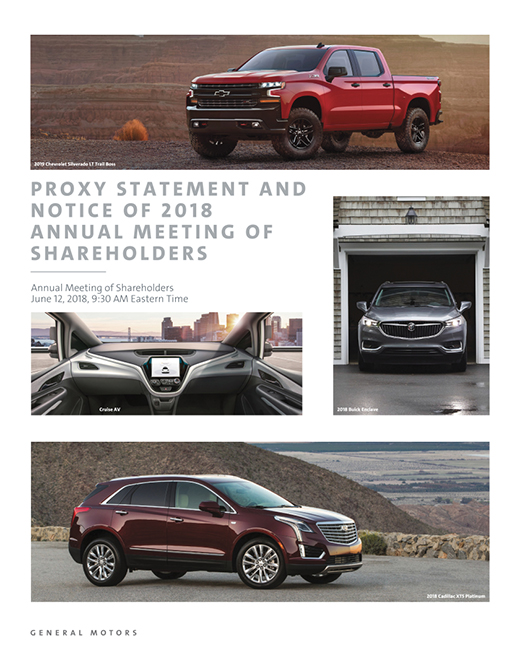

UNITED STATES
SECURITIES AND EXCHANGE COMMISSION
Washington, D.C. 20549
SCHEDULE 14A
Proxy Statement Pursuant to Section 14(a) of the Securities
Exchange Act of 1934
☑ Filed by the Registrant ☐ Filed by a Party other than the Registrant
Check the appropriate box: | ||
☐
| Preliminary Proxy Statement | |
☐
| CONFIDENTIAL, FOR USE OF THE COMMISSION ONLY (AS PERMITTED BY RULE 14a-6(e)(2)) | |
☑
| Definitive Proxy Statement | |
☐
| Definitive Additional Materials | |
☐
| Soliciting Material Pursuant to ss.240.14a-12 | |
GENERAL MOTORS COMPANY
(Name of Registrant as Specified In Its Charter)
(Name of Person(s) Filing Proxy Statement, if other than the Registrant)
Payment of Filing Fee (Check the appropriate box): | ||
☑ | No fee required. | |
☐ | Fee computed on table below per Exchange Act Rules 14a-6(i) | |
(1) Title of each class of securities to which transaction applies:
(2) Aggregate number of securities to which transaction applies:
(3) Per unit price or other underlying value of transaction computed pursuant to Exchange Act Rule 0-11 (set forth the amount on which the filing fee is calculated and state how it was determined):
(4) Proposed maximum aggregate value of transaction:
(5) Total fee paid:
| ||
☐ | Fee paid previously with preliminary materials. | |
☐ |
Check box if any part of the fee is offset as provided by Exchange Act Rule 0-11(a)(2) and identify the filing for which the offsetting fee was paid previously. Identify the previous filing by registration statement number, or the Form or Schedule and the date of its filing.
| |
(1) Amount Previously Paid:
(2) Form, Schedule or Registration Statement No.:
(3) Filing Party:
(4) Date Filed:
| ||



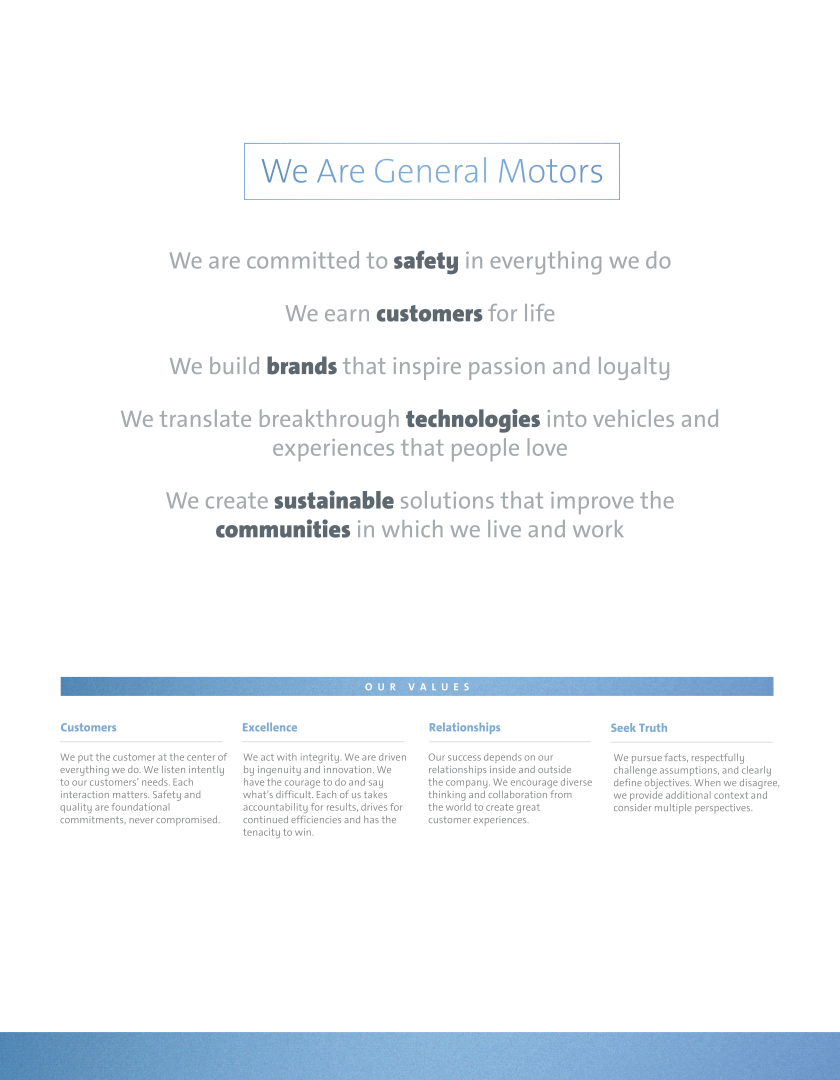
We are committed to safety in everything we do. We earn Customers for life. We build brands that inspire passion and loyalty. We translate breakthrough technologies into vehicles and experiences that people love. We create sustainable solutions that improve the communities in which we live and work.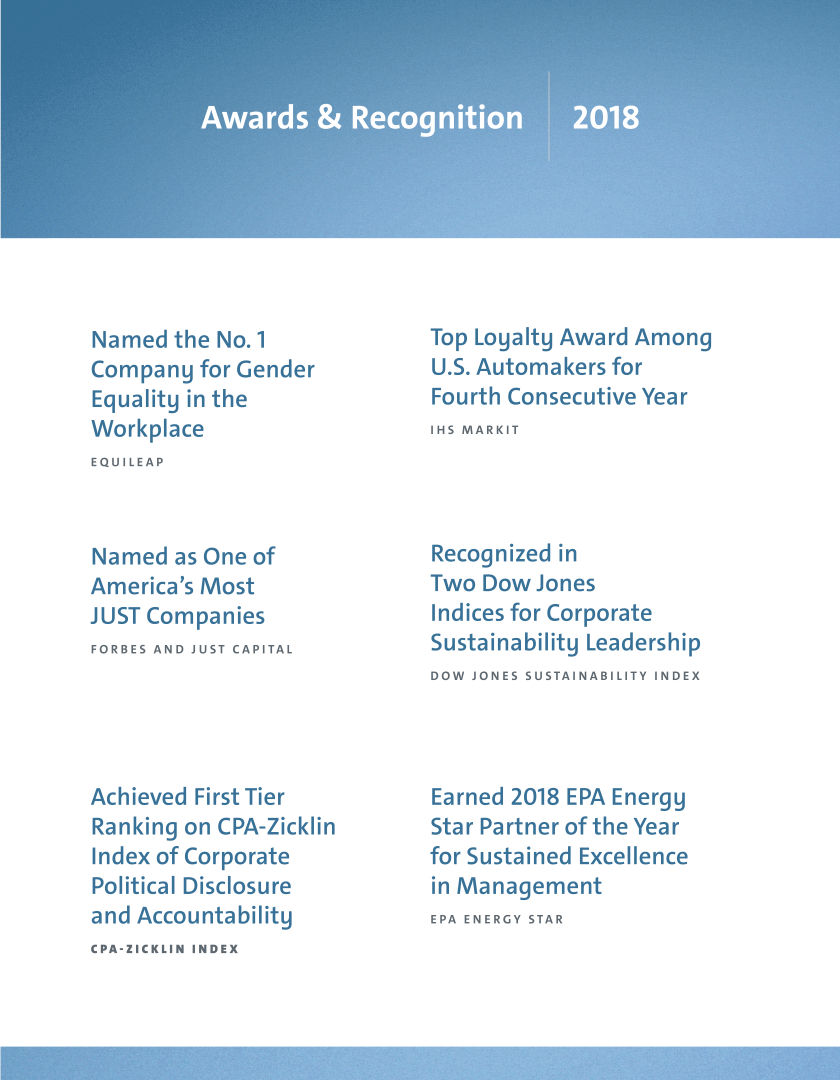

The Long-Term View:We Are General Motors:
A Conversation withAccelerating GM’s Strategic
and Cultural Transformation
Boardroom perspectives from Mary Barra and Tim Solso and Pat Russo
General Motors’ Chairman and CEO, Mary Barra, Independent Lead Director, Tim Solso, and Governance and Corporate Responsibility (“Governance”) Committee Chair, Pat Russo, discuss the Board’s approach to driving long-term shareholder value and the importance of meaningful shareholder engagement. They also explain why GM’s Board has the right mix of expertise, talent, and diversity to actively oversee the execution of GM’s strategy in this time of rapid industry change.
MARY T. BARRA
Chairman & |
THEODORE M. SOLSO
Independent Lead Director | |
| ||
How do you validate whether you are doing the right things for shareholders? Delivering value now and building for the future?
MARY:We have shared our strategy to transform GM, which is about driving excellence in our core business, while defining a future for mobility. We believe the best way to validate whether our approach is creating shareholder value is to deliver exceptional business results today while investing to lead in the future. By refocusing our finite resources during the past several years – including actions to either improve or exit underperforming businesses and to invest our capital in higher-return opportunities – we have achieved results that speak for themselves: three consecutive years of record financial performance. We have also made significant investments in technology and innovation that have positioned GM as a leader in the future of personal mobility. This view is shared by third parties like Navigant Research, which ranked GM as the leader in autonomous vehicle technology, ahead of 18 technology and automotive competitors.
What’s next? What steps areHow would you taking to increase shareholder value?describe GM’s purpose and vision?
MARY: We are a focused, more disciplined company. We will continueOur vision is to transform our core business, invest in key technologies that are enabling us to lead in the future of personal mobility, and deploy capital to higher-return opportunities. In 2017, GM announced its vision forcreate a world with zero crashes, zero emissions, and zero congestion. Today’s technologies give us a unique opportunity to make personal mobility better, safer, and more sustainable. Each year, more than one million people are killed in crashes around the world – 40,000 in the U.S. alone. When you consider that human error is behind more than 90% of these crashes, we believe autonomous vehicles (“AVs”) will save lives.
We are developingfully committed to anall-electric future, and we are already building on the technologies that will create this future, blending global insights with local market expertise as the automotive industry transforms from traditional manufacturing to transportation services.
The strong foundation and the increased flexibility we have created will enable us to take further actions – operational, financial, and technological – that we believe will deliver increased value for our shareholders.
The automobile industry is undergoing a period of profound change. How does the Board position GM to emerge as a leader?
TIM:The industry is changing quickly. Staying ahead means you have to be open to new ideas and invite input that challenges you with different thinking and perspectives. Our shareholder engagement process is an effective channel for the Board to hear these perspectives. Directors frequently meet with shareholders and can then bring shareholder views into the boardroom. During 2017, membersmomentum of the Board met in persongroundbreaking Chevrolet Bolt EV. In January, we announced that our Cadillac brand will lead the way on our next-generation electric vehicle (“EV”) technology. At the same time, we are improving the efficiency of today’s vehicles with shareholders representing approximately 25% of our outstanding common stock. We also invite large, long-term investors in GMlightweighting and sell-side research analysts to meet with the full Board to share their unfiltered views on an annual basis.
Shareholder engagement is invaluable because it gives us a first-hand perspective on what is important to our shareholders as we make strategic, financial,sophisticated new transmissions and operational decisions. Using this approach, the Board has worked closely with management in recent years as it executed a number of key strategic actions to transform our core business and lead inengines. To redefine the future of personal mobility. These includedtransportation, we must execute with speed and discipline, and I am confident we have the decision to exit unprofitable markets, such as Europe and South and East Africa, in favor of higher-return opportunities that include growing the Cruise Automation team and acquiring LiDAR provider Strobe, Inc.the technology to accelerate GM’s leadership in self-driving vehicle technology.
|

How do you assurethink about culture at GM?
MARY: Our culture will determine the long-term success of the Company. I’ve heard from many employees who feel that the Boardthey are part of something bigger and managementwho are aware of what’sexcited about making a positive impact on the horizon?world.
TIM:GM’s Board and leadership team are focused on new technologies and other emerging trends in the automotive industry. Management collaborates with internal and external experts across disciplines, from technology, cybersecurity, and design to regulatory and public policy, to assess opportunities and develop strategy. The Board is deeply engaged with management in these efforts. We also make it a priority to visit our global operations. Last April, we were in China, and this year, we visited our global propulsion headquarters and our research and development center and laboratories.
As you execute your plan, what are the elements that you believe are creating value?
MARY:We have been executingon a plancultural journey since 2014, when the ignition switch recall threatened our recovery from bankruptcy. At our senior leadership team meeting that has accelerated GM’s transformation and driven accountability acrossyear, we realized that to
transform our operations. Specifically,culture, we needed to address the underlying issues that were holding us back. So as a team we aligned ourselves around a shared set of behaviors built on our core values that continue to guide our actions today. Since that time, we have launched dozensintroduced various initiatives to create a workplace and culture in which our team members can thrive, yet be accountable for their performance.
TIM:Your Board of award-winning vehicles around the world; invested inDirectors (the “Board”) believes that culture is key technologies to unlock ourrealizing GM’s vision of zero crashes, zero emissions, and zero congestion; exited unprofitable markets; streamlinedcongestion. By sharing our operations with a relentless focus on cost; enhanced our capital structure;outside perspectives, your Board has helped GM reshape its behaviors and strengthened our financing arm for competitive advantage.
Our record results over the last three years reflect the magnitude of change we have initiated and our dedication to meeting our financial commitments. And through dividends and stock repurchases, we have returned more than $25 billion to our shareholders from 2012 through the end of 2017. We also outperformed our peers in Total Shareholder Return in 2017.ultimately, its culture, as it continues its transformation.
Why doIn November 2018, GM announced a comprehensive plan to accelerate its strategic transformation. Can you believe the current Board is the right one to deliver increased value for GM shareholders?discuss why you took these actions?
PAT:TIM:We believehave been navigating the current Board is composeddramatic changes facing our industry and taking decisive actions to stay in front of this change. Over the right people to guide us through this important period of industry change and opportunity. Our strategic plan is multidisciplinary and so is your Board. Our directors are all outstanding leaders – most with experience managing large, highly complex, global organizations – who effectively oversee the performance ofyears we have strengthened our core business as well asby deploying resources in regions and franchises where we see higher-return opportunities over the executionlong term.
MARY: Our focus all along has been to reposition the Company from one of management’s strategytrying to leadbe all things to all people in all markets to one that is strategic, agile, and profitable. By accelerating GM’s transformation, we can more rapidly invest in the future of personal mobility. Our transformation plan involves tough but necessary actions. We have members who understand evolving issues like technology, public policy,took these actions following significant feedback and international trade that are having a direct and increasingly important impact on our business. We also have directors with deep finance and capital markets expertise to provide guidance on optimal capital structure and effective capital allocation. With this expertise, your Board helps GM appropriately balance long-term investment with return of value to shareholders in the near term and navigate current and future risks.
Can you provide insight for shareholders on whatinput from the Board looks for– input that began during our annual strategic review in 2017 and continued throughout 2018. This is a new director?
PAT: We find potential candidates from a variety of sources, including search firms and shareholders as well as recommendations from directors and management,dynamic transformation process, and we take adding a new directorwill continue to your Boardseriously.Strategy-minded director recruitmentlook around corners and succession planning is criticalover the horizon to ensuringmake strategic decisions that your Board continues to protect shareholder valuestrengthen our business today and be a strategic assetposition it for the Company that is capable of addressing the evolving risks, trends, and opportunities that are around the corner at GM. We have a well-established process for director selection that is directly linked to the strategic needs of our business. The Governance Committee uses a carefully constructed skills matrix to review the experiences, qualifications, and attributes of current Board members and prospective candidates against the strategic needs of GM going forward to determine who can best help GM continue its momentum. Your Board also recognizes that refreshment brings both increased diversity and new perspectives, which are important components of a high-quality board. In fact, we added four new directors in the past three years as part of this comprehensive refreshment and recruitment process, including Devin N. Wenig, President and Chief Executive Officer of eBay Inc. (“eBay”), who brings considerable technology and consumer-facing experience to your Board.long-term success.
Since 2016, Mary has been both the Chairman and CEO. With the two roles now combined,What is the Board’s voice truly independent? Is the current Board leadership structure in the best interests of shareholders?GM doing to create a more sustainable future?
TIM:Your Board holds management accountable. Tenunderstands that for GM to remain acompelling investment opportunity, the Company must contribute to a safer, more sustainable future, particularly through continued efforts to reduce emissions from vehicles and facilities. GM is committed to anall-electric future as well as maintaining a sustainable supply chain. For example, in 2018, GM sourced 20% of its total power from renewable sources – leading the Board’s eleven directors are independentautomotive sector and together they haveprogressing towards our commitment to source 100% of our power from renewable sources by 2050.
MARY:We believe in the right mixscience of expertise to oversee, guide,climate change, and challengewe recognize that the leadership team. We are shaping and overseeing the Company’s strategy. Strategytransportation sector is a part of every Board meeting agenda,contributor to global greenhouse gas emissions. We have called on lawmakers to establish a National Zero Emission Vehicle program – a comprehensive approach to drive the scale and every yearinfrastructure investments needed to enable the Board holds a multiday session devoted exclusively to GM’s strategic plan. During these discussions, Board members engage in active debate and dialogue, challenge and validate management’s assumptions, and shape various aspects of management’s strategy and execution.
The Board does not believe there is a one-size-fits-all solution for board leadership structure or that combining or separating the Chairman and CEO roles is quite the black-and-white issue it is sometimes made out to be. Mary is the right personU.S. to lead your Board. GM’s performance under her leadership demonstrates that this structure is the most efficient way to execute our strategic planazero-emissions future – as well as enact complementary policies to spur market acceptance and create value for shareholders. It is important for shareholders to realize that the Board retains the flexibility to separate the positions at any time if circumstances change. On an annual basis, the Board carefully considers the appropriate leadership structure for GM and its shareholders and determines whether to combine or split these roles. In the past, the Board has decided that separating the rolescommercialization of Chairman and CEO would best serve shareholders, and in the future we may again, but we are confident that combining the roles is in the best interests of shareholders right now.EVs.
|
Notice of 20182019 Annual Meeting of Shareholders
April 27, 201818, 2019
Dear Fellow Shareholder:
The Board of Directors of General Motors Company (“General Motors,” “GM,” the “Company,“the Company,” “we,” and “our”) cordially invites you to attend the 20182019 Annual Meeting of Shareholders (the “Annual(“Annual Meeting”) to be held on June 12, 2018,4, 2019, at the General Motors Global Headquarters, 300 Renaissance Center, Detroit, Michigan 48265. 8:00 a.m. Eastern Time.
The Annual Meeting will be conducted online only, via live video webcast. You will be able to attend the meeting exclusively online and submit questions before and during the meeting by visiting gm.onlineshareholdermeeting.com. You will also be able to vote your shares electronically during the meeting. Details about how to attend the Annual Meeting online and how to submit questions and cast your votes are provided under “Important Information About GM’s Online Annual Meeting” on the next page and “General Information About the Annual Meeting” on page 78. |
At the Annual Meeting, you will be asked to:
| u | Elect the 11 Board-recommended director nominees named in this Proxy Statement; |
| u | Approve, on an advisory basis, |
| u | Ratify the selection of Ernst & Young LLP as the Company’s independent registered public accounting firm for |
| u | Vote on |
| u | Transact any other business that is properly presented at the meeting. |
Record DateDate:
If you were a holder of record of GM common stock at the close of business on April 16, 2018,8, 2019, you are entitled to vote at the Annual Meeting. A list of registered shareholders will be available for examination for any purpose that is germane to the meeting at GM’s Global Headquarters in Detroit, Michigan, for 10 business days before the Annual Meeting between 9:00 a.m. and 5:00 p.m. Eastern time, and also during the Annual Meeting.
This Proxy Statement is provided in conjunction with GM’s solicitation of proxies to be used at the Annual Meeting. In addition to this Proxy Statement and proxy card or voting instruction form, the GM 20172018 Annual Report on Form10-K is provided in this package or is available on the Internet.internet.
Thank you for your interest in General Motors Company.
By Order of the Board of Directors,
Rick E. Hansen
Assistant General Counsel and Corporate Secretary
General Motors Company
Meeting Information:
| ||||||
Date: June
Time:
Place:
| ||||||
Your vote is important.
| ||||||
Please promptly submit your vote by
We are first mailing these proxy materials to our shareholders on or about April
| ||||||
How You Can Access the Proxy Materials Online:
| ||||||
Important Notice Regarding the Availability of Proxy Materials for the
Our Proxy Statement and
|
 | ii |
Important Information About GM’s Online Annual Meeting
GM’s 2019 Annual Meeting will be conducted online only, via live video webcast. If you were a holder of record of GM common stock at the close of business on April 8, 2019, you are entitled to participate in the annual meeting on June 4, 2019. Below are some frequently asked questions regarding the new online format for our Annual Meeting.
Patricia F. Russo Governance and Corporate Responsibility Committee Chair | Why did the Board decide to adopt an online format for the 2019 Annual Meeting? “Your Board believes the online format will enhance attendance by providing convenient meeting access to all of our shareholders, regardless of where they live – not just those shareholders who have the time and means to travel to anin-person meeting. Over the past five years, attendance at our Annual Meeting has averaged less then 35 shareholders. This year, even shareholders without an internet connection or a computer will be able to listen to the meeting by calling a toll-free telephone number. In addition, we believe the online format will provide a better opportunity for shareholders to communicate with your Board by submitting questions before and during the meeting through the online portal and by calling in live via telephone during the meeting. Finally, the online meeting format will also eliminate many of the costs associated with holding a physical meeting, which is a smart choice for GM and its shareholders. We look forward to increasing participation this year while lowering operating costs for the Company.” |
uHow can I view and participate in the Annual Meeting? To participate, visitgm.onlineshareholdermeeting.com and login with your16-digit control number included in your proxy materials. uWhen can I join the Annual Meeting online? You may begin to log into the meeting platform beginning at 7:45 a.m. Eastern Time on June 4, 2019. The meeting will begin promptly at 8:00 a.m. Eastern Time on June 4, 2019. uHow can I ask questions and vote? We encourage you to submit your questions and vote in advance by visitingproxyvote.com. Shareholders will also be permitted to ask questions by telephone during the meeting (subject to time restrictions). Shareholders may also vote and submit questions online in advance of and during the meeting. To participate in the meeting webcast visitgm.onlineshareholdermeeting.com. |
COMMITMENT TO TRANSPARENCY If there are questions pertinent to meeting matters that cannot be answered during the Annual Meeting due to time constraints, management will post answers to a representative set of such questions atinvestor.gm.com/shareholder. The questions and answers will be available as soon as practicable after the meeting and will remain available until GM’s 2020 Proxy Statement is filed. | ||||||
uWhat if I lost my 16-digit control number? You will be able to login as a guest. To view the meeting webcast visitgm.onlineshareholdermeeting.com and register as a guest. You will not be able to vote your shares or submit questions during the meeting. uWhat if I don’t have internet access? Please call (877) 328-2502 (toll free) or (412) 317-5419 (international) to listen to the meeting proceedings. You will not be able to vote your shares during the meeting. uWhat if I experience technical difficulties? Please call (800) 586-1548 (U.S.) or (303) 562-9288 (International) for assistance. uWhere can I find additional information? For additional information about how to attend the Annual Meeting, please see “General Information About the Annual Meeting” on page 78. uWhat if I have additional questions? You may contact GM Shareholder Relations atshareholder.relations@gm.com or (313) 667-1432 for assistance. |
| iii |
|
Cautionary Note on Forward-Looking Statements: This Proxy Statement contains “forward-looking” statements regarding GM’s current expectations within the meaning of the applicable securities laws and regulations. These statements are subject to a variety of risks and uncertainties that could cause actual results to differ materially from expectations. These risks and uncertainties include, but are not limited to, the risks detailed in GM’s filings with the Securities and Exchange Commission, including the “Risk Factors” section of GM’s Annual Report on Form 10-K for the fiscal year ended December 31, 2018. We assume no obligation to update any of these forward-looking statements. |
 | iv |
This summary highlights information contained elsewhere in this Proxy Statement. It does not contain all of the information that you should consider. Please read the entire Proxy Statement carefully before voting.
Agenda and Voting Recommendations
Proposal | Board Vote Recommendation | Page Reference | ||||
| ||||||
Item No. 1– Election of Directors
|
FOR
|
|
|
| ||
Item No. 2– Approval of, on an Advisory Basis,
| FOR | |||||
Item No. 3– Ratification of the Selection of
| FOR | |||||
SHAREHOLDER PROPOSALS:
| ||||||
Item No. 4– Independent Board Chairman
|
AGAINST
|
|
|
| ||
Item No. 5– |
|
| ||||
|
AGAINST
|
|
76
|
| ||


Composition of Board Nominees

WE HAVEGM HAS THE RIGHT BOARD AT THE RIGHT TIME FOR GM TheTIMEThe Board and management are overseeing a period of strategic and cultural transformation at GM amidst a period of unprecedented change at GM.in the automotive and mobility industries. Ensuring the Board is composed of directors who bring diverse viewpoints and perspectives, exhibitpossess a variety of skills, professional experience, and backgrounds, and effectively represent the long-term interests of shareholders is a top priority of your Board and the Governance Committee.and Corporate Responsibility Committee (the Governance Committee). Our membership criteria and director recruitment initiativesprocedures align the Board’sBoards capabilities with the execution of the Company’sCompanys business strategy. The Board recognizes the need for refreshment to bring new perspectives, keeping in mind our commitment to diversity. In fact, we added four new directors in the past three years asAs part of our comprehensive refreshment and recruitment process, keeping in mind our commitment to diversity, we added six new directors in the past four years, including Mr. Wenig, Presidentsince our last annual meeting Ms. Miscik, Vice Chairman and Chief Executive Officer ("CEO") of eBay.Kissinger Associates, Inc., and Mr. Bush, Chairman of Northrop Grumman Corporation. These new directors complementedcomplement our directors’current directors mix of skills by bringing to the Board key leadership, technology, consumer-facing and capital marketsmanufacturing expertise to the Board.as well as experience navigating geopolitical and macroeconomic risks. For a detailed discussion of why we haveGM has the right Board for GM,at the right time, please see “ItemItem No. 1—Election1Election of Directors”Directors on page 7.["].
Composition of Board Nominees

AGE OF DIRECTORS GENDER DIRECTOR TENURE DIRECTOR INDEPENDENCE
 | 1 |
PROXY STATEMENT SUMMARY
The following table provides summary information about each director nominee. For more detailed information about our directors, please see “Item No. 1—Election of Directors—Your Board’s Nominees for Director” on page 10.11.
| Name | Age | Director Since | Principal Occupation | Independent | Committee Memberships | Age | Director Since | Principal Occupation | Independent | Committee Memberships | ||||||||||
Mary T. Barra | 56 | 2014 | Chairman & Chief Executive Officer, General Motors Company | Executive – Chair | 57 | 2014 |
Chairman & | Executive – Chair | ||||||||||||
Theodore M. Solso | 71 | 2012 | Independent Lead Director, General Motors Company, and Retired Chairman & Chief Executive Officer, Cummins, Inc. |  | Executive | 72 | 2012 |
Independent Lead Director, |  | Executive | ||||||||||
Wesley G. Bush | 58 | 2019 |
Chairman, Northrop Grumman |  | Executive Compensation Finance | |||||||||||||||
Linda R. Gooden | 65 | 2015 | Retired Executive Vice President, Information Systems & Global Solutions, Lockheed Martin Corporation |  | Audit Cybersecurity – Chair Executive Risk | 66 | 2015 |
Retired Executive Vice President, |  | Audit Cybersecurity – Chair Executive Risk | ||||||||||
Joseph Jimenez | 58 | 2015 | Retired Chief Executive Officer, Novartis AG |  | Executive Compensation Governance | 59 | 2015 |
Retired Chief Executive Officer, |  | Executive Compensation Governance | ||||||||||
Jane L. Mendillo | 59 | 2016 | Retired President & Chief Executive Officer, Harvard Management Company |  | Finance Audit | 60 | 2016 |
Retired President & |  | Finance Audit | ||||||||||
Admiral Michael G. Mullen | 71 | 2013 | Former Chairman, Joint Chiefs of Staff |  | Audit Cybersecurity Executive Risk – Chair | |||||||||||||||
James J. Mulva | 71 | 2012 | Retired Chairman & Chief Executive Officer, ConocoPhillips |  | Executive Executive Compensation Finance – Chair Risk | |||||||||||||||
Judith A. Miscik | 60 | 2018 |
Chief Executive Officer & |  | Risk Audit | |||||||||||||||
Patricia F. Russo | 65 | 2009 | Chairman, Hewlett Packard Enterprise Company |  | Executive Executive Compensation Finance Governance – Chair | 66 | 2009 | Chairman, Hewlett Packard Enterprise Company |  |
Executive Executive Compensation Finance Governance – Chair | ||||||||||
Thomas M.Schoewe | 65 | 2011 | Retired Executive Vice President & Chief Financial Officer, Wal-Mart Stores, Inc. |  | Audit –Chair Cybersecurity Executive Finance Risk | 66 | 2011 | Retired Executive Vice President & Chief Financial Officer, Wal-Mart Stores, Inc. |  |
Audit – Chair Cybersecurity Executive Finance Risk | ||||||||||
Carol M. Stephenson | 67 | 2009 | Retired Dean, Ivey Business School, The University of Western Ontario |  | Executive Executive Compensation – ChairGovernance | 68 | 2009 |
Retired Dean, Ivey Business |  | Executive Executive Compensation – Chair Governance | ||||||||||
Devin N. Wenig | 51 | 2018 | President & Chief Executive Officer, eBay Inc. |  |
Committee memberships to be determined at the Board’s June 2018 meeting
| 52 | 2018 |
President & Chief Executive Officer, eBay Inc. |  |
Risk
| ||||||||||
| 2 |
|
PROXY STATEMENT SUMMARY
We recognize that strong corporate governance contributes to long-term shareholder value. We are committed to sound governance practices, including those described below.
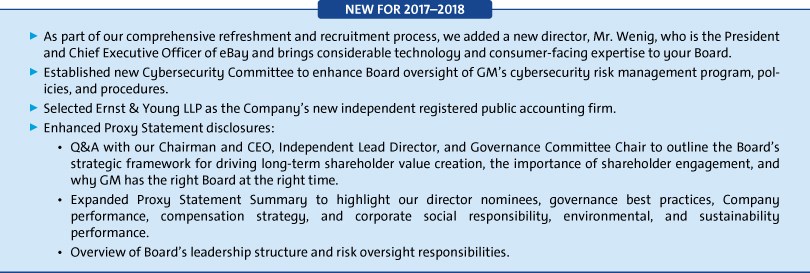
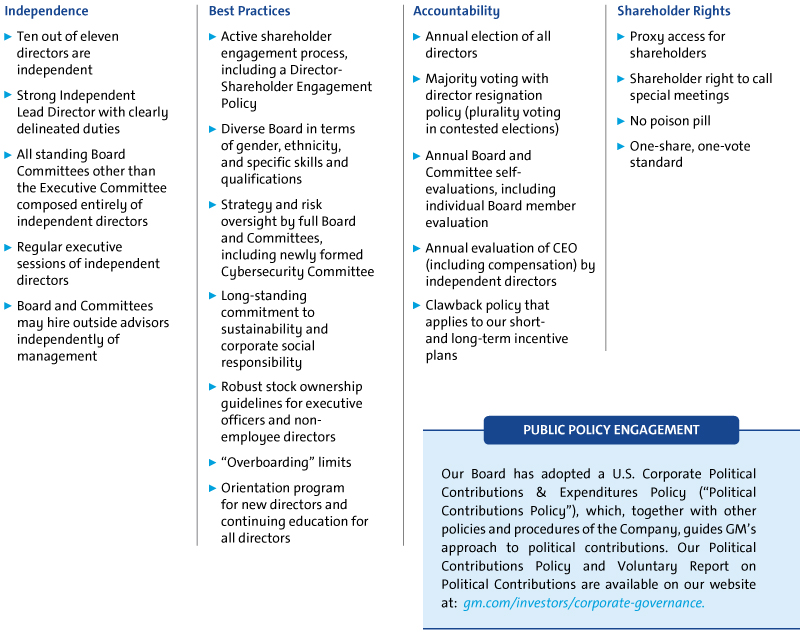
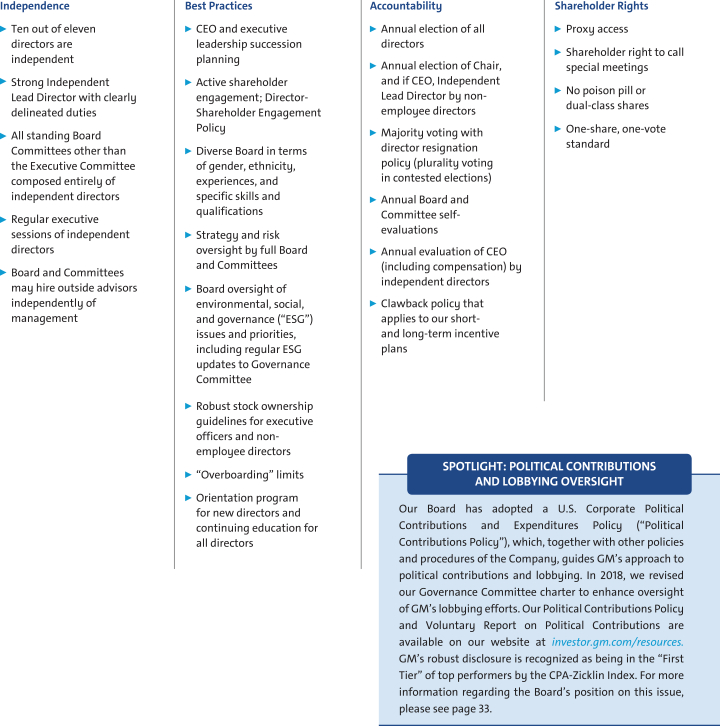
Independence [Ten]Ten out of [eleven]eleven directors are independent Strong Independent Lead Director with clearly delineated duties All standing Board Committees other than the Executive Committee composed entirely of independent directors Regular executive sessions of non-managementindependent directors Board and Committees may hire outside advisors independently of management Best Practices CEO and executive leadership succession planning Active shareholder engagement process, including aengagement; Director-Shareholder Engagement Policy Diverse Board in terms of gender, ethnicity, and specific skills and qualifications Strategy and risk oversight by full Board and Committees (see page ["] for the Risk Committees 2019 risk areas of focus) Board oversight of ESG issues and priorities, including newly formed Cybersecurityregular ESG updates to Governance Committee Long-standing commitment to sustainability and corporate social responsibility Robust stock ownership guidelines for executive officers and non-employee directors “Overboarding”Overboarding limits Orientation program for new directors and continuing education for all directors Accountability Annual election of all directors Annual election of Chair, and if CEO, Independent Lead Director by non-employee directors Majority voting with director resignation policy (plurality standard to applyvoting in contested elections) Annual Board and Committee self-evaluations including individual Board member evaluation Annual evaluation of CEO (including compensation) by independent directors clawbackClawback policy that applies to our short- andshort-and long-term incentive plans Shareholder Rights Proxy access for shareholders Shareholder right to call special meetings No poison pill or dual-class shares One-share, one-vote standard Public Policy EngagementSPOTLIGHT: POLITICAL CONTRIBUTIONS AND LOBBYING OVERSIGHT Our Board has adopted a U.S. Corporate Political Contributions &and Expenditures Policy (Political Contributions Policy), which, together with other policies and procedures of the Company, guides GM’sGMs approach to political contributions.contributions and lobbying. In 2018, we revised our Governance Committee charter to enhance oversight of GMs lobbying efforts. Our Political Contributions Policy and Voluntary Report on Political Contributions are available on our website at gm.com/investors/corporate-governance.html. NEW FOR 2017–2018 As partinvestor.gm.com/resources. GMs robust disclosure is recognized as being in the First Tier of our comprehensive refreshmenttop performers by the CPA-Zicklin Index. For more information regarding the Boards position on this issue, see page ["]. environmental, social, and recruitment process, we added a new director, Mr. Wenig, who is the President and Chief Executive Officer of eBay and brings considerable technology and consumer-facing expertise to your Board. Established new Cybersecurity Committee to enhance Board oversight of GM’s cybersecurity risk management program, policies, and procedures. Selected Ernst & Young LLP as the Company’s new independent registered public accounting firm. Enhanced Proxy Statement disclosures: Q&A with our Chairman and CEO, Independent Lead Director, and Governance Committee Chair to outline the Board’s strategic framework for driving long-term shareholder value creation, the importance of shareholder engagement, and why GM has the right Board at the right time. Expanded Proxy Statement Summary to highlight our director nominees, governance best practices, Company performance, compensation strategy, and corporate social responsibility, environmental, and sustainability performance. Overview of Board’s leadership structure and risk oversight responsibilities.("ESG") please
 | 3 |
PROXY STATEMENT SUMMARY
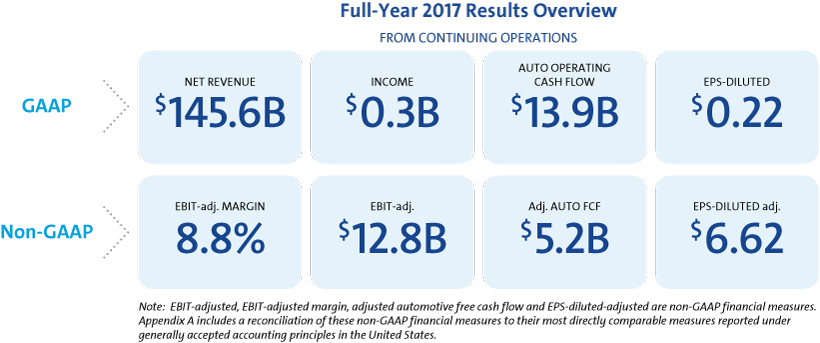
Full-Year 2018 Results Overview
GAAP vs. 2017 Non-GAAP vs. 2017 Net Revenue $147.0 B + 1.0 % EBIT-adj. Margin 8.0% (0.8) pts Income $8.1 B + 2,347 % EBIT-adj. $11.8 B (8.3) % EPS-Diluted $5.58 + 2,436% EPS-Diluted-adj. $6.54 (1.2) % Auto Operating Cash Flow $11.7 B $(2.6) B Note: The financial information above and included in this Proxy Statement relates to our continuing operations and not our discontinued operations, which consist of the Opel and Vauxhall businesses and certain other assets in Europe and the European financing subsidiaries and branches that were sold in 2017. EBIT-adjusted, EBIT-adjusted margin and EPS-diluted-adjusted are non-GAAP financial measures. Appendix A includes a reconciliation of these non-GAAP financial measures to their most directly comparable measures reported under generally accepted accounting principles in the United States. |
A Year of Transformation
Sweeping change accompanied record performance at General Motors Takes Shape in 2017. To continue focusing resources on its most profitable franchises, GM sold its Opel/Vauxhall and GM Financial European operations, and exited South and East Africa, and India. To advance its vision of a zero emissions world, GM laid out plans to introduce at least 20 newall-electric2018 vehicles that will launch by 2023. The Company also recently filed a Safety Petition asking the U.S. Department of Transportation to allow GM to safely deploy its fourth-generation self-driving Cruise AV on public roads. This vehicle eliminates the steering wheel, pedals, and other unnecessary manual controls. GM expects to deploy self-driving vehicles at scale in a dense urban environment in 2019.
“The actions we took to further strengthen our core business and advance our vision for personal mobility made 2017 a
u GM reported strong full-year 2018 earnings driven by strong pricing, surging crossover sales, successful execution of the Company’s light-duty full-size truck launch, growth of GM Financial earnings, and disciplined cost control. u In November 2018, the Company announced steps to align its product portfolio and capacity in North America with changed consumer preferences and transform its workforce to position the Company for long-term success. u GM introduced the first production-ready autonomous vehicle built to operate safely with no driver or manual controls. GM Cruise has secured commitments of more than $5 billion from external investors who are attracted to Cruise’s integrated approach to software and hardware development. u GM Financial had record full-year earnings and revenue performance in 2018. u In the U.S., GM delivered nearly 3 million vehicles, helped by crossover sales that topped 1 million for the year. Average transaction prices (“ATPs”) were a record of nearly $36,000, while incentives as a percent of ATPs fell 0.3% year over year. transformative We will continue executing our plan and reshaping our company to position it for long-term success.”–Mary Barra, Chairman & CEOShareholder ReturnGM returned $6.7 billion to shareholders in 2017 through share buybacks of $4.5 billion and dividends of $2.2 billion. Since 2012, GM has returned more than $25 billion, which represents more than 90% of available free cash flow generated over that time.
COMPARISON OF CUMULATIVE TOTAL RETURN
Cumulative Value of $100 Investment Through December 31, 20172018

J.D. Power Awards
Chevrolet was J.D. Power’s most awarded brand in 2017, as six different Chevrolet cars, trucks, and SUVs won a total of nine awards in J.D. Power’s 2017 Vehicle Dependability, Initial Quality, and APEAL Studies. Chevrolet also earned high marks in the 2018 J.D. Power Customer Service Index (“CSI”) Study and the 2017 Sales Satisfaction Index (“SSI”) Survey. In addition, Buick and Chevrolet led the way as the two General Motors brands earning six awards and delivering more Top Three segment model rankings than any other company in the J.D. Power and Associates 2018 U.S. Vehicle Dependability Study.

“GM delivered another strong year of earnings in a highly volatile environment in 2018. We will continue to make bold decisions to lead the transformation of this industry and drive significant shareholder value.” – Mary Barra, Chairman & CEO GAAP NET REVENUE $145.6B INCOME $0.3B AUTO OPERATING CASH FLOW $13.9B EPS-DILUTED $0.22 Non-GAAP EBIT-adj. MARGIN 8.8% EBIT-adj. $12.8B Adj. AUTO FCF $5.2B EPS-DILUTED adj. $6.62 Note: EBIT-adjusted, EBIT-adjusted margin, adjusted automotive free cash flow andEPS-diluted-adjusted arenon-GAAP financial measures. Appendix A includes a reconciliation of thesenon-GAAP financial measures to their most directly comparable measures reported under accounting principles generally accepted in the United States.
4 

PROXY STATEMENT SUMMARY
Our Capital Allocation Framework
Your Board takes its role as the steward of your capital seriously. As a result, your Board has worked closely with management to establish a disciplined and transparent Capital Allocation Framework designed to drive long-term shareholder value. The Framework consists of the following three pillars:

Reinvest to Drive Growth Maintain Investment Grade Balance Sheet Return Available Cash to Shareholders (Target Opportunities with 20%+ ROIC-adj.) ($18 billion average target cash balance) (Through dividends and share repurchases)
Capital Allocation Oversight: Strategic Transformation
Your Board, together with its Finance and Audit Committees, oversees GM’s critical capital allocation decisions, including establishing and maintaining the dividend rate, pursuing strategic investments, approving medium- and long-term capital plans, and maintaining GM’s overall liquidity. In November 2018, GM announced proactive steps to improve its overall business performance by driving cost efficiencies, lowering capital expenditures, and realigning manufacturing capacity with changed consumer preferences. These actions not only are expected to result in significantly improved adjusted automotive free cash flow by the end of 2020, but also will enable GM to allocate more resources to the future of mobility over the next two years. Your Board worked with management to ensure that this strategic transformation was undertaken in accordance with our Capital Allocation Framework, including by securing a $3 billion revolving credit facility to maintain liquidity and financial flexibility while funding immediate transformation costs. Your Board believes that over the long term, these bold decisions will enable GM to generate additional cash to fund reinvestment in higher-return growth opportunities, maintain a healthy balance sheet, and return additional cash to shareholders.
Reinvesting to Drive Growth and Returning Available Cash to Shareholders
Since 2011, GM has returned more than $25 billion to shareholders through dividends and share repurchases, while continuing to make investments in higher-return opportunities that have enhanced our ability to lead in the future of mobility and strengthened our core business. Key investments include GM’s 2016 decisions to invest in the ride-sharing company Lyft, Inc., (“Lyft”) and acquire Cruise Automation, Inc. The latter is now our subsidiary tasked with the development and commercialization of our AV technology. These strategic investments have been validated as our investment in Lyft has appreciated and Cruise has attracted $5 billion in external capital commitments.
 | 5 |
PROXY STATEMENT SUMMARY
Executive Compensation Highlights
We provide highlights of our compensation program below. Please review our Compensation Discussion and Analysis beginning on page 38 and compensation-relatedthe accompanying compensation tables beginning on page 3558 of this Proxy Statement for a complete understandingdiscussion of our compensation program.


|
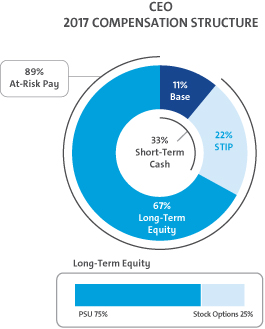 |  |
|
| Name | Salary ($) | Bonus ($) | Stock Awards ($) | Option Awards ($) | Nonequity Incentive Plan Compensation ($) | Change in Pension Value and NQ Deferred Compensation Earnings ($) | All Other Compensation | Total ($) | ||||||||||||||||||||||||
Mary T. Barra
|
|
2,100,000
|
|
|
—
|
|
|
10,737,570
|
|
|
3,250,003
|
|
|
4,956,000
|
|
|
52,792
|
|
|
861,683
|
|
|
21,958,048
|
| ||||||||
Charles K. Stevens, III
|
|
1,100,000
|
|
|
—
|
|
|
3,076,744
|
|
|
931,251
|
|
|
1,622,500
|
|
|
54,114
|
|
|
316,430
|
|
|
7,101,039
|
| ||||||||
Daniel Ammann
|
|
1,450,000
|
|
|
—
|
|
|
4,078,222
|
|
|
1,234,378
|
|
|
2,138,800
|
|
|
—
|
|
|
356,918
|
|
|
9,258,318
|
| ||||||||
Mark L. Reuss
|
|
1,200,000
|
|
|
—
|
|
|
3,345,168
|
|
|
1,012,504
|
|
|
1,770,000
|
|
|
54,390
|
|
|
344,446
|
|
|
7,726,508
|
| ||||||||
Alan S. Batey
|
|
1,025,000
|
|
|
—
|
|
|
2,224,928
|
|
|
673,426
|
|
|
1,447,800
|
|
|
316,601
|
|
|
287,373
|
|
|
5,975,128
|
| ||||||||
Karl-Thomas Neumann
|
|
916,936
|
|
|
2,000,000
|
|
|
1,961,676
|
|
|
593,751
|
|
|
1,276,317
|
|
|
126,796
|
|
|
12,563
|
|
|
6,888,039
|
| ||||||||
Note: For additional information on the table above, please see the Summary Compensation Table in “Executive Compensation” on page 57.
CEO 2017 COMPENSATION STRUCTURE AVERAGE NEO 2017 COMPENSATION STRUCTURE COMPENSATION PROGRAM EVOLUTION AND ENHANCEMENTS IN 2017 Since 2013,THROUGH 2018Since 2014, we have taken significant actionsaction to simplify and align our compensation programs with shareholders’shareholders interests by focusing our leaders on the key areas that both drive the business forward and align to the short-term and long-term interests of our shareholders. Forshareholders.For short-term incentive compensation, we maintained focus on key financial measures and individual performance results for each NEO.For the long-term incentive compensation, we remained consistent with granting Stock Options and Performance Share Units for each NEO. Our Stock Options focus leaders on absolute stock price appreciation and PSUs measure our performance against other OEMs for ROIC-adjusted and TSR.For anin-depth discussion of how weour compensation programs have evolved, our programs, including in response to active shareholder engagement, see “Executive Compensation—Compensation Overview—ShareholderExecutive CompensationCompensation OverviewShareholder Engagement Initiatives”Initiatives on page 38. Key 2017 Enhancements: For short-term incentive compensation, we increased focus["] (PSUs) original equipment manufacturers Return on key financial measures and added an individual performance element to incorporate individual performance goals for each NEO. For long-term incentive compensation, we eliminated time-vested restricted stock units and replaced them with Stock Options and incorporated relative performance measures into the performance stock units.Invested Capital-adjusted Total Shareholders Return
Performance-Based Compensation Structure
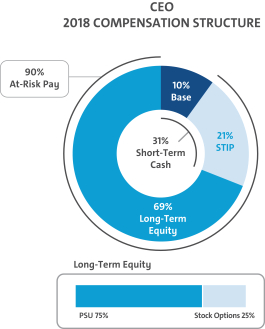 |  |
CEO 2018 COMPENSATION STRUCTURE90% At-Risk Pay 10% Base 31% Short-Term Cash 21% STIP 69% Long-Term Equity Long-Term Equity PSU 75% Stock Options 25%AVERAGE NEO 2018 COMPENSATION STRUCTURE82% At-risk Pay 18% Base 41% Short-Term Cash 23% STIP 59% Long-Term Equity Long-Term Equity PSU 75% Stock Options 25%
2018 Summary Compensation Snapshot
| Name | Salary ($) | Bonus ($) | Stock Awards ($) | Option Awards ($) | Nonequity Incentive Plan Compensation ($) | Change in Pension Value and NQ Deferred Compensation Earnings ($) | All Other Compensation ($) | Total ($) | ||||||||||||||||||||||||
Mary T. Barra |
|
2,100,000 |
|
|
— |
|
|
11,081,760 |
|
|
3,425,006 |
|
|
4,452,000 |
|
|
— |
|
|
811,684 |
|
|
21,870,450 |
| ||||||||
Dhivya Suryadevara |
|
668,100 |
|
|
— |
|
|
2,446,635 |
|
|
796,263 |
|
|
1,192,500 |
|
|
— |
|
|
402,592 |
|
|
5,506,090 |
| ||||||||
Daniel Ammann |
|
1,450,000 |
|
|
— |
|
|
3,993,891 |
|
|
1,234,383 |
|
|
1,921,300 |
|
|
— |
|
|
372,307 |
|
|
8,971,881 |
| ||||||||
Mark L. Reuss |
|
1,200,000 |
|
|
— |
|
|
3,276,007 |
|
|
1,012,504 |
|
|
1,590,000 |
|
|
— |
|
|
277,579 |
|
|
7,356,090 |
| ||||||||
Alan S. Batey |
|
1,025,000 |
|
|
— |
|
|
2,178,894 |
|
|
673,429 |
|
|
1,230,000 |
|
|
— |
|
|
233,197 |
|
|
5,340,520 |
| ||||||||
Charles K. Stevens, III |
|
1,100,000 |
|
|
— |
|
|
3,255,775 |
|
|
1,006,252 |
|
|
1,320,000 |
|
|
— |
|
|
257,153 |
|
|
6,939,180 |
| ||||||||
Note: For additional information on the table above, please see the Summary Compensation Table in “Executive Compensation” on page 58.
|
|
PROXY STATEMENT SUMMARY
Environmental and Sustainability Performance

PROGRESS TOWARD OUR VISIONGM continues to work toward its vision of Zero Crashes. Zero Emissions. Zero Congestion. Were doing so through the integration of sustainability into every part of our business all under the purview of our Board of Directors Governance and Corporate Responsibility Committee whose members review progress at every Board meeting. 3.5XOur AVs drove 3.5 times more miles in 2018 than in 2017. That underscores the tremendous progress were making toward the commercial introduction of AVs a key part of our Zero Crashes vision. We also secured commitments for more than $5 billion of external investment in our AV subsidiary, Cruise Automation, demonstrating the level of confidence in our vision.MEMBER OF Dow Jones Sustainability Indices In Collaboration with RobecoSAM#1 GM ranks first on Equileaps 2018 Gender Equality in the Workplace. Among the reasons: We are one of just two global businesses that has pay equality in top, middle and bottom bands as well as no overall gender pay gap across the company.2 We introduced two new EVs in China, the worlds largest new energy vehicle market, this year; were committed to 20 new EVs by 2023. In the U.S., Cadillac will be our lead brand for electrification technologies, and 75% of our engineering force will be focused on clean energy technologies.1.4 MillionIn 2018, Maven electric drives saved 1.4 million gallons of gas. Our visioncar-sharing platform is not only providing new approaches to personal mobility, but also helping to promote EVs by placing them in high-mileage, shared-use fleets.20%In 2018, 20% of our global electricity needs were met by renewable energy well on the way to our commitment of 100% by 2050.XX,000We continued to hire more than XX STEM positions in 2018 that equates to approximately one every 26 minutes, emphasizing our focus on attracting and retaining the top talent in the fields of connectivity, autonomous and artificial intelligence technologies. 43%Research by the The Insurance Institute for Highway Safety has found that GM vehicles with autobrake and forward collision warning were involved in 43% fewer crashes compared to the future can be summed up withsame vehicles without those features.1stWe are the first automotive company to commit to sourcing sustainable natural rubber for tires in order to mitigate deforestation and its effects on climate change. 20% Weve reduced our manufacturing carbon intensity since 2010 three numbers:zero crashes,zero emissions, andzero congestion.years ahead of goal. the by 20%
 | 7 |
|
| |||||||||
|
|
|

CUSTOMER-DRIVEN SUSTAINABILITY Putting the customer at the center of everything we do extends both to how we build our products and to how we serve and improve our communities. When it comes to sustainability, we pursue a future that creates value for all of our stakeholders.
|
ITEM NO. 1 – ELECTION OF DIRECTORS


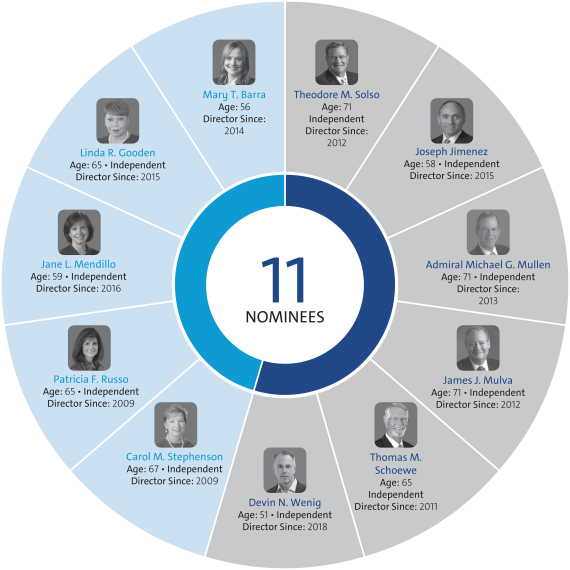

SUMMARY AtSUMMARYAt the 20182019 Annual Meeting, 11 directors will be elected. The Governance Committee evaluated the nominees in accordance with the Committee’sCommittees charter and our Corporate Governance Guidelines and submitted the nominees to the full Board for approval. On April 17, 2018,Other than Judith A. Miscik and Wesley G. Bush, all of the nominees were elected to the Board elected Mr. Wenig as a member of the Board. All of the other nominees are current GM Board members who were elected by shareholders at the 20172018 Annual Meeting. Ms. Miscik was elected to the Board effective October 8, 2018, and Mr. Bushs was elected to the Board effective February 11, 2019.
Overview of Your Board Nominees
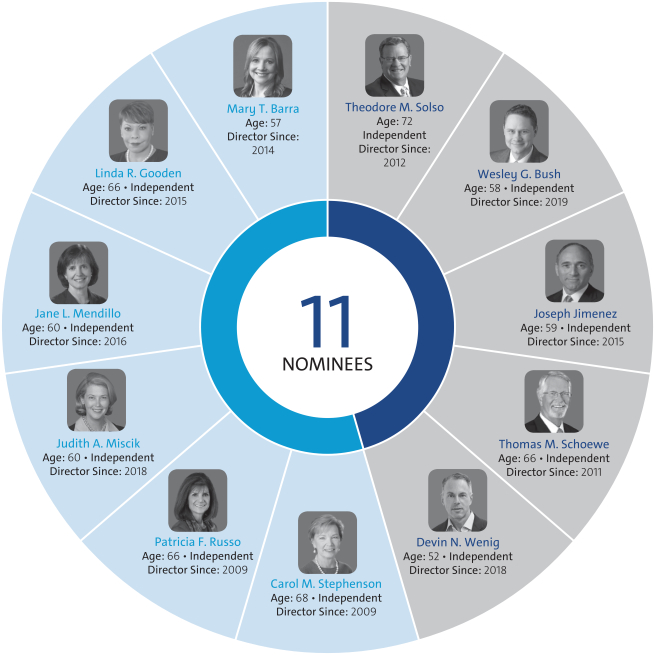
Mary T. Barra Age: 57 Direct Since: 2014Theodore M. Solso Age: 72 Independent Director Since: 2012 Wesley G. Bush Age: 58 Independent Director Since: 2019 Joseph Jimenez Age: 59 Independent Director since: 2015 Thomas M. Schoewe Age: 66 Independent Director Since: 2011 Devin N. Wenig Age: 52 Independent Director Since: 2018Carol M. Stephenson Age: 68 Independent Director Since: 2009 Patricia F. Russo Age: 66 Independent Director Since: 2009 Judith A. Miscik Age: 61 Independent Director Since: 2018 Jane L Mendillo Age: 60 Independent Director Since: 2016Linda R. Gooden Age : 66 Independent Director Since: 2015 11 NOMINEES
|
|
ITEM NO. 1 – ELECTION OF DIRECTORS
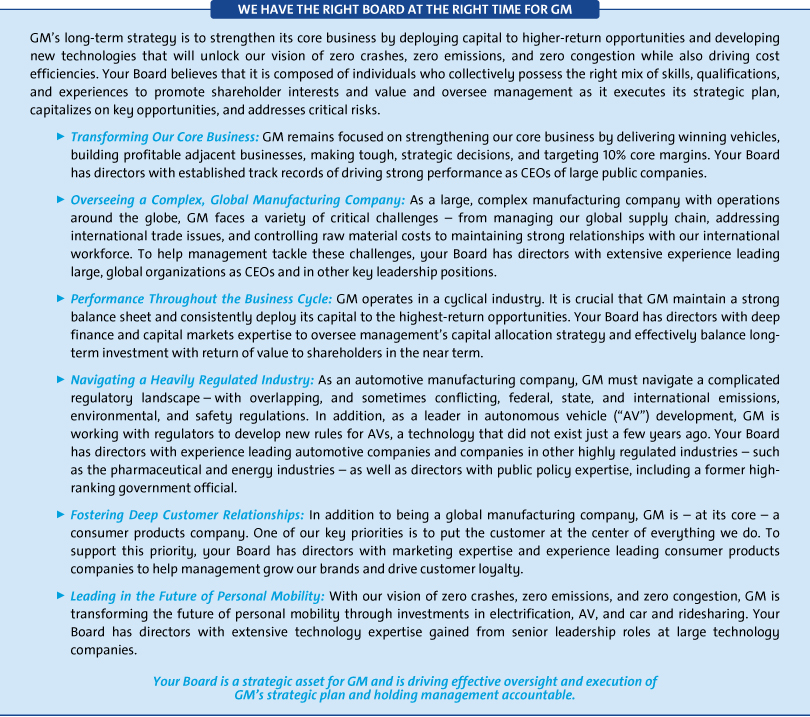
WE HAVE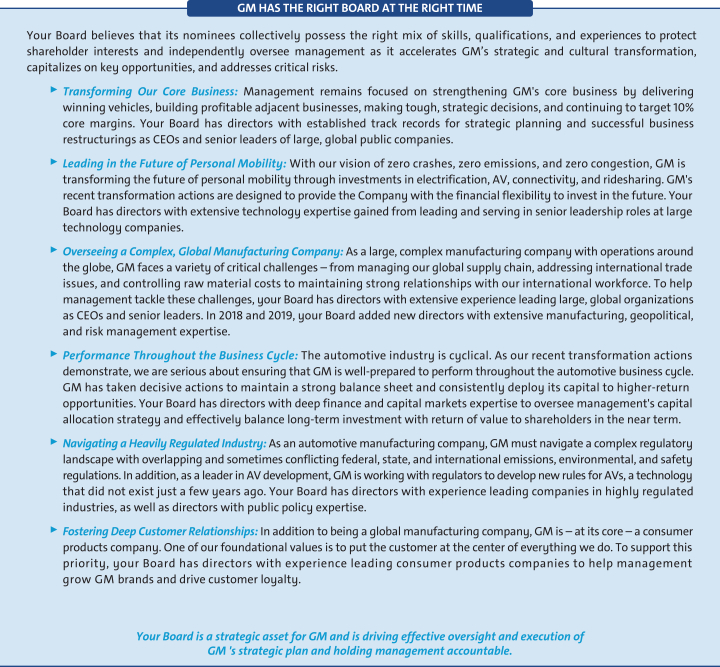
GM HAS THE RIGHT BOARD AT THE RIGHT TIME FOR GM GM’sTIMEGM's long-term strategy is to strengthen its core business by deploying capital to higher-return opportunities and developing new technologies like EVs and AVs that will unlock our vision of zero crashes, zero emissions,Zero Crashes, Zero Emissions, and zero congestionZero Congestion while also driving cost efficiencies. Your Board believes that it is composed of individuals whoits nominees collectively possess the right mix of skills, qualifications, and experiences to promoteprotect shareholder interests and value andindependently oversee management as it executes itsaccelerates GMs strategic plan,and cultural transformation, capitalizes on key opportunities, and addresses critical risks. Transformingrisks.Transforming Our Core Business: GMIn November 2018, we announced plans to accelerate GM's transformation for the future, building on the comprehensive strategy the Company laid out in 2015 to strengthen its core business, capitalize on the future of personal mobility, and drive significant cost efficiencies. Management remains focused on strengthening ourGM's core business by delivering winning vehicles, building profitable adjacent businesses, making tough, strategic decisions, and targetingcontinuing to target 10% core margins. Your Board has directors with established track records of driving strong performancefor strategic planning and successful business restructurings as CEOs and senior leaders of large, global public companies. Overseeingcompanies.Leading in the Future of Personal Mobility: With our vision of Zero Crashes, Zero Emissions, and Zero Congestion, GM is transforming the future of personal mobility through investments in electrification, AV, connectivity, and ridesharing. GM's recent transformation actions are designed to provide the Company with the financial flexibility to invest in the future. Your Board has directors with extensive technology expertise gained from leading and serving in senior leadership roles at large technology companies.Overseeing a Complex, Global Manufacturing Company: As a large, complex manufacturing company with operations around the globe, GM faces a variety of critical challenges – from managing our global supply chain, addressing international trade issues, and controlling raw material costs to maintaining strong relationships with our international workforce. To help management tackle these challenges, your Board has directors with extensive experience leading large, global organizations as CEOs and in other key leadership positions. Performancesenior leaders. In 2018 and 2019, your Board added new directors with extensive manufacturing, geopolitical, and risk management expertise.Performance Throughout the Business Cycle: GM operates in a cyclical industry. ItThe automotive industry is crucialcyclical. As our recent transformation actions demonstrate, we are serious about ensuring that GM is well-prepared to perform throughout the automotive business cycle. GM has taken decisive actions to maintain a strong balance sheet and consistently deploy its capital to the highest-return opportunities. Your Board has directors with deep finance and capital markets expertise to oversee management’smanagement's capital allocation strategy and effectively balance long-term investment with return of value to shareholders in the near term. Navigatingterm.Navigating a Heavily Regulated Industry: As an automotive manufacturing company, GM must navigate a complicatedcomplex regulatory landscape – with overlapping and sometimes conflicting federal, state, and international emissions, environmental, and safety regulations. In addition, as a leader in autonomous vehicle (“AV”)AV development, GM is working with regulators to develop new rules for AVs, a technology that did not exist just a few years ago. Your Board has directors with experience leading automotive companies and companies in other highly regulated industries, – such as the pharmaceutical and energy industries – as well as directors with public policy expertise, including a former high-ranking government official. Fosteringexpertise.Fostering Deep Customer Relationships: In addition to being a global manufacturing company, GM is – at its core – a consumer products company. One of our key priorities is to put the customer at the center of everything we do. To support this priority, your Board has directors with marketing expertise and experience leading consumer products companies to help management grow ourGM brands and drive customer loyalty. Leading in the Future of Personal Mobility: With our vision of zero crashes, zero emissions, and zero congestion, GM is transforming the future of personal mobility through investments in electrification, AV, and car and ridesharing. Your Board has directors with extensive technology expertise gained from senior leadership roles at large technology companies. Yourloyalty.Your Board is a strategic asset for GM and is driving effective oversight and execution of GM’sGM 's strategic plan and holding management accountable.
 |
| 9 |
ITEM NO. 1 – ELECTION OF DIRECTORS
Diversity of Skills, Qualifications, and Experience |
Your Board nominees offer a diverse range of skills and experience in relevant areas.
SKILL/ QUALIFICATION | BARRA | SOLSO | BUSH | GOODEN | JIMENEZ | MENDILLO | MISCIK | RUSSO | SCHOEWE | STEPHENSON | WENIG | |||||||||||||
 | ● | ● | ● | ● | ● | ● | ● | ● | ● | ● | ● | |||||||||||||
| ● | ● | ||||||||||||||||||||||
| ● | ● | ● | ● | ● | ● | ● | |||||||||||||||||
| ● | ● | ● | ● | ● | ● | ● | ● | ||||||||||||||||
| ● | ● | ● | ● | ● | ● | ● | ● | ● | ● | ● | |||||||||||||
| ● | ● | ● | ● | ● | ● | ● | ● | ● | ● | ● | |||||||||||||
| ● | ● | ● | ● | ● | ● | ● | ● | ● | ● | ||||||||||||||
| ● | ● | ● | |||||||||||||||||||||
| ● | ● | ● | ● | ● | |||||||||||||||||||
| ● | ● | ● | ● | ● | ● | ● | |||||||||||||||||
Board Membership Criteria, Refreshment, and Succession Planning
The selection of qualified directors is fundamental to the Board’s successful oversight of GM’s strategy and enterprise risks. As a result, ensuringEnsuring your Board is composed of directors who bring diverse viewpoints and perspectives, exhibitpossess a variety of skills, professional experiences, and backgrounds, and effectively represent the long-term interests of shareholders is critical to your Board and the Governance Committee. The priorities for recruiting new directors are continually evolving based on the Company’s strategic needs and the skills composition of your Board at any particular time. These dynamic priorities ensure the Board remains a strategic asset capable of addressingoverseeing and helping management address the risks, trends, and opportunities that GM will face in the future.
In evaluating potential director candidates, the Governance Committee considers, among other factors, the criteria shown above in the skills and qualifications matrix for your current directors and any additional characteristics that it believes one or more directors should possess based on an assessment of the needs of the Board at that time. In every case, director candidates must be able to contribute significantly to your Board’s discussion and decision-making on the broad array of complex issues facing GM. The Governance Committee also engages a reputable, qualified search firm that uses our skills matrix to inform the search and help identify and evaluate potential candidates.

SPOTLIGHT: RECENT BOARD SUCCESSION PLANNINGOver the past several years, your Board has worked hard to develop a succession plan that will serve the Company and its shareholders in preparation for the departures of Admiral Mullen and Mr. Mulva, who will not be standing for reelection at the Annual Meeting. Your Board consciously endeavored to replace departing directors with directors having comparable or additional skill sets. In addition, your Board also has decided to waive the retirement age for Tim Solso for one-year because we believe the new members of the Board and our shareholders will benefit from his continued leadership during this period of transformation. We also plan to refresh your Boards committee assignments in May 2019. For additional information, please see pages 25 to 27.
| 10 |
|
ITEM NO. 1 – ELECTION OF DIRECTORS
| u | Board Diversity |
The Governance Committee considersseeks individuals with a broad range of business experience and varied backgrounds. Although GM does not have a formal policy governing diversity among directors, your Board strives to identify candidates with diverse backgrounds. We recognize the value of overall diversity and consider members’ and candidates’ opinions, perspectives, personal and professional experiences, and backgrounds, including gender, race, ethnicity, and country of origin. We believe that the judgment and perspectives offered by a diverse board of directors improves the quality of decision making and enhances the Company’s business performance. We also believe such diversity can help the Board respond more effectively to the needs of customers, shareholders, employees, suppliers, and other stakeholders.
|
ITEM NO. 1 – ELECTION OF DIRECTORS
| u | Candidate Recommendations |
The Governance Committee will consider persons recommended by shareholders for election to the Board. The Governance Committee will review the qualifications and experience of each recommended candidate using the same criteria for candidates proposed by Board members and communicate its decision to the candidate or the person who made the recommendation.


| u | Director Recruitment Process |

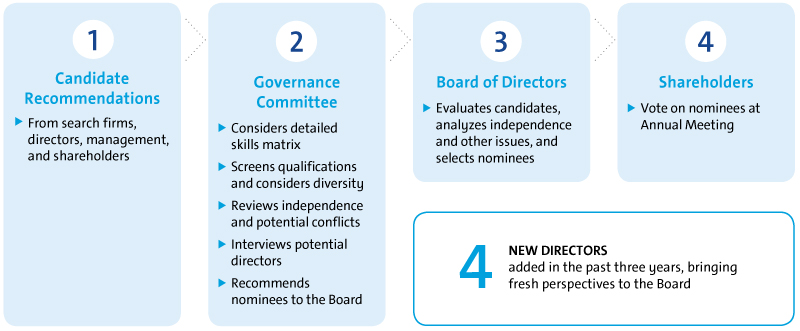
Your Board’s Nominees for Director
Set forth below is otherimportant information about our director nominees, including their name and age, recent employment or principal occupation, their period of service as a GM director, the names of other public companies for which they currently serve as a director or have served as a director in the past, and a summary of their specific experiences, qualifications, attributes, and skills.nominees. We believe each of your Board’s nominees is highly qualified with unique experiences that are particularly beneficial to GM. Collectively, we believe these director nominees represent the best mix of expertise, qualifications, and skills to advance GM’s business strategy and serve the interest of all of our shareholders by driving long-term shareholder value.
The Board of Directors recommends a voteFOR each of the nominees below.
TO RECOMMEND AN INDIVIDUAL FOR BOARD MEMBERSHIP, WRITE TO: GM’s Corporate Secretary, at General Motors Company, Mail Code482-C24-A68, 300 Renaissance Center, Detroit, Michigan 48265, or by e-mail to shareholder.relations@gm.com.
 |
| 11 |
ITEM NO. 1 – ELECTION OF DIRECTORS
 |  | |
| Mary T. Barra | Theodore M. Solso | |
Chairman & Chief Executive Officer, General Motors Company | Independent Lead Director, General Motors Company, and Retired Chairman & Chief Executive Officer, | |
| Director since: 2014 | Director since: 2012 | |
Committees
Executive (Chair)
Current Public Company Directorships
The Walt Disney Company
Prior Public Company Directorships
General Dynamics Corporation (2011 to 2017)
Prior Experience Ms. Barra has served as Chairman of GM’s Board of Directors since January 2016 and Chief Executive Officer of GM since January 2014. Prior to that time, she served as Executive Vice President, Global Product Development, Purchasing and Supply Chain from 2013 to 2014; Senior Vice President, Global Product Development from 2011 to 2013; Vice President, Global Human Resources from 2009 to 2011; and Vice President, Global Manufacturing Engineering from 2008 to 2009. Ms. Barra began her career at GM in 1980.
Reasons for Nomination u Extensive senior leadership experience u In-depth knowledge of the global automotive industry. u Deep understanding of GM’s strengths, weaknesses, opportunities, challenges, risks, and corporate culture. u Ability to drive the efficient execution of GM’s strategic plan and vision for the future. u Strong leadership and management skills coupled with extensive engineering and global product development experience. u Valuable knowledge of key governance matters gained as a director of GM and other large global public companies. | Committees
Executive
Current Public Company Directorships
Prior Public Company Directorships
Ashland Inc. (1999 to 2012) (Lead
Prior Experience Mr. Solso served asNon-Executive Chairman of the GM Board of Directors from 2014 to 2016. He was Chairman and Chief Executive Officer of Cummins, Inc.
Reasons for Nomination u Extensive senior leadership experience gained as the CEO of Cummins, including automotive-related experience and experience in finance, accounting, and vehicle and workplace safety. u Background leading a company through strong financial performance and shareholder returns, international growth, and business restructurings. u Valuable knowledge of key governance matters, including environmental issues, corporate responsibility, diversity, and human rights issues, gained as the CEO of Cummins and the u Extensive experience in automotive manufacturing and engineering, including with respect to emissions reduction technology, development of diesel engines, and compliance with challenging emissions laws and regulations. u Valuable insight into advancing the business priorities of GM’s international operations gained as the U.S. Chairman of theU.S.-Brazil CEO Forum. | |
|
|
ITEM NO. 1 – ELECTION OF DIRECTORS
  |   | |||
| Chairman, Northrop Grumman Corporation | Retired Executive Vice President, Information Systems & Global Solutions, Lockheed Martin Corporation | |||
| Director since: | Director since: 2015 | |||
Committees Executive Compensation, Finance Current Public Company Directorships Northrop Grumman Corporation (“Northrop Grumman”) and Dow Inc. Prior Public Company Directorships Norfolk Southern Corporation Prior Experience In 2011, Mr. Bush was appointed Chairman of the Board of Directors of Northrop Grumman. He also served as the Chief Executive Officer of Northrop Grumman from 2010 to 2018. Prior to that, Mr. Bush served in numerous leadership roles at Northrop Grumman, including President and Chief Operating Officer, Chief Financial Officer, and President of the company’s Space Technology sector. He also served in a variety of leadership positions at TRW, Inc., before it was acquired by Northrop Grumman in 2002. He is a member of the National Academy of Engineering. Reasons for Nomination u Strong track record of creating shareholder value in a complex manufacturing enterprise known for its advanced engineering and technology. u Strong financial acumen, excellent strategic instincts, and an ability to think broadly about complex business issues. u Valuable knowledge of key governance matters, including compensation, finance, risk management, and environment, health, and safety, gained as a director of Northrop Grumman and other large global public companies. u Valuable knowledge of key governance matters gained as a director of GM and other large global public companies. | Committees
Audit, Cybersecurity (Chair), Executive, Risk
Current Public Company Directorships
Automatic Data Processing, Inc., and The Home Depot, Inc. Prior Public Company Directorships WGL Holdings, Inc., and Washington Gas & Light Company, a subsidiary of WGL Holdings, Inc.
Prior Experience Ms. Gooden served as Executive Vice President, Information Systems & Global Solutions of Lockheed Martin Corporation (“
Reasons for Nomination u Significant senior leadership experience gained through various leadership positions at Lockheed Martin, including experience in technology, innovation, acquisitions, divestitures, business restructuring, u Strong track record of identifying and mitigating enterprise risks in various senior leadership roles. u Valuable insight into GM’s information technology (“IT”) function, technology systems and processes, and cybersecurity framework, including those related to mobility and autonomous vehicles, gained through various leadership roles at u Extensive expertise in cybersecurity and IT, as well as significant operational, strategic planning, and government relations experience. u Valuable knowledge of key governance matters gained as a director of GM and other large global public companies. | |||
 | 13 |
ITEM NO. 1 – ELECTION OF DIRECTORS
 |  | |
| Joseph Jimenez | Jane L. Mendillo | |
| Retired Chief Executive Officer, Novartis AG | Retired President & Chief Executive Officer, Harvard Management Company | |
| 59 years old | 60 years old | |
| Director since: 2015 | Director since: 2016 | |
Committees
Executive Compensation, Governance and Corporate Responsibility
Current Public Company Directorships
The Procter & Gamble Co.
Prior Public Company Directorships
Colgate-Palmolive Company (2010 to 2015)
Prior Experience Mr. Jimenez served as Chief Executive Officer of Novartis AG (“Novartis”) from 2010 until his retirement in
Reasons for Nomination u Extensive senior leadership experience gained as the CEO of Novartis and in other senior leadership positions in the consumer products industry, including experience in international operations, strategic planning, and finance. u Valuable insight into GM’s strategy to enhance the customer experience and earn customers for life gained through various senior leadership positions at Heinz and ConAgra and as a director of u Experience executing business restructurings and significant business transformations at both Heinz and Novartis. u Valuable knowledge of key governance matters gained as the CEO of Novartis and a director of GM and other large global public companies. | ||
|
ITEM NO. 1 – ELECTION OF DIRECTORS
 |  | |
Committees
Audit, Finance
Current Public Company Directorships
Lazard Prior Public Company Directorships None
Prior Experience Ms. Mendillo served as President and Chief Executive Officer of the Harvard Management Company (“HMC”) from 2008 to 2014, managing Harvard University’s approximately $37 billion global endowment and related assets. Prior to joining HMC, she was Chief Investment Officer of Wellesley College from 2002 to 2008; and prior to that, she spent 15 years at HMC in
Reasons for Nomination u Extensive senior leadership experience gained as the CEO of HMC, including experience in risk and crisis management. u Deep capital markets expertise gained from her more than 30 years managing globally diverse endowments and investment portfolios. u Valuable insight into GM’s disciplined capital allocation framework and its financial policies and strategies. u Valuable knowledge of key governance matters gained as a director of GM and another large global public company. |
| |
|
|
ITEM NO. 1 – ELECTION OF DIRECTORS
  |  | |
| Patricia F. Russo | ||
Kissinger Associates, Inc. | Chairman, Hewlett Packard Enterprise Company | |
| Director since: | Director since: 2009 | |
Committees
Current Public Company Directorships
Prior Public Company
Prior Experience
Reasons for Nomination u Extensive
u Valuable experience in assessing and mitigating geopolitical and macroeconomic risks in both public and private sector roles, which will provide significant insight into GM’s u Unique and extensive background in u Valuable knowledge of key governance matters gained as | Committees
Executive, Executive Compensation, Finance, Governance and Corporate Responsibility (Chair)
Current Public Company Directorships
Prior Public Company Directorships
Hewlett-Packard Company (2011 to 2015) (Lead Director 2014 to 2015) and Alcoa, Inc. (2016)
Prior Experience Ms. Russo served as Lead Director of the Hewlett-Packard Company Board of Directors from 2014 to 2015. She was Independent Lead Director of the GM Board of Directors from March 2010 to January 2014. She also served as Chief Executive Officer of Alcatel-Lucent S.A. (“Alcatel-Lucent”) from 2006 to 2008; Chairman and Chief Executive Officer of Lucent Technologies, Inc., (“Lucent”) from 2003 to 2006; and President and Chief Executive Officer of Lucent from 2002 to 2006.
Reasons for Nomination u Extensive senior leadership gained as the CEO of Alcatel-Lucent and Lucent, including experience in corporate strategy, finance, sales and marketing, technology, and leadership development. u Significant strategic business experience gained through managing critical technology disruptions and successfully leading Lucent through a severe industry downturn. u Valuable insight into GM’s evaluation and execution of strategic transactions gained through experience overseeing Hewlett-Packard Company’s split into two companies, the Alcoa-Arconic split, and managing the Alcatel-Lucent merger. u Valuable knowledge of key governance matters, including executive compensation, gained as the CEO of Alcatel-Lucent and Lucent and as a director of GM and other large global public companies. | |
 |
| 15 |
ITEM NO. 1 – ELECTION OF DIRECTORS
 |  | |
| Thomas M. Schoewe | Carol M. Stephenson, O.C. | |
| Retired Executive Vice President & Chief Financial Officer, Wal-Mart Stores, Inc. | Retired Dean, Ivey Business School, | |
| Director since: 2011 | Director since: 2009 | |
Committees
Audit (Chair), Cybersecurity, Executive, Finance, Risk
Current Public Company Directorships
KKR Management LLC and Northrop Grumman Corporation
Prior Public Company Directorship
PulteGroup, Inc. (2009 to 2012)
Prior Experience Mr. Schoewe served as Executive Vice President and Chief Financial Officer ofWal-Mart Stores, Inc.(“Wal-Mart”) from 2000 to 2011. Prior to joiningWal-Mart, he was Senior Vice President and Chief Financial Officer of Black & Decker Corporation (“Black & Decker”) from 1996 to 1999; Vice President and Chief Financial Officer of Black & Decker from 1993 to 1996; Vice President of Finance of Black & Decker from 1989 to 1993; and Vice President of Business Planning and Analysis of Black & Decker from 1986 to 1989.
Reasons for Nomination: u Extensive financial expertise as the CFO ofWal-Mart and Black & Decker. u Significant senior leadership experience gained in various leadership positions, including experience in financial reporting, accounting and controls, business planning and analysis, and risk management. u Valuable insight into GM’s IT function, technology systems and processes, and cybersecurity framework gained through experience leading large-scale, transformational IT implementations atWal-Mart and Black & Decker. u Valuable knowledge of key governance matters gained as a director of GM and | Committees
Executive, Executive Compensation (Chair), Governance and Corporate Responsibility
Current Public Company Directorships
Intact Financial Corporation (formerly ING Canada) and Maple Leaf Foods Inc.
Prior Public Company Directorships
Ballard Power Systems, Inc. (2012 to 2017) and Manitoba Telecom Services (2008 to 2016)
Prior Experience Ms. Stephenson served as Dean of the Ivey Business School at the University of Western Ontario from 2003 until her retirement in 2013. Prior to joining the Ivey Business School, she was President and Chief Executive Officer of Lucent Technologies Canada from 1999 to 2003. She was also a member of the Advisory Board of General Motors of Canada, Limited, a GM subsidiary, from 2005 to 2009 and was appointed an officer of the Order of Canada in 2009.
Reasons for Nomination u Significant senior leadership experience gained as Dean of the Ivey Business School and in leadership positions in the telecommunications industry. u Valuable insight into GM’s strategy to strengthen our core business and transform the future of personal mobility gained through expertise in marketing, operations, strategic planning, technology development, and financial management. u Extensive expertise in North American trade issues and the Canadian business environment gained as a director at several leading Canadian companies. u Valuable knowledge of key governance matters, including executive compensation, gained as a director of GM and | |
|
|
ITEM NO. 1 – ELECTION OF DIRECTORS
| ||
| Devin N. Wenig | ||
| President & Chief Executive Officer, eBay Inc. | ||
| Director since: 2018 | ||
Committees
Current Public Company Directorships
eBay Inc. Prior Public Company Directorships None
Prior Experience In July 2015, Mr. Wenig was appointed as President and Chief Executive Officer of
Reasons for Nomination u Extensive senior leadership experience gained as the CEO of eBay, including experience in technology, global operations, and strategic planning. u Critical technology insight into GM’s strategies related to the future of mobility, autonomous vehicles, vehicle connectivity, and data monetization gained through various roles at eBay. u Valuable insight into GM’s strategy to enhance the customer experience and earn customers for life gained through various consumer-facing leadership roles at eBay, Thomson Reuters, and Reuters. u Valuable knowledge of key governance matters gained as the CEO | ||
 |
| 17 |
ITEM NO. 1 – ELECTION OF DIRECTORS
Non-Employee Director Compensation
Ournon-employee directors receive cash compensation as well as equity compensation in the form of GM Deferred Share Units (“DSUs”) for their Board service. Compensation for ournon-employee directors is set by the Board at the recommendation of the Governance Committee.
| u | Guiding Principles |
| u | Fairly compensate directors for their responsibilities and time commitments. |
| u | Attract and retain highly qualified directors by offering a compensation program consistent with those at companies of similar size, scope, and complexity. |
| u | Align the interests of directors with our shareholders by providing a significant portion of compensation in equity and requiring directors to continue to own our common stock (or common stock equivalents). |
| u | Provide compensation that is simple and transparent to shareholders. |
| u | Annual Review Process |
The Governance Committee, which consists solely of independent directors, annually assesses the form and amount ofnon-employee director compensation and recommends changes, if appropriate, to the Board based upon competitive market practices. GM’s Legal Staff also supports the Committee in determining director compensation and designing the related benefit programs. In addition, if the Governance Committee determines it is necessary, it has the authority to engage the services of outside consultants, experts, and others to assist in designing and setting director compensation. As part of its annual review, the Committee conducts extensive benchmarking by reviewing director compensation data for the executive compensation peer group described in “Executive Compensation—Compensation Overview—Peer Group for Compensation Comparisons” on page 41.42. Following its annual review of GM’s director compensation in December 2017,2018, the Governance Committee recommended that the Board maintain the same structure and level of compensation and stock ownership requirements for 20182019 as were in place in 2017.2018.
| u | Director Stock Ownership and Holding Requirements |
| u | Eachnon-employee director is required to own our common stock or DSUs with a market value of at least $500,000. |
| u | Each director has up to five years from the date he or she is first elected to the Board to meet this ownership requirement. |
| u | Non-employee directors are prohibited from selling any GM securities or derivatives of GM securities, such as DSUs, while they are members of the Board. |
| u | Ownership guidelines are reviewed each year to confirm they continue to be effective in aligning the interests of the Board and our shareholders. |
| u | All of our directors are in compliance with our stock retention requirements. |
| u | Annual Compensation |
During 2017,2018, compensation fornon-employee directors consisted of the elements described in the table below. We do not pay any other retainers or meeting fees. The Independent Lead Director and Committee Chairs receive additional compensation due to the increased workload and additional responsibilities associated with these positions. In particular, Mr. Solso’s compensation as Independent Lead Director reflects the additional time commitment for this role, which includes, among other responsibilities, attending all Board Committee meetings, meeting with the Company’s investors, and attending additional meetings with the Company’s senior management, including the CEO. For additional information about the roles and responsibilities of our Independent Lead Director, see “Corporate Governance—Board Leadership Structure” on page 21.22.
Compensation Element | 2018 | ||||||
Board Retainer | $ | 285,000 |
| ||||
Independent Lead Director Fee | $ | 100,000 | |||||
Audit Committee Chair Fee |
| ||||||
| $ 30,000 |
| |||||
|
|
| |||||
|
| ||||||
All Other Committee Chair Fees (excluding the Executive Committee) |
| $20,000 |
| ||||
|
|
ITEM NO. 1 – ELECTION OF DIRECTORS
Non-employee directors are required to defer at least 50% of their annual Board retainer ($142,500) into DSUs under the General Motors Company Deferred Compensation Plan forNon-Employee Directors (the “Director Compensation Plan”). Directors may elect to defer all or half of their remaining Board retainer or amounts payable (if any) for serving as Committee Chair or Independent Lead Director into additional DSUs. The fees for a director who joins or leaves the Board or assumes additional responsibilities during the year are prorated for his or her period of service.
| u | How Deferred Share Units Work |
Each DSU is equal in value to a share of GM common stock and is fully vested upon grant, but does not have voting rights. DSUs will not be available for disposition until after the director leaves the Board. After leaving the Board, the director will receive a cash payment or payments based on the number of DSUs in the director’s account valued at the average daily closing market price for the quarter immediately preceding payment. Directors will be paid in a lump sum or in annual installments for up to five years, based on their deferral elections. All DSUs granted are rounded up to the nearest whole unit. Any portion of the retainer that is deferred into DSUs may also earn dividend equivalents, which are credited at the end of each calendar year to each director’s account in the form of additional DSUs. DSUs granted are determined as follows:

Amount of compensation required or elected to be deferred each calendar year under the Director Compensation Plan / Average daily closing market price of our common stock for that calendar year = DSUs Granted
| u | Other Compensation |
As outlined below, we provide certain additional benefits tonon-employee directors.
Type | Purpose | |
u Company Vehicles |
We provide directors with the use of | |
u Personal Accident Insurance |
We provide PAI coverage in the event of accidental death or dismemberment. Directors are responsible for associated taxes on the imputed income from the coverage. |
| (1) | Ms. Barra, our sole employee director, does not receive additional compensation for her Board service other than the PAI benefit described above, the value of which is reported for Ms. Barra in the Summary Compensation Table on page |
Non-employee directors are not eligible to participate in any of the savings or retirement programs for our employees. Other than as described in this section, there are no separate benefit plans for directors.
 |
| 19 |
Amount of compensation required or elected to be deferred each calendar year under the Director Compensation Plan ÷ Average daily closing market price of our common stock for that calendar year = DSUs Granted
ITEM NO. 1 – ELECTION OF DIRECTORS
| u |
|
This table shows the compensation that eachnon-employee director received for his or her 20172018 Board and Committee service.
| Director
| Fees Earned or Paid in Cash(1) ($)
| Stock Awards(2) ($)
| All Other Compensation(3) ($)
| Total ($)
|
Fees Earned or Paid in Cash(1) ($) | Stock Awards(2) ($) | All Other Compensation(3) ($) | Total ($) | ||||||||||||||||||||||||
Joseph J. Ashton(4)
|
| 142,500
|
|
| 156,336
|
|
| 34,698
|
|
| 333,534
|
| ||||||||||||||||||||
Linda R. Gooden(5)
|
| 145,833
|
|
| 155,311
|
|
| 22,448
|
|
| 323,592
|
| ||||||||||||||||||||
Linda R. Gooden |
| 162,500 |
|
| 126,073 |
|
| 18,782 |
|
| 307,355 |
| ||||||||||||||||||||
Joseph Jimenez
|
| 142,500
|
|
| 155,311
|
|
| 24,282
|
|
| 322,093
|
|
| 142,500 |
|
| 126,073 |
|
| 23,803 |
|
| 292,376 |
| ||||||||
Jane L. Mendillo
|
| 142,500
|
|
| 155,311
|
|
| 11,323
|
|
| 309,134
|
|
| 142,500 |
|
| 126,073 |
|
| 9,573 |
|
| 278,146 |
| ||||||||
Judith A. Miscik(4) |
| 35,625 |
|
| 34,487 |
|
| 1,394 |
|
| 71,506 |
| ||||||||||||||||||||
Michael G. Mullen
|
| 162,500
|
|
| 155,311
|
|
| 23,428
|
|
| 341,239
|
|
| 162,500 |
|
| 126,073 |
|
| 31,719 |
|
| 320,292 |
| ||||||||
James J. Mulva
|
| 162,500
|
|
| 155,311
|
|
| 36,490
|
|
| 354,301
|
|
| 162,500 |
|
| 126,073 |
|
| 29,115 |
|
| 317,688 |
| ||||||||
Patricia F. Russo
|
| 162,500
|
|
| 155,311
|
|
| 19,886
|
|
| 337,697
|
|
| 162,500 |
|
| 126,073 |
|
| 19,261 |
|
| 307,834 |
| ||||||||
Thomas M. Schoewe
|
| 172,500
|
|
| 155,311
|
|
| 30,448
|
|
| 358,259
|
|
| 172,500 |
|
| 126,073 |
|
| 37,282 |
|
| 335,855 |
| ||||||||
Theodore M. Solso
|
| 242,500
|
|
| 155,311
|
|
| 15,490
|
|
| 413,301
|
|
| 242,500 |
|
| 126,073 |
|
| 18,990 |
|
| 387,563 |
| ||||||||
Carol M. Stephenson
|
| 162,500
|
|
| 155,311
|
|
| 12,782
|
|
| 330,593
|
|
| 162,500 |
|
| 126,073 |
|
| 16,823 |
|
| 305,396 |
| ||||||||
Devin N. Wenig(5) |
| 106,875 |
|
| 97,072 |
|
| 10,889 |
|
| 214,836 |
| ||||||||||||||||||||
| (1) | This column reflects director compensation eligible to be paid in cash, which consists of |
| (2) | Reflects aggregate grant date fair value of DSUs granted in |
| (3) | The following table provides more information on the type and amount of benefits included in the All Other Compensation column. |
Director
| Company Vehicle Program (a)
| Other (b)
| Total
| Director
| Company Vehicle Program (a)
| Other (b)
| Total
| Company Vehicle Program (a) | Other (b) | Total | Director | Company Vehicle Program (a) | Other (b) | Total | ||||||||||||||||||||||||||||||||||||||||||||||
Mr. Ashton
|
| $34,458
|
|
| $240
|
|
| $34,698
|
| Mr. Mulva
|
| $36,250
|
|
| $240
|
|
| $36,490
|
| |||||||||||||||||||||||||||||||||||||||||
Ms. Gooden
|
| $22,208
|
|
| $240
|
|
| $22,448
|
| Ms. Russo
|
| $19,646
|
|
| $240
|
|
| $19,886
|
|
| $18,542 |
|
| $240 |
|
| $18,782 |
| Ms. Russo |
| $19,021 |
|
| $240 |
|
| $19,261 |
| ||||||||||||||||||||||
Mr. Jimenez
|
| $24,042
|
|
| $240
|
|
| $24,282
|
| Mr. Schoewe
|
| $30,208
|
|
| $240
|
|
| $30,448
|
|
| $23,563 |
|
| $240 |
|
| $23,803 |
| Mr. Schoewe |
| $37,042 |
|
| $240 |
|
| $37,282 |
| ||||||||||||||||||||||
Ms. Mendillo
|
| $11,083
|
|
| $240
|
|
| $11,323
|
| Mr. Solso
|
| $15,250
|
|
| $240
|
|
| $15,490
|
|
| $ 9,333 |
|
| $240 |
|
| $ 9,573 |
| Mr. Solso |
| $18,750 |
|
| $240 |
|
| $18,990 |
| ||||||||||||||||||||||
Mr. Mullen
|
| $23,188
|
|
| $240
|
|
| $23,428
|
| Ms. Stephenson
|
| $12,542
|
|
| $240
|
|
| $12,782
|
| |||||||||||||||||||||||||||||||||||||||||
Ms. Miscik |
| $ 1,354 |
|
| $ 40 |
|
| $ 1,394 |
| Ms. Stephenson |
| $16,583 |
|
| $240 |
|
| $16,823 |
| |||||||||||||||||||||||||||||||||||||||||
Admiral Mullen |
| $31,479 |
|
| $240 |
|
| $31,719 |
| Mr. Wenig |
| $10,729 |
|
| $160 |
|
| $10,889 |
| |||||||||||||||||||||||||||||||||||||||||
Mr. Mulva |
| $28,875 |
|
| $240 |
|
| $29,115 |
| |||||||||||||||||||||||||||||||||||||||||||||||||||
| (a) | The Company vehicle program includes the estimated annual lease value of the Company vehicles driven by directors. We include the annual lease value because it is more reflective of the value of the |
| (b) | Reflects the cost of premiums for providing personal accident insurance (annual premium cost of $240 is prorated, as applicable, for the period of service). In addition, Mr. Solso received tickets to attend a special event; the tickets had no incremental cost to the Company. |
| (4) |
|
| (5) |
|
|
|
Role of the Board of Directors
GM is governed by a Board of Directors and Committees of the Board that meet throughout the year. The Board is elected by shareholders to oversee and provide guidance on the Company’s business and affairs. It is the ultimate decision-making body of the Company except for those matters reserved for shareholders.shareholders by law or pursuant to the Company’s governance instruments. The Board is actively engaged in the process of strategic development and oversight of ongoing execution of the Company’s strategic plan. It oversees management’s activities
in connection with proper safeguarding of the assets
of the Company, maintenance of appropriate financial and other internal controls, compliance with applicable laws and regulations, and proper governance. The Board is committed to sound corporate governance policies and practices that are designed and routinely assessed to enable the Company to operate its business responsibly, with integrity, and to position GM to compete more effectively, sustain its success, and build long-term shareholder value.
The Board is Actively Engaged in Shaping the Company’s Purpose and Overseeing Strategy Every year, the Board holds a multi-day session devoted to discussing, debating, challenging, and validating management’s strategic objectives, initiatives, and execution. During these discussions, directors engage in an active dialogue and shape various aspects of management’s strategy and execution. This annual strategy session is supplemented by frequent updates and discussions of GM’s strategy throughout the year – at every Board meeting and between regularly scheduled sessions as may be necessary from time to time. Since the last annual meeting, these strategy discussions included review of the Company’s recent transformation actions; Cadillac’s future growth plans; performance and strategic opportunities in China; regulatory issues related to vehicle efficiency standards; the Company’s electric vehicle execution strategy; and other issues critical to the future viability of the Company. Your Board also solicits independent views on GM’s business and key industry trends from outside experts – including investment bankers and buy- and sell-side analysts – as well as investors through its robust Director-Shareholder Engagement Policy. For additional information on shareholder engagement, please see pages 31 and 32. |
The Board is Actively Engaged in Shaping the Company's Purpose and Overseeing Strategy Every year, the Board holds a multi-day session devoted to debating, challenging, and validating management's strategic objectives, initiatives, and execution. During these discussions, directors engage in an active debate and dialogue, challenge and validate management's assumptions, and shape various aspects of management's strategy and execution. This annual strategy session is supplemented by frequent updates and discussions of GM's strategy throughout the year-at every Board meeting and between regularly scheduled sessions as may be necessary from time to time. Since the last annual meeting, these strategy discussions included review of the Company's recent transformation actions; Cadillac's future growth plans; performance and strategic opportunities in China; regulatory issues related to vehicle efficiency standards; the Company's electric vehicle execution strategy; and other issues critical to the future viability of the Company. Your Board also solicits independent views on GM's business and key industry trends from outside experts-including investment bankers and buy- and sell-side analysts-as well as investors through its robust Director-Shareholder Engagement Policy. For additional information on shareholder engagement, see page ["].
The Board of Directors sets the number of directors from time to time by resolution adopted by a majority of the Board. The Board is currently composed of 11 members.directors. The Governance Committee reassesses the suitability of the Board’s size at least annually. The Board has the flexibility to increase or decrease the size of the Board as circumstances warrant. The Board is currently composed of 13 members, but Admiral Mullen and Mr. Mulva are not standing for reelection at the Annual Meeting. If
all of the Board’s nominees are elected, the Board will be composed of 11 members immediately following the Annual Meeting. If any nominee
is unable to serve as a director or if any director leaves the Board between Annual Meetings, the Board, by resolution, may reduce the number of directors or elect an individual to fill the resulting vacancy. If all of the Board’s nominees are elected, the Board will be composed of 11 members immediately following the Annual Meeting.
Code of Business Conduct and Ethics: “Winning with Integrity”
The Board is committed to the highest legal and ethical standards in fulfilling its responsibilities. We have adopted a code of business conduct and ethics, “Winning with Integrity,” (“Code”) that applies to our directors, officers, and employees. “Winning with Integrity” forms the foundation for compliance with corporate policies and procedures and creates a Company-wide focus on uncompromising integrity in every aspect of our operations. The codeCode embodies our expectations for a number of topics, including workplace and vehicle safety, conflicts of
interest, protection of confidential information, insider trading, competition and fair dealing, human rights, community involvement and corporate citizenship, political activities and lobbying, preservation and use of Company assets, and compliance with all laws and regulations applicable to the conduct of our business. Employees are expected to report any conduct that they believe in good faith to be an actual or apparent violation of the code.Code.
 | 21 |
CORPORATE GOVERNANCE
Corporate Governance Guidelines
Your Board oversees a governance structure that it believes promotes the best interests of our shareholders. Our Corporate Governance Guidelines form a transparent framework for the effective governance of the Company. The Corporate Governance Guidelines address matters such as the respective roles and responsibilities of the Board and management, the Board’s leadership structure, the responsibilities of the Independent Lead Director, director independence, the Board membership criteria, Board Committees, and Board and CEO evaluation. The Governance Committee regularly reviews the Corporate Governance Guidelines and periodically recommends to your Board the adoption of amendments in response to changing regulations, evolving best practices, and shareholder concerns. For a summary of our corporate governance best practices, see“Proxyplease see “Proxy Statement Summary—Governance Highlights” on page 3.
Our code of business conduct and ethics, “Winning with Integrity,” and Corporate Governance Guidelines and are available on our website
|
|
CORPORATE GOVERNANCE
GM’s Bylaws and Corporate Governance Guidelines define our standards for director independence and are based onreflect applicable New York Stock Exchange (“NYSE”) and U.S. Securities and Exchange Commission (“SEC”) requirements. At leasttwo-thirds of our directors are and must continue to be independent under these standards. The Governance Committee annually assesses the independence of each director and makes recommendations to the Board. For a director to be “independent,” the Board must affirmatively determine that the director has no material relationship with the Company other than his or her service as a director. In addition, members of the Audit Committee and the Executive Compensation CommitteesCommittee (the “Compensation Committee”) must meet heightened independence standards under applicable NYSE and SEC rules.
Consistent with these standards, the Board has reviewed all relationships between the Company and each director and considered all relevant quantitative and qualitative criteria. The Board has affirmatively determined that all directors were independent during 2018, and that all current members are independent, except Ms. Barra, who serves as CEO.
In recommending to the Board that it determine each director is independent, the Governance Committee considered whether there were any other facts or circumstances that might impair a director’s independence. In particular, the Governance Committee evaluated charitable contributions that GM has made to nonprofit organizations with which our directors are or have been associated. None of these transactions were material to either GM or the director. The Governance Committee also considered that GM, in the ordinary course of business, during the last three years has sold fleet vehicles to and purchased products and services from companies at which some of our directors serveas non-employee directors or executives. The Board determined that these transactions were not material to GM or the other companies involved and that none of our directors had a material interest in transactions with these companies. In each case, these transactions were in the ordinary course of business for GM and the other companies involved and were on terms and conditions available to similarly situated customers and suppliers. Therefore, the Board determined they did not impair such director’s independence.
Your Board has the flexibility to decide when the positions of Chairman and CEO should be combined or separated and whether an executive or an independent director should be Chairman. This approach is designed to allowallows the Board to choose the leadership structure that will best serve the interests of our shareholders at any particular time. In January 2016, the Board recombined the positions of Chairman and CEO under the leadership of Ms. Barra and designated Mr. Solso as Independent Lead Director. For 2018, ouryour Board unanimously voted to elect Ms. Barra as Chairman of the Board, and the independent directors unanimously voted to appoint Mr. Solso as the Independent Lead Director for the third consecutive year.Director. The Board’s key duties include oversight of strategy, risk management, and legal and regulatory compliance as well as CEO succession planning. In each of these areas, the Board determined that a combined role of Chairman and CEO together with the presence of a strong Independent Lead Director and governance best practices is the optimal Board leadership structure for GM at this time. Mr. Solso’s perspective on your Board’s leadership structure is provided on the following page.
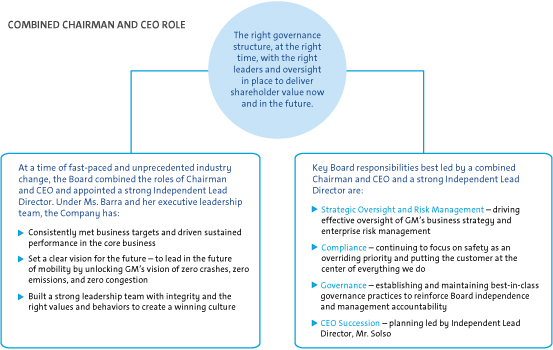
|
|
CORPORATE GOVERNANCE
A Message from the Independent Lead Director on Regarding
Your Board’s Leadership Structure
As the Independent Lead Director, I regularly engage with GM’s investors and other key stakeholders on a variety of issues, including GM’s corporate governance structure and practices and, importantly, your Board’s leadership structure. I want to share with you the same message I deliver during these engagements.
Mary Barra Is the Right Person to Lead Your Board
Your Board carefully considers the appropriate leadership structure for GM and its shareholders on an annual basis and determines whether to combine or split the roles of Chairman and CEO. Your Board believes that Ms. Barra’s service as both Chairman and CEO has provided, and continues to provide, a clear and unified strategic vision for GM during this time of unprecedented industry change. As the individual with primary responsibility for managing the Company, Ms. Barra’sin-depth knowledge of our business and understanding of GM’sday-to-day operations brings focused leadership to your Board. She has been a key leader as we have defined our corporate purpose and vision, reset our culture of safety, and relentlessly focused on putting the customer at the center of everything we do. As Chairman, she facilitates your Board’s continued strong oversightHer leadership of compliance and enterprise risk management programs. For example, under her leadership, in 2017 the Board established a new Cybersecurity Committeeis especially critical at this time as the Company implements its transformation acceleration, announced in November 2018, and prepares to enhance the Board’s oversight of GM’s evolving cybersecurity risks.negotiate important labor agreements in 2019.
Your Board Is Independent and Holds Management Accountable
With 10 of 11 directors being independent, yourYour Board holds management accountable. Ten of the eleven director nominees are independent. We have the right mix of skills, qualifications, and experiences to oversee, guide, and challenge the leadership team. We are engaged in shaping and overseeing GM’s strategy. Strategy is a part of every Board meeting, and every year your Board holds a multiday session devoted exclusivelyhas been deeply involved in GM’s recent actions to accelerate GM’s strategic plan.transformation and invest in the future. During thesestrategic discussions, Board members engage in active debate and dialogue, challenge and validate management assumptions, and shape various aspects of management’s strategy and execution.
My Role as the Independent Lead Director
I striveMy job is to complement Ms. Barra’s role as Chairman by providing strong independent leadership in my role as the Independent Lead Director with the following key duties and responsibilities:
| u | Presiding over all Board meetings when the Chairman is not present, including executive sessions ofnon-management directors, and advising the Chairman of any actions taken; |
| u | Providing Board leadership if circumstances arise in which the role of the Chairman is potentially, or perceived to be, in conflict or if potential conflicts of interest arise for any director; |
| u | Calling executive sessions for |
| u | Leadingnon-management directors in the annual evaluation of the CEO’s performance, communicating it to the CEO, and overseeing the process for CEO succession; |
| u | Advising on the scope, quality, quantity, and timeliness of the flow of information between management and the Board and approving Board meeting agendas and materials recommended by the Chairman; |
| u | Approving Board meeting |
| u | Serving as a liaison between |
| u | Interviewing, along with the Chair of the Governance Committee, all |
| u | Being available to advise the Chairs of the Committees of the Board in fulfilling their designated roles and responsibilities to the Board; and |
| u | Being available, if requested by major shareholders, for consultation and communication in accordance with the Board’s Director-Shareholder Engagement Policy. |
As always, I am proud to work closely with our Chairman and CEO and my fellow independent directors as we drive long-term shareholder value. Your Board has significantly refreshed its membership in recent years to ensure it maintains the right mix of skills, qualifications, and experiences to help lead GM through the continued transformation of its business and the automotive industry. As a part of your Board’s refreshment and succession planning, I look forward to continuing to provide strong and independent leadership throughout this important transition.
On behalf of the entire Board, thank you for your continued support.
| Theodore M. Solso Independent Lead Director
|
 |
| 23 |
CORPORATE GOVERNANCE
Independent directors have an opportunity to meet in executive session without management present as part of each regularly scheduled Board and Committee meeting. Executive sessions are chaired by the Independent Lead Director, Mr. Solso.Solso, or the respective Committee Chair.
During executive sessions, the independent directors may review CEO performance, compensation, and succession planning; strategy; risk;key enterprise risks; future Board agendas and the flow of information to directors; corporate governance matters; and any other matters of importance to the Company raised during a meeting or otherwise presented by the independent directors.
Thenon-management directors of the Board, all of whom are independent, met in executive session six times in 2017, including one time with only independent directors present.2018.
Your Board of Directors has seven standing Committees: Audit, Cybersecurity, Executive Compensation, Finance, Governance, Risk, and Executive. The key responsibilities, recent activities, and focus areas of each Committee are set forth below, together with their current membership and the number of meetings held in 2017.2018. Each Committee Chair meets regularly with management during the year to discuss Committee business, shape agendas, and facilitate efficient meetings. The Chairman, Ms. Barra, and the Independent Lead Director, Mr. Solso, attendsattend all Committee meetings to serve as a resource and identify topics requiring the full Board’s attention. The Board has determined that each member of the Audit, Compensation, Governance, Cybersecurity, Finance, and Risk Committees is independent according to NYSE listing standards and our Corporate Governance Guidelines.
In November 2017,May 2019, we will refresh the Board formedBoard’s Committee memberships and combine the Risk and the Cybersecurity Committees into a new Risk and Cybersecurity Committee. The new Committee at which time the Risk Committee and Audit Committee charters were revisedmemberships are described on pages 25 to reflect the transfer of cybersecurity oversight responsibilities. For additional information about our new Cybersecurity Committee, see “Corporate Governance—Board and Committee Oversight of Risk” on page 27.
Each Committee has a charter governing its activities. Committee charters are available on our website
|
|
|
CORPORATE GOVERNANCE
|  |
| ||||||||
Thomas M. Schoewe, Chair
| AUDIT Members: Thomas M. Schoewe (Chair), Linda R. Gooden, Jane L. Mendillo, Judith A. Miscik, and Michael G. Mullen
Meetings held in |
Linda R. Gooden, Chair
| CYBERSECURITY Members: Linda R. Gooden (Chair), Michael G. Mullen, and Thomas M. Schoewe
Meetings held in | |||||||
Key Responsibilities u u u Reviews and evaluates the u Facilitates ongoing communications about GM’s financial u Reviews
u Oversees the
The Board has determined that all members of the Audit Committee meet heightened independence and qualification criteria and are financially literate in accordance with the NYSE
RECENT ACTIVITIES AND KEY FOCUS AREAS Monitored the integration of the Companys new independent auditor, Ernst & Young LLP Oversaw managements rollout of the new incident and investigation tracking tool called AIMS (Awareline and Issue Management System) Oversaw the strategic transformation of GM's internal audit staff, including th eenhancement of its digital capabilities Reviewed the impact of the Company's new revenue recognition standard on a modified retrospective basis Reviewed internal controls over financial reporting to maintain world-class control environment
For additional information about the Audit Committee and its
Effective May 10, 2019, the Audit Committee members will be Mr. Schoewe (Chair), Mr. Bush, Ms. Gooden, Ms. Mendillo, and Ms. Miscik. | Key Responsibilities u Oversees the effectiveness of the Company’s cybersecurity programs and its practices for identifying, assessing, and mitigating cybersecurity risks; u Reviews the Company’s controls to prevent, detect, and respond to cyberattacks and breaches involving GM’s electronic information, intellectual property, sensitive data, connected products, and the connected ecosystem; u Oversees management’s implementation of cybersecurity programs and risk policies and procedures and management’s actions to safeguard their effectiveness; and u Evaluates the Company’s
RECENT ACTIVITIES AND KEY FOCUS AREAS Utilized a Global Cybersecurity Risk Scorecard to track implementation of cybersecurity programs, risk policies and procedures, and management's actions to safeguard the effectiveness and integrity of GM's electronic systems and facilities Continued evaluation of GM's key cybersecurity risks and enterprise and product cybersecurity programs Monitored global regulatory developments and shifting consumer expectations on data privacy practices
Effective May 10, 2019, the Cybersecurity Committee and the Risk Committee will be combined into the new Risk and Cybersecurity Committee and the members will be Ms. Gooden (Chair), Mr. Jimenez, Ms. Miscik, Mr. Schoewe, and Mr. Wenig. | |||||||||
 |
| 25 |
Recent Activities and Key Focus Areas Conducted competitive request for proposal process to select the Company’s new independent auditor, Ernst & Young LLP Examined the impact of the enactment of U.S. tax reform legislation Prepared for adoption of new revenue recognition standard Reviewed internal controls over financial reporting to maintain world-class control environment Recent Activities and Key Focus Areas Evaluated GM’s key cybersecurity risks and enterprise and product cybersecurity programs Approved ransomware policy and countermeasures Oversaw management’s optimization of GM’s cybersecurity function
CORPORATE GOVERNANCE
 |  | |||||||
Carol M. Stephenson, Chair
| Executive compensation Finance Members: Carol M. Stephenson (Chair), Wesley G. Bush, Joseph Jimenez, James J. Mulva, and Patricia F. Russo
Meetings held in |
James J. Mulva, Chair
| Members:James J. Mulva (Chair), Wesley G. Bush, Jane L. Mendillo, Patricia F. Russo, and Thomas M. Schoewe
Meetings held in | |||||
Key Responsibilities u Oversees the Company’s executive compensation policies, practices, and programs; u Reviews and approves corporate goals and objectives for compensation, evaluates performance (along with the full Board), and determines compensation levels for the Chairman and CEO; u Reviews and approves compensation of NEOs, executive officers, and other senior leaders under its purview; u Oversees compensation policies and practices so that the plans do not encourage unnecessary or excessive risks; and u Oversees the Company’s compensation policies and practices that promote diversity and inclusion.
The Board has determined that all members of the
Effective May 10, 2019, the Executive Compensation Committee members will be Ms. Stephenson (Chair), Ms. Russo, Mr. Jimenez, and Mr. Bush. RECENT ACTIVITIES AND KEY FOCUS AREASReviewed compensation programs to ensure the design supports the talent needs of the Company by attracting the talent needed for both today and in the future Supported key leadership changes to strengthen our core business and deliver on our vision of a future with Zero Crashes, Zero Emissions, and Zero Congestion Revised short-term incentive compensation considerations to better link safety performance and compensation Updated key governance documents, including the Companys Equity Grant Policy and the Committees Delegation of Authority to Management | Key Responsibilities u Assists the Board in its oversight of financial policies, strategies, and capital structure; u Reviews the Company’s cash management u Reviews any significant financial exposures and contingent liabilities of the Company, including foreign exchange, interest rate, and commodities exposures, and the use of derivatives to hedge those exposures; and u Reviews the regulatory compliance, administration, financing, investment performance, risk and liability profile, and funding of the Company’s U.S. pension obligations.
Effective May 10, 2019, the Finance Committee members will be Mr. Jimenez (Chair), Ms. Mendillo, Mr. Schoewe, Ms. Russo, and Mr. Bush. RECENT ACTIVITIES AND KEY FOCUS AREASContinued to oversee GMs disciplined Capital Allocation Strategy Maintained focus on macroeconomic factors affecting the Companys performance and results of operations Monitored efforts to deliver world-class cost performance following efforts to create structural cost savings and increased focus on cash flow Oversaw GM Financials continued execution of its full captive strategy | |||||||
|
|
Recent Activities and Key Focus Areas Modified GM’s long-term and short-term incentive compensation plans to incorporate shareholder feedback and current best practices Enhanced focus on sustainability in compensation decisions following shareholder feedback Shareholder engagement designed to solicit continued input on GM’s compensation structure Recent Activities and Key Focus Areas Continued to oversee GM’s Capital Allocation Strategy, including management’s decisions to exit GM Europe as well as franchises in South Africa and East Africa and to discontinue retail sales in India Adopted enhanced cash management policies to optimize utilization of GM’s liquidity Monitored continued efforts to deliver world-class cost performance Oversaw GM Financial’s continued execution of its full captive strategy
CORPORATE GOVERNANCE
 |  | |||||||
Patricia F. Russo, Chair
| Governance and corporate responsibility risk Members: Patricia F. Russo (Chair), Joseph Jimenez, and Carol M. Stephenson
Meetings held in |
|
Chair
| Members:Michael G. Mullen (Chair), Linda R. Gooden, Judith A. Miscik, James J. Mulva,
Meetings held in | ||||
Key Responsibilities u Reviews the Company’s corporate governance framework, including all significant governance policies and procedures; u Oversees Company policies and strategies related to corporate responsibility, sustainability, and political u Reviews the appropriate composition of the Board and recommends director nominees; u Oversees the self-evaluation process of the Board and Committees; u Recommends compensation ofnon-employee directors to the Board; and u Reviews and approves related party transactions and any potential Board conflicts of interest, as applicable.
RECENT ACTIVITIES AND KEY FOCUS AREAS Continued Board succession planning and refreshment with the recruitment of Judith A. Miscik and Wesley G. Bush Managed Director-Shareholder Engagement Policy, which facilitated important feedback to the Board Maintained focus on ESG strategy to improve GMs third-party rankings and performance Expanded oversight of lobbying activities as part of the annual review of U.S. political expenditures
Effective May 10, 2019, the Governance and Corporate Responsibility Committee members will be Ms. Russo (Chair), Ms. Mendillo, Mr. Solso, and Ms. Stephenson. | Key Responsibilities u Assists the Board in its oversight of the Company’s risk management framework and practices; u Reviews the Company’s risk culture, including open risk discussions and the integration of risk management into the Company’s behaviors, decision making, and processes; u Reviews management’s evaluation of strategic and operating u Reviews the impact of the Company’s programs and practices regarding vehicle and workplace safety; and u Reviews risks related to the Company’s public policy positions in the
RECENT ACTIVITIES AND KEY FOCUS AREAS Reviewed efforts to develop a stronger, more effective, enterprisewide workplace safety culture Conducted review of key strategic and business risks, including trade, labor asset sustainment, vehicle safety, and others Evaluated key public policy, geopolitical, and region-specific risks (including Korea and China) and reviewed mitigating actions taken by management Reviewed results of the annual enterprise risk assessment, including determination of enterprise risk focus for 2019
Effective May 10, 2019, the Risk Committee and the Cybersecurity Committee will be combined into the new Risk and Cybersecurity Committee and the members will be Ms. Gooden (Chair), Mr. Jimenez, Ms. Miscik, Mr. Schoewe, and Mr. Wenig. | |||||||
EXECUTIVE
| Your Board has an Executive Committee composed of the Chairman and CEO, the Independent Lead Director, and the Chairs of
|
 |
| 27 |
Recent Activities and Key Focus Areas Continued board succession planning with recruitment of Devin N. Wenig, who brings key technology and consumer-facing expertise to complement the Board’s current mix of skills and capabilities, which will help the Company compete in a rapidly changing industry Managed Director-Shareholder engagement program that facilitated important feedback to the Board Oversaw ESG strategy to improve GM third-party rankings and performance Reviewed U.S. corporate political contributions as well as GM PAC contributions and expenditures. Recent Activities and Key Focus Areas Reinforced enterprise-wide objective of best-in-class workplace safety Conducted review of key strategic and cross-functional risks, including vehicle safety; emissions and fuel economy compliance; global product portfolio; product quality; and workplace culture Evaluated key public policy, geopolitical, and region-specific risks and reviewed mitigating actions taken by management to protect shareholder value Reviewed results of the annual enterprise risk assessment, including determination of enterprise risk focus for 2018
CORPORATE GOVERNANCE
The Board and each Board Committee can select and retain the services of outside advisors at the Company’s expense.
Board and Committee Meetings and Attendance
In 2017,2018, your Board held a total of 10 meetings, and average director attendance at Board and Committee meetings was 97%96%. Each director standing forre-election attended at least 90%75% of the total meetings of the Board and Committees on which he or she served in 2017.2018. Directors are expected to attend our Annual Meeting of shareholders,Shareholders, which is held in conjunction with a regularly scheduled Board meeting. All directors in office at such time attended the 20172018 Annual Meeting.
Board and Committee Oversight of Risk

BOARD OF DIRECTORSO versight and monitoring of GMs significant risks AUDIT COMMITTEE COMPENSATION COMMITTEE CYBERSECURITY COMMITTEE FINANCE COMMITTEE GOVERNANCE COMMITTEE RISK COMMITTEE MANAGEMENT Identification, assessment, and mitigation of risks across GM
Your Board has the overall responsibility for risk oversight, with a focus on the most significant risks facing the Company. EffectiveAt GM, effective risk management is everyone’s responsibility, with the responsibility of thetone established by Ms. Barra, our CEO and Chief Risk Officer, and other members of management, specifically the Senior Leadership Team. As part ofThe Senior Leadership Team also utilizes our Risk Advisory Council, an executive-level body with delegates from each business and function to discuss and monitor the most significant enterprise risks in a cross-functional setting. They are tasked with championing risk management process, eachpractices and integrating them into their functional or regional business units. An annual risk assessment to prioritize the most significant enterprise risks to GM is reviewed with the Risk Committee and serves to guide the focus and selection of the Company’s business units and functions is responsible for identifying risks that could affectare brought to the achievement of business goals and strategies, assessingRisk Committee for review or covered by the likelihood and potential impact of significant risks, and prioritizing the risks and actions to be taken to mitigate such risks, as appropriate.
full Board or Committees. Your Board implementsdischarges its risk oversight functionresponsibilities both as a whole and through delegation to Boardits Committees, particularly the Risk Committee. The Board receives regular reports from management on particular risks within the Company through review of the Company’s strategic plan and through regular communication with its Committees. Management provides comprehensive reports to the Risk Committee on the key strategic, operating, vehicle and workplace safety, financial, and compliance risks facing the Company, including management’s response to managing and mitigating such risks, as appropriate. The Company’s ChiefStrategic Risk Management, Compliance, Officer also regularly reportsand GM Audit Service teams play a key role in setting GM’s risk management guidelines, providing a consistent approach to risk and controls and independent assurance, which assists the Risk, Audit, Committee.and Cybersecurity Committees in fulfilling their oversight obligations.
The Chair of the Risk Committee coordinates with the Chairs of the other Board Committees in their review of the CompanyCompany’s risks that have been delegated to these Committees to support them in coordinating the relationship between risk management policies and practices and their respective oversight accountabilities.responsibilities. Each of the other Board Committees, which meet regularly and report back to the Board, is responsible for oversight of risk management practices for categories of risks relevant to the subject matter of such Committee.
| 28 |
|
CORPORATE GOVERNANCE
This structure allows the Company to pursue its functions.risk management vision of:
| u | Creating a risk-aware culture across the enterprise to facilitate open transparent dialogue; |
| u | Striving to focus on strategic and cross-functional analysis to identify future and emerging risks; and |
| u | Making sure risks are taken into consideration before critical decisions are made. |
As part of the risk management process, each of the Company’s business units and functions is responsible for identifying key risks that could affect the achievement of business goals and strategies or impact our customers or the environment, for assessing and prioritizing the risks, and for proposing actions to be taken to manage and mitigate such risks, as appropriate. In 2018, the Company launched a new forum, which includes the CEO and CFO, to encourage and monitor risk at a business and functional level. Each business unit and functional head reports on various risk management issues, including the integration of risk management practices into its area of responsibility, key risks to its business area, and any emerging risks. By the end of 2019, each of the Company’s business units and functions will have conducted such a review. Highlights of these reviews are provided to the Risk Committee on a quarterly basis.
Your Board believes that its structure for risk oversight provides for open communication between management and the Board and its Committees, which effectively supports management’s enterprise risk management programs.program. In addition, strong independent directors chair each of the Committees involved in risk oversight, and all directors are involved in the risk assessment and ongoing risk reviews.
|
CORPORATE GOVERNANCE

Succession Planning and Leadership Development
OneYour Board believes that one of your Board’sits primary responsibilities is to oversee the development of appropriate executive-level talent to successfully execute GM’s strategy. Management succession is regularly discussed by the directors with the CEO and during the Board’s executive sessions. The Board reviews candidates for all senior executive positions to confirm that qualified and diverse successor-candidates are available for all positions and that development plans are being utilized to strengthen the skills and qualifications of successor-candidates.
The Board’s investment in people development does not stop with management succession planning. It actively takes an interest in making sure all employees are fully engaged and realizing their potential. To accomplish this, the Board annually reviews the diversity pipeline at all levels of the Company and receives an update on various hiring initiatives for diversity groups supported by the Company. At this time, the Board believes it has a deep and diverse talent pipeline from which to promote employees at all levels of the Company.
Since 2012, another tool the Board has used to monitor people development is review of results from the Company’s salaried and hourly Workplace of Choice survey. This provides the Board with feedback and enables it to hold leaders accountable for developing talent and maintaining a winning culture.
The Board also believes that visits to Company facilities enable it to judge the Company’s cultural journey first-hand. For example, within the past year, the Board has visited the Company’s Global Propulsion Engineering Center, its Performance and Racing Center, its Research and Development laboratories, and its autonomous vehicle subsidiary, Cruise. These experiences enable the Board to judge whether the Company is adopting business practices that create the engaged and stable workforce that is needed to create competitive advantage.
For additional information on human capital management initiatives and actions to gm.com/content/dam/company/docs/us/en/gmcom/GM_Diversity_and_Inclusion.pdf |
Our Independent Lead Director oversees the process for CEO succession and leads, at
least annually, the Board’s discussion of CEO succession planning. Our CEO provides the Board with recommendations for and evaluations of potential CEO successors and reviews with the Board development plans for these successors. Directors engage with potential CEO and senior management talent at Board and Committee meetings and in less formal settings to enable directors to personally assess candidates. The Board reviews management succession in the ordinary course of business as well as contingency planning in the event of an emergency or unanticipated event.
Board and Committee Evaluations
The Board and each Committee conductsconduct an annual self-evaluation to assess effectiveness and consider opportunities for improvement. As part of the evaluation process, each director completes a written questionnaire and is also interviewed by the Chairman and, if requested
 | 29 |
CORPORATE GOVERNANCE
or needed, the Independent Lead Director. The results of the written questionnaires are compiled anonymously by the Corporate Secretary in the form of summaries for the full Board and each Committee. The feedback received from the questionnaires and interviews is reviewed and discussed by the Governance Committee (as it relates to both the Board and all Committees) and each other Committee (as it relates to such Committee). Following review and discussion by the Committees, the Chairman and the Chair of the Governance Committee summarize the results of the evaluations and report to the full Board for discussion and any action items. In addition, the Chairman and, if applicable, the Independent Lead Director provide feedback from the individual director interviews to the full Board.
Matters considered in evaluations include the following:
u The effectiveness of the Board’s leadership and Committee structure;
u Board and Committee
u Board and Committee culture and dynamics, including the effectiveness of discussion and debate at Board and Committee meetings;
|
u The quality of Board and Committee agendas and the
u
u The contributions and performance of individual directors, including the Chairman, Independent Lead Director, and Committee Chairs.
|
OUR NEW CYBERSECURITY COMMITTEE Your Board recognizes that cybersecurity is critical to GM’s operations – particularly as management continues to execute on its future mobility strategies, such as self-driving vehicles and connected-vehicle technology. GM must ensure that customer and other sensitive data is secure and take proactive steps to protect its products and intellectual property against cyberattacks. In 2017, your Board created a standalone Cybersecurity Committee to enhance its oversight of these cyber risks. Your Board tasked this new Committee with several key risk oversight responsibilities related to the Company’s cybersecurity programs, including oversight of the: practices, procedures, and controls management uses to identify, assess, and manage its key cybersecurity programs and risks; protection of the confidentiality, integrity, and availability of sensitive information, intellectual property, and GM customer data; anDd security of GM products. Your Board believes the Cybersecurity Committee will be a critical asset as cybersecurity becomes increasingly important to GM.
|
CORPORATE GOVERNANCE
The CEO reports annually to the Board regarding achievement of previously established goals and objectives. Thenon-management directors, meeting separately in executive session, annually conduct a formal evaluation of the CEO, which is communicated to the CEO by the Independent Lead Director. The evaluation is based on both objective and subjective criteria, including, but not limited to: the Company’s financial performance,performance; accomplishment of ongoing initiatives in
furtherance of the Company’s long-term strategic objectives,objectives; and development of the Company’s top management team. The results of the evaluation are considered by the Compensation Committee in its deliberations when determining the compensation of the CEO as further described in the “Executive Compensation” on page 35.
37.
Director Orientation and Continuing Education
All new directors participate in the Company’s director orientation program, which generally commences promptly after the meeting at which a new director is elected. The Governance Committee oversees this orientation program to on-board new directors through a reviewthe preparation of GM-specific and other background materialmaterials and meetings with senior management. The orientation also includes tours of one or more GM plant(s),plants, a visit to the Design Studio at the Warren Technical Center, dealer visits, and/or attendance at auto show events. The orientation enables new directors to become familiar with the Company’s business and strategic plans; significant financial matters; core values, including ethics, compliance programs, and corporate governance practices; and other key policies and practices, including, but not limited to
sustainability, vehicle and workplace safety, public policy and governance relations, risk management, and investor relations.
Continuing education opportunities are provided to keep directors updated with information about the Company and its strategy, operations, products, and other matters relevant to Board service. Board members are encouraged to visit GM facilities and dealers and attend auto shows and other key corporate and industry events to enhance their understanding of the Company and its competitors in the auto industry. In addition, all directors are encouraged to attend, at our expense, director continuing education programs sponsored by governance organizations and other institutions.
| 30 |
|
CORPORATE GOVERNANCE
Director Service on Other Public Company Boards
The Board recognizes that service on other public company boards provides valuable governance and leadership experience that benefits the Company. The Board also believes, however, that it is critical that directors dedicate sufficient time to their service on the Company’s Board. Directors are expected to advise the Chairman of the Board, Independent Lead Director, or Chair of the Governance Committee in advance of accepting an invitation to serve on another board of directors or any audit committee of another public company board. This provides an opportunity to assess the impact of joining another board based on various factors relevant to the specific situation, including the nature and extent of a director’s other professional obligations and the time commitment attendant to the new position. Directors who are engaged in active, full-time employment, for example, wouldcould have less time to devote to Board service than a director whose principal occupation is serving on boards.
Our Corporate Governance Guidelines provide that without obtaining the approval of the Board:
uA director may not serve on the boards of more than four other public companies (excluding nonprofits and subsidiaries) |
u | No member of the Audit Committee may serve on more than two other public company audit committees. |
All directors are in compliance with this policy.
In general, senior members of management may not serve on the board of more than one other public company orfor-profit entity and must obtain the approval of the Governance Committee prior to accepting an invitation to serve on an outside board.
All directors and senior members of management are in compliance with this policy.
Compensation Committee Interlocks and Insider Participation
Mses. Stephenson and Russo and Messrs. Bush, Jimenez, and Mulva served on the Compensation Committee in 2018. During 2017,2018 and as of the date of this Proxy Statement, none of the members of the Compensation Committee was or is an officer or employee of the Company, and no executive officer of the Company served or serves on the compensation committee or board of any company that employed or employs any member of the Company’s Compensation Committee or Board of Directors.
|
CORPORATE GOVERNANCE
A priority for the Board is to meet with and hear from shareholders. Your Board and management regularly engage with shareholders in a variety of forums – from in-person and telephonic meetings to investor events and industry conferences. This dialogue helps the Board and the senior management team gain feedback on a variety of topics, including strategic and financial performance, operations, products, executive compensation, Board composition, and leadership structure, as well as on important environmental and social issues. The constructive insights, experiences, and ideas exchanged during these engagements enable your Board to further evaluate and assess key initiatives from different perspectives and viewpoints.
 | 31 |
CORPORATE GOVERNANCE
DIRECTOR-SHAREHOLDER (adopted in 2016)
u Frequent and
u Shareholders and
|
| |||||||||
Message | Actions | |||||||||
|
| |||||||||
Encouraged to further explain the Board’s role in capital allocation planning. | Please see page 5 for a description of GM’s current Capital Allocation Framework and the Board’s oversight role in its development and oversight. | |||||||||
Encouraged to further explain how GM’s corporate purpose and culture align with its long-term strategy and how they enhance human capital management initiatives. | Launched “We Are General Motors” to further align employees with our purpose and vision of zero crashes, zero emissions, and zero congestion. Please see the Q&A on page i for additional information on GM’s approach to culture and strategy. | |||||||||
Encouraged to enhance |
| |||||||||
Encouraged to | Conducted first internal climate workshop to analyze, prepare, and adapt to two-degree scenario planning. See | |||||||||
Encouraged to include safety and |
| |||||||||
Instructions on contacting our Board of Directors
| ||||||||||
Your Board is committed to governance structures and practices that increaseprotect shareholder value and protect important shareholder rights. Our Governance Committee regularly reviews these structures and practices, which include the following:
| u | Supermajority of independent directors serving on the Board, with all standing committees (except the Executive Committee) composed entirely of independent directors; |
| u | Annual election of all directors; |
| u | Annual election by non-employee directors of Chairman and, if Chairman is CEO, Independent Lead Director; |
| u | Oversight of code of business conduct and ethics, “Winning with Integrity; |
| u | One-share,one-vote standard; |
| u | Majority voting standard for the election of directors in uncontested elections (plurality voting standard in contested elections), coupled with a director resignation policy; |
| u | Shareholder right to call for a special meeting; |
| u | Proxy access permitting a shareholder, or a group of up to 20 shareholders owning at least 3% of the Company’s outstanding voting shares continuously for at least three years, to nominate |
| 32 |
|
CORPORATE GOVERNANCE
and include in the Company’s proxy materials director nominees (two individuals or 20% of the Board, whichever is greater); |
| u | No poison |
| u | Oversight of political contributions and lobbying; |
| u | Executive sessions without management present; and |
| u | Director-Shareholder Engagement Policy that contemplates proactive and productive engagement with shareholders. |
|
Corporate Political Contributions and Lobbying Expenditures
CORPORATE GOVERNANCEIn addition, as specified in its charter, the Governance Committee oversees this policy and annually reviews the Company’s engagement in the public policy process. The Governance Committee also annually reviews all corporate political contributions, reviews GM Political Action Committee (“GM PAC”) contributions and expenditures (which are funded entirely by voluntary employee contributions) and the process by which they are made, and receives multiple updates each year regarding the Company’s lobbying expenditures.
The Board also receives a monthly report on the most pressing public policy issues. It uses this report to continuously assess which issues are important to the Company’s long-term interests and which organizations the Company is working with to advance those interests.
In keeping with our goal of transparency, our Political Contributions Policy and annual voluntary report of U.S. political contributions (the “Report”) are available on our website at investor.gm.com/resources.
The Report includes information about contributions to political organizations known as “section 527 organizations”; corporate contributions to individual candidates for state and local office; portions of dues or similar payments to trade associations and social welfare organizations to the extent the dues or other payments equal or exceed $50,000 and are attributable to political purposes; and links to the GM quarterly and semi-annual reports required by the Lobbying Disclosure Act.
Certain Relationships and Related Party Transactions
Our code of business conduct and ethics, “Winning with Integrity,” requires all of our employees and directors to avoid any activity that is in conflict with our business interests. In addition, your Board has adopted a written policy regarding the review and approval or ratification of “related party transactions.” Under the Related Party Transactions Policy, which is administered by our Governance Committee, directors and executive officers must report any potential related party transactions (including transactions involving immediate family members of directors and executive officers) to the General Counsel or Corporate Secretary to determine whether the transaction constitutes a related party transaction.
For purposes of our Related Party Transactions Policy, a related party transaction includes transactions in which our Company is a participant, the amount involved exceeds $120,000, and a “related party” has or will have a direct or an indirect material interest. Related parties of our Company consist of directors (including nominees for election as directors), executive officers, shareholders beneficially owning more than 5% of the Company’s voting securities, and the immediate family members of these individuals.
Once a related party transaction has been identified, the Governance Committee will review all of the relevant facts and circumstances and approve or disapprove entry into the transaction.
Our Related Party Transactions Policy is available on
|
 | 33 |
CORPORATE GOVERNANCE
| u | Factors Used in Assessing Related Party Transactions |
| u | Whether the terms of the related party transaction are fair to the Company and on the same basis as if the transaction had occurred on an arms-length basis; |
| u | Whether there are any compelling business reasons for the Company to enter into the related party transaction and the nature of alternative transactions, if any; |
| u | Whether the related party transaction would impair the independence of an otherwise independent director; |
| u | Whether the Company was notified about the related party transaction before its commencement, and if not, why preapproval was not sought and whether subsequent ratification would be detrimental to the Company; and |
| u | Whether the related party transaction would present an improper conflict of interest for any director or executive officer of the Company, taking into account the specific facts and circumstances of such transaction. |
AnyIf any member of the Governance Committee who has a potential interest in any related party transaction, such member will recuse himself or herself and abstain from voting on the approval or ratification of the related party transaction, but may participate in all or a portion of the Governance Committee’s discussions of the related party transaction if requested by the Chair of the Governance Committee. As required under SEC rules, we will disclose all related party transactions annually in our Proxy Statement.
The son of John Quattrone, our former SeniorCraig Glidden, Executive Vice President Global Human Resources,and General Counsel, is employed by the Company in anon-executive position and in 20172018 received compensation of approximately $133,000$248,767 and customary Company benefits. His total compensation is similar to the total compensation provided to other employees of the same level with similar responsibilities. The terms of his son’s employment with GM were approved by the Governance and Corporate Responsibility Committee pursuant to the Company’s Related Party Transactions Policy.
On March 2,In the first quarter of 2018, we repurchased 2,518,257 shares of our common stock from the UAW Retiree Medical Benefits Trust, (the “VEBA Trust”), a greater than 5% beneficial owner of GM’s common stock, at a cash price of $39.71 per share, for a total consideration of $100 million (the “Repurchase”). The price paid in the Repurchase represented a 1% discount over the closing price of our common stock on the day the Repurchase was announced. The Repurchase was made pursuant to our previously authorized stock repurchase program and was approved by the Board pursuant to the Company’s Related Party Transactions Policy.
|
|
SECURITY OWNERSHIP INFORMATION
Security Ownership of Directors, Named Executive Officers, and Certain Other Beneficial Owners
The following table and accompanying footnotes show information regarding the beneficial ownership as of April 1, 2018, of ourGM’s issued and outstanding common stock by (i) each director, each NEO,of our directors and NEOs, and all directors and executive officers as a group, is showneach as of April 1, 2019, and (ii) each person known by us to beneficially own more than 5% of the issued and outstanding common stock as of the dates indicated in the following tables, as well as ownership of DSUs and Deferred Salary Stock Units. Each of the individuals listed in the following tables owns less than 1% of the outstanding shares of our common stock; allfootnotes. All directors and officers as a group own less than 1% ofhave sole voting and dispositive power over the outstanding shares. None of the shares shown in the following tables as beneficially owned by directors and executive officers is hedged or pledged as security for any obligation.
Name
|
Shares of Common
|
Percentage of Outstanding
| ||||||
Non-Employee Directors(1)
| ||||||||
Wesley G. Bush
|
|
—
|
|
|
*
|
| ||
Linda R. Gooden
|
|
1,000
|
(2)
|
|
*
|
| ||
Joseph Jimenez
|
|
32,330
|
(2)
|
|
*
|
| ||
Jane L. Mendillo
|
|
4,560
|
(2)
|
|
*
|
| ||
Judith A. Miscik
|
|
—
|
|
|
*
|
| ||
Michael G. Mullen
|
|
750
|
(2)
|
|
*
|
| ||
James J. Mulva
|
|
28,343
|
(2)
|
|
*
|
| ||
Patricia F. Russo
|
|
12,300
|
(2)
|
|
*
|
| ||
Thomas M. Schoewe
|
|
22,005
|
(2)
|
|
*
|
| ||
Theodore M. Solso
|
|
5,000
|
(2)
|
|
*
|
| ||
Carol M. Stephenson
|
|
800
|
(2)
|
|
*
|
| ||
Devin N. Wenig
|
|
—
|
|
|
*
|
| ||
Named Executive Officers(1)
| ||||||||
Mary T. Barra
|
|
3,703,390
|
(3)
|
|
*
|
| ||
Dhivya Suryadevara
|
|
167,043
|
(3)
|
|
*
|
| ||
Daniel Ammann
|
|
1,009,850
|
(3)
|
|
*
|
| ||
Mark L. Reuss
|
|
655,717
|
(3)
|
|
*
|
| ||
Alan S. Batey
|
|
279,857
|
(3)
|
|
*
|
| ||
Charles K. Stevens III
|
|
165,174
|
(3)
|
|
*
|
| ||
All Directors and Executive Officers as a Group (23 persons, including the foregoing)
|
|
7,235,093
|
(3)
|
|
*
|
| ||
Certain Other Beneficial Owners(4)
| ||||||||
Capital World Investors(5)**
|
|
103,755,329
|
|
|
7.3%
|
| ||
The Vanguard Group(6)
|
|
100,405,163
|
|
|
7.1%
|
| ||
UAW Retiree Medical Benefits Trust(7)
|
|
100,150,000
|
|
|
7.0%
|
| ||
BlackRock, Inc.(8)**
|
|
78,211,614
|
|
|
5.5%
|
| ||
Berkshire Hathaway Inc.(9)
|
|
72,269,696
|
|
|
5.1%
|
| ||
 | 35 |
Non-Employee DirectorsSECURITY OWNERSHIP INFORMATION
| Director(1) | Shares of Common Stock Beneficially Owned
| Deferred Share Units(2)
| ||||||
Linda R. Gooden
|
|
1,000
|
|
|
11,994
|
| ||
Joseph Jimenez
|
|
32,330
|
|
|
21,248
|
| ||
Jane L. Mendillo
|
|
4,560
|
|
|
12,607
|
| ||
Michael G. Mullen
|
|
750
|
|
|
19,855
|
| ||
James J. Mulva
|
|
28,343
|
|
|
45,774
|
| ||
Patricia F. Russo
|
|
12,300
|
|
|
29,362
|
| ||
Thomas M. Schoewe
|
|
22,005
|
|
|
25,081
|
| ||
Theodore M. Solso
|
|
5,000
|
|
|
61,312
|
| ||
Carol M. Stephenson
|
|
800
|
|
|
51,093
|
| ||
Devin N. Wenig
| — | — | ||||||
| * | Less than 1%. |
| ** | BlackRock, Inc., and certain affiliates of Capital World Investors provide investment management services to Company-sponsored pension plans. The total amount of the fees will fluctuate based on allocation decisions made by the applicable fiduciary. |
| (1) | c/o General Motors Company, 300 Renaissance Center, Detroit, Michigan 48265. |
| (2) |
|
Named Executive Officers and All Directors and Executive Officers as a Group
Beneficial Ownership | ||||||||||||
Name(1) | Shares of Common Stock Beneficially Owned
| Right to
| Total Number of Shares
| |||||||||
Mary T. Barra
|
|
696,981
|
|
|
1,779,360
|
|
|
2,476,341
|
| |||
Charles K. Stevens, III
|
|
102,741
|
|
|
187,062 |
|
|
289,803
|
| |||
Daniel Ammann
|
|
259,340
|
|
|
668,306
|
|
|
927,646
|
| |||
Mark L. Reuss
|
|
203,934
|
|
|
67,771
|
|
|
271,705
|
| |||
Alan S. Batey
|
|
138,067
|
|
|
162,212
|
|
|
300,279
|
| |||
Karl-Thomas Neumann
|
|
—
|
|
|
—
|
|
|
—
|
| |||
All Directors and Executive Officers as a Group (22 persons, including the foregoing)
|
|
1,856,101 |
|
|
3,600,787 |
|
|
5,456,888 |
| |||
|
|
|
SECURITY OWNERSHIP INFORMATION
Certain Beneficial Owners
The beneficial ownership as of April 1, 2018, of our common stock by each person or group of persons who is known to be the beneficial owner of more than 5% of our outstanding shares is shown in the following table.
Name and Address of Beneficial Owner of Common Stock | Number of Shares(1) | Percent of Outstanding | ||||||
UAW Retiree Medical Benefits Trust, as advised by its fiduciary and investment advisor Brock Fiduciary Services LLC 200 Walker Street Detroit, MI 48207
|
|
100,150,000 |
|
|
7.1 |
% | ||
The Vanguard Group 100 Vanguard Blvd. Malvern, PA 19355
|
|
87,437,866 |
|
|
6.2 |
% | ||
BlackRock, Inc. 55 East 52nd Street New York, NY 10055
|
|
76,922,292 |
|
|
5.5 |
% | ||
|
Entity/ Filing
| Sole Voting Power
| Shared Voting Power
|
Sole Dispositive Power
|
Shared Dispositive Power
| ||||||||||||
UAW Retiree Medical Benefits Trust(a) (Form 4, filed Mar. 5, 2018)
|
|
— |
|
|
100,150,000 |
|
|
— |
|
|
100,150,000 |
| ||||
The Vanguard Group (Sch. 13G, filed Feb. 9, 2018)
| 1,806,486 | 293,363 | 85,419,593 | 2,018,273 | ||||||||||||
BlackRock, Inc. (Sch. 13G, filed Feb. 8, 2018)
|
|
65,871,841 |
|
|
— |
|
|
76,922,292 |
|
|
— |
| ||||
| (5) | Based solely on information set forth in Schedule 13G filed with the SEC on February 14, 2019, Capital World Investors reported that as of December 31, 2018, it had sole voting and dispositive power for 103,755,329 shares of GM’s outstanding common stock. No shared voting or dispositive powers were reported. Capital World Investors divisions of Capital Research and Management Company and Capital International Limited collectively provide investment management services under the name Capital World Investors. The address for Capital World Investors is 333 South Hope Street, Los Angeles, California 90071. |
Based solely on Schedule 13G/A filed with the SEC on February 11, 2019, The Vanguard Group reported that it and its subsidiaries listed on Appendix A of Schedule 13G/A were the beneficial owners of 100,405,163 shares of GM’s outstanding common stock as of December 31, 2018. As of December 31, 2018, The Vanguard Group had the sole power to vote 1,506,930 shares; the sole power to dispose of 98,680,854 shares; the shared power to vote 284,478 shares; and the shared power to dispose of 1,724,309 shares. The address for The Vanguard Group is 100 Vanguard Boulevard, Malvern, Pennsylvania 19355. |
| (7) | Based solely on information set forth in a Form 4 filed with the SEC on March 5, 2018, the UAW Retiree Medical Benefits Trust, as advised by its fiduciary and investment advisor Brock Fiduciary Services LLC, reported that as of March 5, 2018, it had shared voting and dispositive power of 100,150,000 shares of GM’s outstanding common stock. No sole voting and dispositive powers were reported. The address for the UAW Retiree Medical Benefits Trust is 200 Walker Street, Detroit, Michigan 48207. The UAW Medical Benefits Trust’s percentage ownership is based on 1,420,831,726 shares of our common stock outstanding as of April 8, 2019. |
Pursuant to the Stockholders Agreement dated October 15, 2009, between the Company and the |
| (8) | Based solely on information set forth in Schedule 13G/A filed with the SEC on February 4, 2019, Blackrock, Inc., reported that it and its subsidiaries listed on Exhibit A to Schedule 13G/A were the beneficial owners of 78,211,614 shares of GM’s outstanding common stock as of December 31, 2018. BlackRock reported having sole voting power for 67,432,668 shares and sole dispositive power of 78,211,614 shares. No shared voting or dispositive powers were reported. The address for BlackRock, Inc., is 55 East 52nd Street, New York, New York 10055. |
| (9) | Based solely on information set forth in Schedule 13G filed with the SEC on February 14, 2019, Warren E. Buffet and Berkshire Hathaway Inc. and its subsidiaries listed on Exhibit A to Schedule 13G reported being the beneficial owners of 72,269,696 shares of GM’s outstanding common stock as of December 31, 2018, having shared voting and dispositive power of 72,269,696 shares. No sole voting or dispositive power was reported. |
Section 16(a) Beneficial Ownership Reporting Compliance
Federal securities laws require that our directors and executive officers and shareholders that own more than 10% of our common stock report to the SEC and the Company certain changes in ownership and ownership information within specified periods. Based solely on a review of the reports furnished to us or filed with the SEC and upon information furnished by these people, we believe that during 20172018 all of our directors and officers timely filed all reports they were required to file under Section 16(a) of the Securities Exchange Act of 1934.
|
This page intentionally left blank.
|


Table of Contents
| Compensation Discussion and Analysis (CD&A) | ||||
| 47 | ||||
| Executive Compensation Tables | ||||
| 64 | ||||
Defined terms:

AFCF | Automotive Free Cash Flow | |||
DB |
Defined |
DC | – | Defined Contribution | ||
DSV | – | Driving Stockholder Value |
EBIT | Earnings Before Interest and Taxes |
EPS | Earnings Per Share |
ESG | Environmental, Social, and Governance |
LTIP | Long-Term Incentive Plan |
GAAP | Generally Accepted Accounting Principles |
NEO | ||||
Named Executive Officer | ||||
NQ | – | Non-Qualified | ||
OEM | – | Original Equipment Manufacturer |
PSU | Performance Share Unit |
RSA | Restricted Stock Award |
ROIC | Return on Invested Capital |
RSU | Restricted Stock Unit |
STIP | Short-Term Incentive Plan |
TSR | Total Shareholder Return |
Executive Compensation Table of Contents

Mary T. Barra |
| Chairman and Chief Executive Officer | ||
Dhivya Suryadevara |
| Executive Vice President and Chief Financial Officer | ||
Daniel Ammann |
| President | ||
Mark L. Reuss |
| Executive Vice President and President, Global Product Group and Cadillac | ||
Alan S. Batey |
| Executive Vice President and President, North America | ||
Charles K. Stevens, III |
| Advisor and Former Executive Vice President and Chief Financial Officer |
Positions as of December 31, 2018.
 |
EXECUTIVE COMPENSATION
| u | Our Company Performance |
In 2017,2018, we continued progress towardto focus on our goal of making GM the most valued automotive company for our shareholders.a world with zero crashes, zero emissions, and zero congestion. The results below demonstrate how we are positioning GM as an industry leader both now andto win in the future:core automotive business and the future of personal mobility:
 | ||||||
| $2.3 billion returned to shareholders through dividends and share repurchases, increased revenue 1% to $147.0 billion, and achieved the Company’s second-highest EPS-adjusted of $6.54 in a highly volatile environment in 2018 | We ended 2018 with the following key financial results(1):
| ||||
| GM Financial generated record-breaking earnings before tax of$1.9 billion, up 58.3% versus 2017 | |||||
| Delivered record average transaction prices in the U.S. of nearly$36,000 for 2018 | |||||
| In the U.S., across all brands, sold nearly1.3 million crossovers and SUVs. The following five vehicles had record calendar-year sales: Chevrolet Traverse, Chevrolet Equinox, Chevrolet Trax, Buick Encore, and GMC Terrain | |||||
| Sold more than1.2 million Buick vehicles worldwide and expanded the Buick Avenir line, which represents 20% of Buick’s retail sales in the U.S. | |||||
| In the U.S., Chevrolet and GMC sold nearly1 million pickup trucks, more than any other automaker for the fifth consecutive year | |||||
| Launched the all-new 2019 Chevrolet Silverado 1500. Debuted the all-new 2019 Chevrolet Blazer to further compete in the mid-size SUV category | |||||
| Launched the all-new 2019 GMC Sierra 1500. More than70% of GMC deliveries were premium Denali and AT4 models in the U.S. in 2018 | |||||
| Launched the first-ever Cadillac XT4 compact SUV, which became the best-selling vehicle in its segment just two months after launch. Cadillac will introduce a new model on average every six months through 2021 | |||||
| Provided complimentary Crisis Assist to OnStar-enabled vehicles in the areas impacted by Hurricane Florence, Hurricane Michael, and the California wildfires | |||||
| SoftBank committed to investing a total of$2.25 billion in GM Cruise to further strengthen the Company’s plan to commercialize autonomous vehicle technology at large scale | |||||
| Collaborated with Honda, which has committed$2.75 billion to develop and deploy a new, purpose-built, shared autonomous vehicle with GM and GM Cruise | |||||
| Autonomous vehicle test fleet fully transitioned to Gen 3 vehicles that are intended for commercial launch. Partnered with DoorDash to pilot zero emission food deliveries in San Francisco | |||||
| Revealed the next-generation battery electric vehicle architecture and announced that Cadillac will lead the Company’s move toward an all-electric future | |||||
| Expanded car-sharing platform to include peer-to-peer rental offerings to190,000 Maven members as of year-end 2018 | |||||
KEY HIGHLIGHTS $147.0B REVENUE $11.8B EBIT-ADJ(2) 8% EBIT-ADJ MARGIN(2) 24.9% ROIC-ADJ(2) $6.54 EPS-DILUTED-ADJ(2)
| (1) |
|
|
|
|
|
|
|
|
|
|
|
|
|
|
We launched 25 vehicles across the globe in 2017, including some of the key vehicles below:
|
|
| ||
|
|
| ||
|
|
| ||
|
|
| ||
|
|
| ||
|
|
|
|
$145.6B REVENUE $12.8B EBIT-ADJUSTED(1) All-Time Record $6.7B RETURNED TO SHAREHOLDERS $5.2B ADJUSTED AUTOMOTIVE FREE CASH FLOW(1) 28.2% ROIC-ADJUSTED(1) 22.5% TOTAL SHAREHOLDER RETURN(2) $6.62 EPS-DILUTED-ADJUSTED(1) All-Time Record 8.8% EBIT-ADJUSTED MARGINS All-Time Record We ended the year with 22.5% TSR. The Company continued to invest in the future and deliver on key financial measures while returning $6.7 billion to our shareholders.
EXECUTIVE COMPENSATION
We ended 2017 with
| u | Leadership Changes |
The Company made the following key financial results:
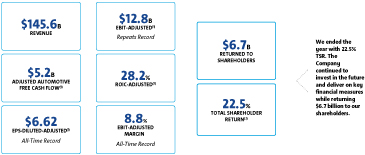
Note: The financial information above relates to our continuing operations.leadership changes:
|
|
| • | Daniel Ammann – Transitioned to Chief Executive Officer of GM Cruise effective January 1, 2019. |
| • | Mark L. Reuss – Assumed additional responsibilities for Global Cadillac as Executive Vice President and President, Global Product Group and Cadillac, effective June 21, 2018. Named President on January 3, 2019, succeeding Daniel Ammann. |
| • | Alan S. Batey – Transitioned to an advisory role effective April 1, 2019, after serving as Executive Vice President and President, North America, since January 15, 2014. |
| u | Compensation Governance and Best Practices |
WHAT WE DO | ||
ü | Provide short-term and long-term incentive plans with performance targets aligned to business goals | |
ü | Conduct annual advisory vote for shareholders to approve executive compensation | |
ü | Maintain a Compensation Committee composed entirely of independent directors | |
ü | Require stock ownership for all senior leaders | |
ü |
| |
ü | Includenon-compete andnon-solicitation terms in all grant agreements with senior leaders | |
ü | Retain an independent executive compensation consultant to the Compensation Committee | |
ü | Maintain
| |
ü | Require equity awards to have a double trigger (termination of employment and change in control) to initiate protection provisions of outstanding awards
| |
ü | Complete an annual incentive compensation risk | |
ü | Maintain a clawback policy | |
ü | Design simple and clear compensation programs that provide senior leaders direct line-of-sight to business goals | |
ü | Conduct an annual audit of senior executive expenses and perquisites | |
| ||
WHAT WE DON’T DO | ||
û
| Providegross-up payments to cover personal income taxes or excise taxes pertaining to executive | |
û
| Allow directors or executives to engage in hedging or pledging of GM securities | |
|
| |
û
| Reward executives for excessive, imprudent, inappropriate, or unnecessary risk-taking | |
û | Allow the repricing or backdating of equity awards | |
 |
Say-on-Pay Voting and Annual Meeting Review Say-on-Pay Voting Meet With Investors Review Feedback and Adjust Plans File Annual Proxy Statement
EXECUTIVE COMPENSATION
| u | Shareholder Engagement Initiatives |
The Company values investor feedback and will continue to seek feedback through engagement initiatives to align our executive compensation programs with shareholder expectations. We view shareholder engagement as an important and continuous cycle. During 2017,In 2018 and early 2019, members of the Board and/or management met in-person with shareholders representing approximately 25%21% of our outstanding common stock. In addition, during 2017, one or more membersstock on a range of management were involvedissues. Through these engagements, we received feedback in more than 75in-personsupport of our existing executive compensation program and, telephonic meetings with investors representing more than 45% of shares outstanding.in particular, the Compensation Committee’s decision to further drive accountability and reinforce our safety culture. These discussions,say-on-pay Say-on-Pay voting results, aligning to the Company vision and strategic goals, and other factors are key drivers in assessingour ongoing assessment of our compensation programs and help shape future programs. As the compensation programs evolve, the Board will remain committed to continuing the dialogue with shareholders on our compensation philosophy and practices.
|
SHAREHOLDER SAY-ON-PAY The Compensation Committee seeks to align the Company’s executive compensation program with the interests of the Company’s shareholders. The Compensation Committee considers the results of the annual
| |||
The Company values investor feedbackSay-on-Pay Voting and will continue to seek feedback through engagement initiatives to align our executive compensation programsAnnual Meeting Review Say-on-Pay Voting Meet with shareholder expectations. We made changes to our compensation plans that commenced at the start of 2017 to further align the interests of our senior leaders with those of our shareholders.Investors Review Feedback and Adjust Plans File Annual Proxy Statement
|
| |
Evaluate ESG Performance | We continue to
| |
Balanced Pay Plans |
Based on the feedback from our investors relating to both our STIP and LTIP,
| |
Measure Relative Performance |
| |
| Our PSUs measure both Relative ROIC-adjusted and Relative TSR against the Company’s OEM peers to
| |
Simple Compensation Plans | We simplified our compensation plans in 2017 and kept the same measures for 2018 to focus our most senior leaders on both key operational performance measures and individual results in the STIP. This change
|
|
2013 2014 2015 2016 2017 Actions We Took Company exited TARP Final year of granting Salary Stock Units, which were vested on date of grant to NEOs Actions We Took Introduced non-compete and non-solicitation terms into all LTIP awards for all Senior Leaders beginning with the Driving Stockholder Value grant Actions We Took STIP – Increased focus on EBIT-Adjusted to drive profitable growth 40% EBIT-Adjusted 25% Adjusted AFCF 10% Global Market Share 25% Global Quality Actions We Took Introduced stock ownership requirements Introduced a performance-based compensation structure with both STIP and LTIP STIP – Performance based on the following measures: 25% EBIT-Adjusted 25% Adjusted AFCF 25% Global Market Share 25% Global Quality LTIP – Structure for NEOs includes 75% PSUs and 25% RSUs PSUs – Performance-based vesting on 100% ROIC Adjusted with a Global Market Share modifier, PSUs vest at the end of the three year performance period RSUs – Time-based vesting in equal tranches over three years Actions We Took STIP – Increased focus on key financial measures and added an individual performance element to incorporate individual performance goals for each NEO 50% EBIT-Adjusted 25% Adjusted AFCF 25% Individual Performance LTIP – Eliminated time-vested RSUs and replaced with Stock Options. NEOs will have a mix of 75% PSUs and 25% Stock Options Incorporated relative performance measures into PSUs Relative ROIC-Adjusted – 50% of LTIP Relative TSR – 25% of LTIP 2017 STIP 2017 LTI
EXECUTIVE COMPENSATION
| u | Compensation Program Evolution |
Our compensation programs have continued to focus our leadersleadership on the key areas that both drive the business forward and align to the short-term and long-term interests of our shareholders. The Compensation Committee regularly reviews and discusses plan performance at each Compensation Committee meeting. The Compensation Committee considers many factors when electing to make plan changes for future incentive plans including results, market trends, feedback from their independent compensation consultant, and investorshareholder feedback. The table below shows howthe actions we have taken to simplify the compensation program has continuedprograms and to evolve toand align the programs with shareholders’ interests.
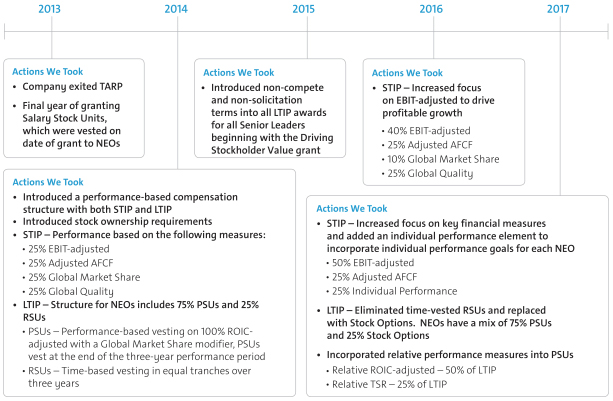
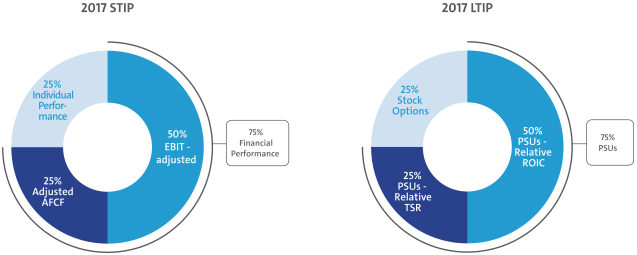
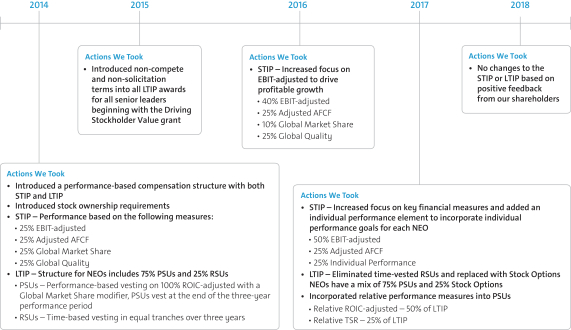
2014 Actions We Took " Introduced a performance-based compensation structure with both STIP and LTIP " Introduced stock ownership requirements" STIP Performance based on the following measures: " 25% EBIT-adjusted " 25% Adjusted AFCF " 25% Global Market Share " 25% Global Quality " LTIP Structure for NEOs includes 75% PSUs and 25% RSUs " PSUs Performance-based vesting on 100% ROIC- adjusted with a Global Market Share modifier, PSUs vest at the end of the three-year performance period " RSUs Time-based vesting in equal tranches over three years 2015 Actions We Took " Introduced non-compete and non-solicitation terms into all LTIP awards for all Senior Leaders beginning with the Driving Stockholder Value grant 2016 Actions We Took " STIP Increased focus on EBIT-adjusted to drive profitable growth " 40% EBIT-adjusted " 25% Adjusted AFCF " 10% Global Market Share " 25% Global Quality 2017 Actions We Took " STIP Increased focus on key financial measures and added an individual performance element to incorporate individual performance goals for each NEO " 50% EBIT-adjusted " 25% Adjusted AFCF " 25% Individual Performance " LTIP Eliminated time-vested RSUs and replaced with Stock Options. NEOs have a mix of 75% PSUs and 25% Stock Options " Incorporated relative performance measures into PSUs " Relative ROIC-adjusted 50% of LTIP " Relative TSR 25% of LTIP 2018 Actions We Took " No changes to the STIP or LTIP based on positive feedback from our shareholders 2018 STIP 2018 LTIP
|
Relative ROIC-Adjusted (50% of LTIP) Relative% PAYOUT Maximum: 200% Payout at 100th Percentile Target: 100% Payout at 60th Percentile Threshold: 50% Payout at 35th Percentile PERCENTILERelative TSR (25% of LTIP)
EXECUTIVE COMPENSATION
% PAYOUT Maximum: 200% Payout at 75th Percentile or Greater Target: 100% Payout at 50th Percentile Threshold: 50% Payout at 25th Percentile PERCENTILE
The Company held engagements with investors and received feedback on changes to both the2018 STIP and LTIP. The 2017 STIP continued a focusfocuses leadership on key financial measures (75% of STIP) and individual performance (25% of STIP). The total payout for the STIP will beranges from 0% to 200% of target based on actual performance againstpre-established goals. The Compensation Committee determineddetermines individual performance using a rigorous assessment process measuring performance againstpre-established operational goals, safety results, and other measures. Threshold performance of at least one financial measure must be met for individual performance payout to be funded at any level.
 | 41 |
EXECUTIVE COMPENSATION
The 20172018 LTIP replaced time-based RSUs withfeatures Stock Options (25% of total LTIP) to further align our most senior leaders with our shareholders’ interest in stock price appreciation. In addition, the Company changed PSUappreciation and PSUs with relative performance measures from ROIC-adjusted with a Global Market Share modifier tothat drive long-term results. The PSUs measure our Relative ROIC-adjusted (50% of total LTIP) and Relative TSR (25% of total LTIP) against.
Focusing performance on key financial measures and individual operational performance measures in the short term, combined with measuring Relative ROIC-adjusted and Relative TSR compared to our OEM peers in the long term, provides direct alignment of our executive compensation program with the interests of our shareholders and focuses senior leaders on making the investments that will provide profitable long-term growth.
| u | Peer Group for 2018-2020 LTIP Performance |
We use the following OEMs in the Dow Jones Automobiles andAutomobile & Parts Titans 30 Index listed below.to measure relative performance for Relative ROIC-adjusted and Relative TSR measures for the 2018-2020 PSU awards.
Dow Jones Automobiles & Parts Titans 30 Index – OEM Peer Group(1)
| ||||
| Hyundai Motor Co. | Renault SA | ||
Daimler AG
| Kia Motors Corp. | Suzuki Motor Corp. | ||
Fiat Chrysler Automobiles NV | Mazda Motor Corp. | Tesla, Inc. | ||
Ford Motor Company
| Nissan Motor Co. Ltd | Toyota Motor Company | ||
Honda Motor Co. Ltd.
| ||||
|
| Volkswagen AG | ||
| (1) |
|
The percentile rank required for each performance level relative to OEM peers and associated payouts for PSUs are displayed below.
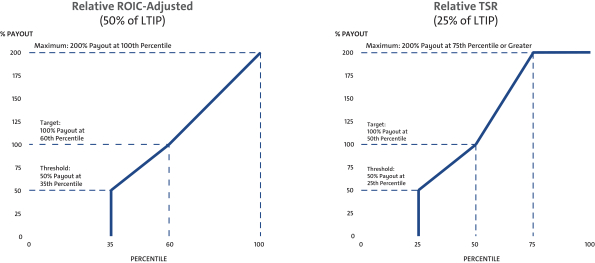
Focusing performance on key financial measures and individual operational performance measures in the short term, combined with performance in both Relative ROIC-adjusted and Relative TSR compared with our other OEM peers in the long term, provides direct alignment of our executive compensation programs with the interests of our shareholders and continues to focus our senior leaders on making the investments that will provide for profitable long-term growth.
|
EXECUTIVE COMPENSATION
| u | Peer Group for Compensation Comparisons |
The Compensation Committee annually reviews the peer group for compensation comparisons and makes updates as needed to align with both the established criteria and Company strategy. We do not limit ourthe peer group to our industry alone because we believe compensation practices for NEOs at other large U.S.-based multinationals affect our ability to attract and retain diverse talent around the globe.
In determining 20172018 compensation, we maintained the same compensation peer group from 2016. Based on the guidelines established by the Compensation Committee forconsiders the following factors when selecting our peer group selection, companies must satisfy each of the following criteria to be considered for the peer group:
Traded on major U.S. exchange
Revenue greater than $25 billion
Significant international revenue
Capital-intensive operations
In addition, the Compensation Committee considers the following factors when selecting our peer group:
Comparable R&D expenditures as a percent of revenue
Technology focused
Durable goods manufacturer
Business/production complexity
Strong brand reputation
| Company | Industry | Company | Industry | |||||||
3M Company
| Industrial Conglomerates
| Honeywell International Inc.
| Aerospace and Defense
| |||||||
The Boeing Company |
Aerospace and Defense |
IBM Corporation | IT Consulting and Other Services | |||||||
Caterpillar Inc. | Construction Machinery and Heavy Trucks |
Intel Corporation |
Semiconductors | |||||||
Deere & Company | Agricultural and Farm Machinery |
Johnson & Johnson |
Pharmaceuticals | |||||||
| Diversified Chemicals
|
|
| |||||||
| Soft Drinks and Food | |||||||||
Ford Motor Company
| Automobile Manufacturers
| Pfizer Inc.
| Pharmaceuticals
| |||||||
General Electric Company |
| The Procter & Gamble Company
|
| Household Products | ||||||
HP, Inc. | Technology Hardware, Storage, and Peripherals
|
United Technologies Corp. |
Aerospace and Defense | |||||||
| (1) |
|
| 42 |
|
EXECUTIVE COMPENSATION
| u | How We Use Comparator Data to Assess Compensation |
We use executive compensation surveys composed of a broad array of industrial companies to benchmark relevant market data for executive positions. In addition, we benchmark pay practices and compensation levels against the proxy statement disclosures of our peer group and adjust this data to reflect GM’s size and market expected compensation trends. Further, we reviewFurthermore, the Compensation Committee reviews an analysis completed by their independent compensation consultant of the competitive market position of each of our executives compared withto the marketbenchmark data.
We review each element of compensation compared with the market and generally target each element of our total direct compensation (base salary, STIP, and LTIP) for the executive group on average to be at or near the market median. However, anAn individual element or an individual’s total direct compensation may be positioned above or below the market median because ofdue to considerations such as his or her specific responsibilities, experience, and performance.
| How We Plan Compensation |

GM MANAGEMENT MakesMANAGEMENTMakes recommendations regarding compensation structure and design Provides input on individual performance and results against key business goals Provides additional information as requested by the Committee COMMITTEE CONSULTANT AdvisesCommitteeCOMMITTEE CONSULTANTAdvises the Committee on competitive benchmarking on pay levels, practices, and governance trends Assists with peer group selection and analysis Reviews and advises on recommendations, plan design, and measures EXECUTIVEmeasuresEXECUTIVE COMPENSATION COMMITTEE ApprovesCOMMITTEEApproves plan design, metrics, and goals Approves overall incentive compensation funding levels Reviews and approves individual targettargets and actual compensation for the most senior executives CEO 2017 COMPENSATION STRUCTURE AVERAGE NEO 2017 COMPENSATION STRUCTURE
EXECUTIVE COMPENSATION

| u | Performance-Based Compensation Structure |
Our NEOs are incentivized to focus on optimizing long-term financial returns for our shareholders through increasing profitability, increasing margins, putting the customer at the center of everything we do, growing the business, and driving innovation.
The performance-based structure for 20172018 incorporates both short-term and long-term incentives established from financial and operational metrics for fiscal year 20172018 and beyond. In addition to base salary and an annualthe STIP award, this structure, shown graphically below, includes an LTIP award made upcomposed of both PSUs and Stock Options in order to focus our executives on long-term Company performance. The Compensation Committee believes a majority of compensation should be in the form of equity to align the interests of executives with those of shareholders.
| 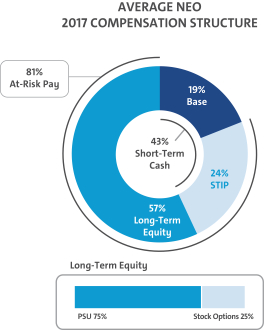  |
CEO 2018 COMPENSATION STRUCTURE 90% At-Risk Pay 10% Base 21% STIP 69% Long-Term Equity 31% Short-Term Cash Long-Term Equity PSU 75% Stock Options 25%AVERAGE NEO 2018 COMPENSATION STRUCTURE 82% At-Risk Pay 18% Base 23% STIP 59% Long-Term Equity 41% Short-Term Cash Long-Term Equity PSU 75% Stock Options 25%
 |
| 43 |
EXECUTIVE COMPENSATION
The compensation provided to our senior leaders continues to be guided by the following principles:
Aligned with Shareholders – Compensation paid should align directly with the long-term interests of our shareholders and our executives should share with them in the performance and value of our common stock;
Performance-Based – Compensation paid should be based on a balance of financial and operational goals reflecting strong financial performance relative to our OEM competitors. The goals should be aggressive but achievable, within our executives’executives control, and should reward commitments met;
Recognize Individual Performance – Compensation paid should motivate executives to perform at their best, reflecting their clear line of sightline-of-sight and contributions as well as their behaviors and demonstration of GM’s core values. Individual performance must be aligned with Company performance and desired behaviors;
Simple Design – Our compensation plan should be easy to understand, and communicate, and minimize unintended consequences;
Avoidance of Incentive to Take Excessive Risk– CompensationThe compensation structure should avoid incentives to take unnecessary andor excessive risk. Compensation should be paid over a period of time that takes into account the potential risk over the same time period;
Appropriate Allocation of Compensation Components – The compensation structure should appropriately allocate total compensation tointo fixed and variable pay elements resulting in an appropriate mix of short-term and long-term pay elements; and
Comparable Target Compensation– Overall target compensation should be competitive (market median) with that paidcompared to individuals at peer group companies so that it attracts, motivates,the Company can attract, motivate, and retainsretain talent.
| u |
|
Each NEO’s 2017The NEOs 2018 compensation structure is market competitive with each pay element targeted at or near the market median. The 2018 compensation structure included the following pay elements:

ELEMENT PURPOSE PERFORMANCE PERIOD PERFORMANCE METRICS PAYOUT Base Salary – NEOs are paid a market-competitive Market-competitive base salary that reflects each NEO’sreflecting contribution, background, knowledge, skills and performance as well as the knowledge and skills he or she brings to the role;
STIP – The STIP is an annualAnnual cash incentive plan. The STIP rewards each NEO based on the achievementachievements of annual Company financial goals and individual performance results. The potential payout ranges fromOne Year 1/1/2018 -12/31/2018 EBIT-adjusted, Adjusted AFCF, and Individual Performance 0% to 200% of target, based on actual Company performance and individual performance;
PSUs –-200% PSUs are equity awards designed to align each NEO’sAlign NEOs interests with the long-term interests of the Company and its shareholders. PSUs can be earned at a level from 0% to 200% of target, based on the actual Company performance againstshareholders Three Year 1/1/2018 -12/31/2020 Relative ROIC-adjusted and Relative TSR over the three-year performance period beginning January 1, 2017; and
0%-200% Stock Options – Stock options are time-based equity awards vesting ratably over a three-year period. Stock options align the Align NEOs interests of our most senior executives with our shareholders’and shareholders interest in stock price appreciation and allow our leaders to share in the gains with shareholders.Three Year Vesting Ratably 10 Year Term Absolute stock price appreciation
| u | Perquisites and Other Compensation |
We provide perquisites and other compensation to our NEOs consistent with market practices. The following perquisites and other compensation were provided to NEOs in 2017:2018:
Personal Air Travel – Ms. Barra is prohibited by Company policy from commercial air travel due to security reasons identified by an independent third-party security consultant. As a result, the Company pays the costs associated with the use of private aircraft for both business and personal use. Ms. Barra is permitted to be accompanied by guests for personal travel and incurs imputed income for all passengers, including herself, at the U.S. Internal Revenue Service (the “IRS”) Standard Industry Fair Level rates. Other NEOs may travel on private aircraft in certain circumstances with prior approval from the CEO or the Senior Vice President, Global Human Resources, and alsoResources. All NEOs incur imputed income for any personal travel.
| 44 |
|
EXECUTIVE COMPENSATION
Company Vehicle Programs – NEOs are eligible to participate in the Executive Company Vehicle Program and are allowed tomay use evaluation vehicles for the purpose of providing feedback on Company products. In addition, NEOs are eligible to use driver services provided by the Company and in accordance with Company policies.
|
EXECUTIVE COMPENSATION
Security – NEOs may receive security services, including home security systems and monitoring, for specific security-related reasons identified by independent third-party security consultants. We maintain security staff in order to provide all employees with a safe and secure environment to align with and reinforce our safety culture.
Financial Counseling– NEOs are eligible to receive financial counseling, estate planning, and tax preparation services through an approved provider.
Executive Physicals – NEOs are eligible to receive executive physicals with an approved providers.provider.
| u |
|
Our target total direct compensation for each NEO in 20172018 was as follows:
Annual Base Salary ($)
| STIP (%)
| STIP ($)
| Target Total Cash Compensation ($)
|
LTIP
| Target Total Compensation ($)
| Base Salary ($) | STIP (%) | STIP ($) | Target Total Cash Compensation ($) | LTIP | Target Total Compensation ($) | |||||||||||||||||||||||||||||||||||||||||||||||||||||||||||||
Name
| PSUs(2) ($)
| Stock ($)
| PSUs(1) ($) | Stock ($) | ||||||||||||||||||||||||||||||||||||||||||||||||||||||||||||||||||||
Mary T. Barra
|
|
2,100,000
|
|
|
200
|
%
|
|
4,200,000
|
|
|
6,300,000
|
|
|
9,750,000
|
|
|
3,250,000
|
|
|
19,300,000
|
|
| 2,100,000 |
|
| 200 | % |
| 4,200,000 |
|
| 6,300,000 |
|
| 10,275,000 |
|
| 3,425,000 |
|
| 20,000,000 |
| ||||||||||||||||||||||||||||||
Charles K. Stevens, III
|
|
1,100,000
|
|
|
125
|
%
|
|
1,375,000
|
|
|
2,475,000
|
|
|
2,793,750
|
|
|
931,250
|
|
|
6,200,000
|
| |||||||||||||||||||||||||||||||||||||||||||||||||||
Dhivya Suryadevara |
| 900,000 |
|
| 125 | % |
| 1,125,000 |
|
| 2,025,000 |
|
| 2,231,250 |
|
| 743,750 |
|
| 5,000,000 |
| |||||||||||||||||||||||||||||||||||||||||||||||||||
Daniel Ammann
|
|
1,450,000
|
|
|
125
|
%
|
|
1,812,500
|
|
|
3,262,500
|
|
|
3,703,125
|
|
|
1,234,375
|
|
|
8,200,000
|
|
| 1,450,000 |
|
| 125 | % |
| 1,812,500 |
|
| 3,262,500 |
|
| 3,703,125 |
|
| 1,234,375 |
|
| 8,200,000 |
| ||||||||||||||||||||||||||||||
Mark L. Reuss
|
|
1,200,000
|
|
|
125
|
%
|
|
1,500,000
|
|
|
2,700,000
|
|
|
3,037,500
|
|
|
1,012,500
|
|
|
6,750,000
|
|
| 1,200,000 |
|
| 125 | % |
| 1,500,000 |
|
| 2,700,000 |
|
| 3,037,500 |
|
| 1,012,500 |
|
| 6,750,000 |
| ||||||||||||||||||||||||||||||
Alan S. Batey
|
|
1,025,000
|
|
|
125
|
%
|
|
1,281,300
|
|
|
2,306,300
|
|
|
2,020,275
|
|
|
673,425
|
|
|
5,000,000
|
|
| 1,025,000 |
|
| 125 | % |
| 1,281,300 |
|
| 2,306,300 |
|
| 2,020,275 |
|
| 673,425 |
|
| 5,000,000 |
| ||||||||||||||||||||||||||||||
Karl-Thomas Neumann(1)
|
|
1,050,000
|
|
|
125
|
%
|
|
1,312,500
|
|
|
2,362,500
|
|
|
1,781,250
|
|
|
593,750
|
|
|
4,737,500
|
| |||||||||||||||||||||||||||||||||||||||||||||||||||
Charles K. Stevens, III |
| 1,100,000 |
|
| 125 | % |
| 1,375,000 |
|
| 2,475,000 |
|
| 3,018,750 |
|
| 1,006,250 |
|
| 6,500,000 |
| |||||||||||||||||||||||||||||||||||||||||||||||||||
| (1) |
|
The number of PSUs awarded is determined by using the target PSU value divided by the closing price on the date of grant. PSUs with performance tied to |
| u | How We Set Performance Targets |
Annually, the Compensation Committee approves the performance measures for the STIP and LTIP. The Compensation Committee reviews recommendations from management, receives input from the Compensation Committeetheir independent compensation consultant, evaluates the annual budget and mid termmid-term business plan, and reviews prior-year performance to approve value-creating goals tied to long-term shareholder value.
| u |
|
The STIP aligns with our plans to create the world’s most valued automotive company and to increase shareholder value. The STIP rewards NEOs for performance linked to the Company’s achievement of annual financial goals, operational performance goals, and individual performance results. The STIP is an annual cash incentive award intended to be deductible as performance-based compensation under U.S. Internal Revenue Code (“IRC”) Section 162(m) and is funded for each covered NEO once the Company achieves the threshold of positive EBIT-adjusted.
The Compensation Committee annually reviews and approves STIP goals to assess the difficulty in level of achievement and overall linkage tothat align with shareholders through the achievement of the business plan and strategic objectives. For the 20172018 STIP all targets were challenging goals set at or above final 2016 performance. The Committee elected to adjust the weights to increase EBIT-adjusted to 50% and removed both global Market Share and Global Quality as overall measures. The Committee addedbeginning of the performance period based on the business plan. Individual performance is assessed using an individual performance with a weightscorecard measuring results againstpre-established goals that the Compensation Committee approves at the beginning of 25% as a measure to evaluate individual performance for each leader.the year. Individual performance results and final individual compensation decisions are discussed beginning on page 48. Individual performance is assessed with an individual performance scorecard measuring results againstpre-established goals that the Committee approves at the beginning of the year. Global market share and global quality are still focus items that the Committee considers when evaluating individual performance results.49.
|
EXECUTIVE COMPENSATION
Actual STIP awards, if any, are determined following the completion of the plan year to reflect the achievementfinal Company performance against the performance measures displayed below.below and the Compensation Committee’s assessment of individual performance. The table below describes each STIP performance measure, its weighting, its target, and the behaviors each measure drives:
STIP Measure
| Weight
| Target
| Leadership Behaviors
| Weight | Target | Leadership Behaviors | ||||||||||||
EBIT-adjusted
|
|
50%
|
|
|
$12.7
|
|
Focus on operating profit and driving strong profitability
| |||||||||||
Adjusted AFCF (1)
|
|
25%
|
|
|
$ 6.3
|
|
Focus on driving strong cash flow to invest in the business
| |||||||||||
EBIT-adjusted ($B)(1) | 50% | $ | 12.9 |
| Focus on operating profit and driving strong profitability | |||||||||||||
Adjusted AFCF ($B)(1)(2) | 25% |
| $5.4 |
| Focus on driving strong cash flow to invest in the business | |||||||||||||
Individual Performance
|
|
25%
|
|
|
25 pts.
|
|
Focus on individual performance goals that impact business results
| 25% |
| 25 pts. |
| Focus on individual performance goals and behaviors that impact business results | ||||||
| (1) | Measure adjusted for incentive purposes and excludes certain business operations. |
| (2) | Adjusted AFCF for incentive purposes excludes payments related to certain recall-related expenses attributable to events occurring in 2014. For a description of how Adjusted AFCF is calculated, see Appendix A. |
 | 45 |
EXECUTIVE COMPENSATION
The potential payouts for each companyCompany performance measure rangeranges from 0% to 200% of target, based on actual Company performance, with the threshold performance level being 50% of eachEBIT-adjusted and 39% of Adjusted AFCF. Final STIP measure. The STIP calculation for the 2017 performance period determined the result for each NEO:awards are calculated as follows:
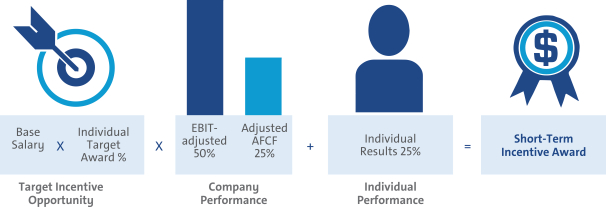

Base Salary x Individual Target Award % Target Incentive Opportunity x EBIT-adjusted 50% Adjusted AFCF 25% Company Performance + Individual Results 25% Individual Performance = Short-Term Incentive Award
| u |
|
Grants under the LTIP are intended to link the financial interests of NEOs with the long-term interests of shareholders. The structure for NEOs includedincludes 75% PSUs and 25% Stock Options. PSUs cliff-vest following thea three-year performance period and Stock Options vest ratably over three years.
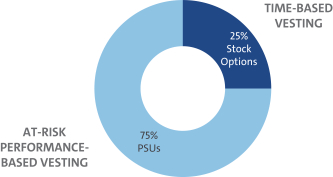
The 2017–20192018–2020 PSUs arewill be awarded based on performance against the following measures relative to our OEM peers: Relative ROIC-adjusted and Relative TSR over the three-year performance period. Theagainst our OEM peers displayed on page 42. PSU performance measures were chosen to promote boththe efficient use of capital andfor long-term growth to create value for the shareholders andwith an increased focus on stock price appreciation. The following table shows the PSU performance measures and the leadership behaviors that each drives to make GM the world’s most valued automotive company:measure drives:
|
| ||||||||
| PSU Weight | Payout | Leadership Behaviors | ||||||
Relative ROIC-adjusted | 67% | Threshold (50%) – 35th Percentile Target (100%) – 60th Percentile Maximum (200%) – 100th Percentile |
Focus on making sound investments that follow the disciplined capital approach of driving 20% or higher returns in world-class vehicles and leading technology
| ||||||
Relative TSR | 33% | Threshold (50%) – 25th Percentile Target (100%) – 50th Percentile Maximum (200%) – 75th Percentile | Focus on delivering shareholder returns that outperform our OEM peers | ||||||
|
|
EXECUTIVE COMPENSATION
PSUs, if any, vest and are awarded and delivered following the completion of the three-year performance period beginning January 1, 2017 through December 31, 2019,2018 and may be earned at a level between 0% and 200% of target based on actual Company results. When determining grant amounts, the Compensation Committee considers factors such as individual responsibilities, experience, and performance. In addition, the Compensation Committee will factor infactors relevant market compensation comparison data and seek theseeks input from their independent compensation consultant.Finalconsultant. Final PSU awards are calculated as follows:
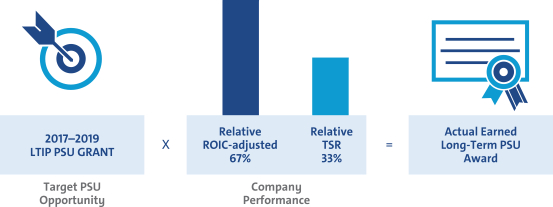
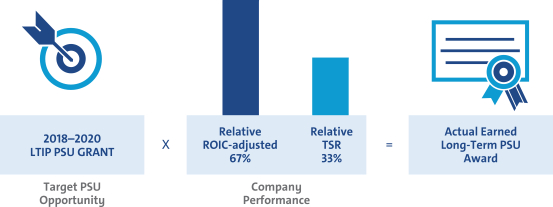
20182020 LTIP PSU GRANT Target PSU Opportunity x Relative ROIC-adjusted 67% Relative TSR 33% Company Performance = Actual Earned Long-Term PSU Award
| 46 |
|
EXECUTIVE COMPENSATION
| u | Summary of Outstanding Performance Awards |
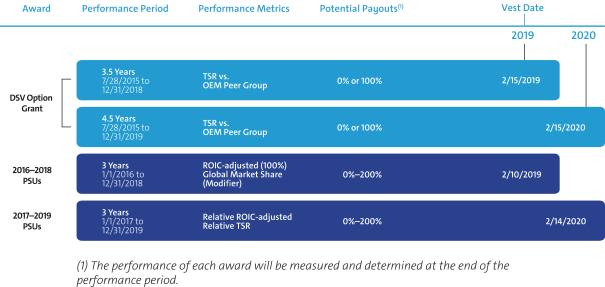
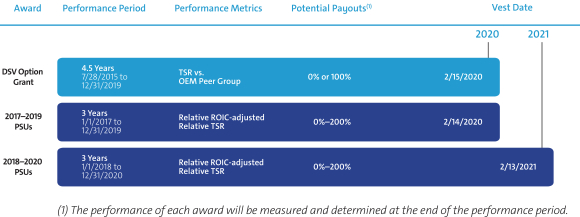
|
EXECUTIVE COMPENSATION
Award Performance Period Performance Metrics Potential Payouts (1) Vest Date 2020 2021 DSV Option Grant 7/28/2015 4.5 Years to 12/31/2019 TSR vs. OEM Peer Group 0% or 100% 2/15/2020 20172019 PSUs 1/1/2017 3 Years to 12/31/2019 Relative ROIC-adjusted Relative TSR 0%200% 2/14/2020 20182020 PSUs 1/1/2018 3 Years to 12/31/2020 Relative ROIC-adjusted Relative TSR 0%200% 2/13/2021 (1) The performance of each award will be measured and determined at the end of the performance period.
Performance Results and Compensation Decisions
| u |
|
The Company portion of the 20172018 STIP award was calculated based on the Company’s achievement of the following performance measures: EBIT-adjusted and Adjusted AFCF.AFCF performance measures. In addition, each NEO has an individual performance portion of their STIP that measures performance againstpre-established goals. CompanyFinal STIP performance including the individual results achieved the following results, as approved by the Compensation Committee. The results for EBIT-adjusted repeated GM’s 2016 record performance:Committee is displayed below:
STIP Measure
|
Weight
|
Threshold
|
Target
|
Maximum
|
Performance Results
|
Performance Payout
| Weight
| Threshold
| Target
| Maximum
| Performance Results
| Performance Payout
| ||||||||||||||||||||||||||||||||||||
EBIT-adjusted ($B)
|
|
50%
|
|
|
$ 6.8
|
|
|
$ 12.7
|
|
|
$ 14.0
|
|
|
$ 12.8
|
|
|
54
|
%
| ||||||||||||||||||||||||||||||
Adjusted AFCF ($B) (1)
|
|
25%
|
|
|
$ 0.0
|
|
|
$ 6.3
|
|
|
$ 7.3
|
|
|
$ 5.6
|
|
|
24
|
%
| ||||||||||||||||||||||||||||||
EBIT-adjusted ($B)(1) |
| 50% |
|
| $7.0 |
|
| $12.9 |
|
| $14.2 |
|
| $12.5 |
|
| 48 | % | ||||||||||||||||||||||||||||||
Adjusted AFCF ($B)(1)(2) |
| 25% |
|
| $0.0 |
|
| $5.4 |
|
| $6.4 |
|
| $4.7 |
|
| 23 | % | ||||||||||||||||||||||||||||||
Individual Performance
|
|
25%
|
|
|
0 pts.
|
|
|
25 pts.
|
|
|
50 pts.
|
|
|
25 – 40 pts.
|
|
|
25%–40
|
%
|
| 25% |
|
| 0 pts. |
|
| 25 pts. |
|
| 50 pts. |
|
| 25 – 35 pts. |
|
| 25%–35 | % | ||||||||||||
Result |
|
103%–118 |
% |
| 96%–106 | % | ||||||||||||||||||||||||||||||||||||||||||
| (1) | Measure adjusted for incentive purposes and excludes certain business operations. |
| (2) | Adjusted AFCF for incentive purposes excludes payments related to certain recall-related expenses attributable to events occurring in 2014. Final performance result excludes $0.6B inpre-funding payments to certainnon-U.S. pensions in Q3 2018. For a description of how Adjusted AFCF is calculated, see Appendix A. |
Despite significant incremental commodity and foreign exchange headwinds, the Company delivered strong performance in 2018. As demonstrated by the results above, the Compensation Committee continues to set challenging performance targets.
| u |
|
The 2015–20172016–2018 PSU awards vested on February 11, 2018,10, 2019, based on Company performance for the three-year period beginning January 1, 2015 through December 31, 20172016, againstpre-established performance targets for both ROIC-adjusted and the Global Market Share modifier. The following performance was approved by the Compensation Committee:
LTIP Measure
|
Weight
|
Threshold
|
Target
|
Maximum
|
Performance Results
|
Performance Payout
| Weight | Threshold | Target | Maximum | Performance Results | Performance Payout | ||||||||||||||||||||||||||||||||||||
ROIC-adjusted
|
|
100%
|
|
|
16.0%
|
|
|
20.0%
|
|
|
24.0%
|
|
|
28.1
|
%(1)
|
|
200
|
%
|
| 100% |
|
| 12.0% |
|
| 20.0% |
|
| 28.0% |
|
| 27.3 | %(1) |
| 191 | % | ||||||||||||
Result |
|
200 |
%(2) |
| 166 | %(2) | ||||||||||||||||||||||||||||||||||||||||||
| (1) | Represents the average of ROIC-adjusted for |
| (2) | The |
 | 47 |
EXECUTIVE COMPENSATION
Focusing our leadersleadership on ROIC-adjusted has resulted in significant performance improvements since calendar year 2012, when ROIC-adjusted was 16.0% at which time we set an enduring target of. The Company continues to focus on delivering 20% based on commitment to shareholders.or higher ROIC-adjusted results. We ended calendar year 20172018 with a ROIC-adjusted of 28.2%24.9%. Despite external pressures impacting TSR over the 2016-2018 performance period, we continued to meet our ROIC commitments while investing in the future. The 2017–20192016-2018 PSUs focus leaders not onlyare the final awards that measure absolute ROIC-adjusted. Beginning with the 2017-2019 PSUs, performance is measured on delivering improvedRelative ROIC-adjusted results, but also on beingand Relative TSR against OEM peers from the top automotive OEM for ROIC-adjusted results.Dow Jones Automobiles & Parts Titans 30 Index.
| u |
|
The DSV option grant was aone-time grant made on July 28, 2015, to senior leaders to securenon-compete andnon-solicitation terms and to drive an increased focus on stock price appreciation. The DSV option grant featured 40% time-based vesting, which vested on February 15, 2017, and 60% performance-based vesting. The performance-based portionvesting that vests upon meeting or exceeding the median TSR relative to the OEM peer group in place on the date of grant. 20%Shown below are the results of two of the DSV option grant vested based on relative TSR performance for the period July 28, 2015–December 31, 2017 and 40% of the overall awardthree performance-based tranches. The final 20% tranche remains outstanding with the performance periodsperiod ending on December 31, 2018, and December 31, 2019.
DSV Measure
|
Performance Period
|
Vesting Date
|
Weight
|
Target TSR
|
Result
|
Vesting
| Performance Period | Vesting Date | Weight | Target TSR | Result | Vesting | ||||||||||||||||||||||||||||||||||||
Relative TSR |
|
July 28, 2015–December 31, 2017 |
|
|
February 15, 2018 |
|
|
20 |
% |
|
50th Percentile |
|
|
87th Percentile |
|
|
100 |
% |
| July 28, 2015–December 31, 2018 |
|
| February 15, 2019 |
|
| 20 | % |
| 50th Percentile |
|
| 88th Percentile |
|
| 100 | % | ||||||||||||
Relative TSR |
| July 28, 2015–December 31, 2017 |
|
| February 15, 2018 |
|
| 20 | % |
| 50th Percentile |
|
| 87th Percentile |
|
| 100 | % | ||||||||||||||||||||||||||||||
|
|
EXECUTIVE COMPENSATION
| u | Compensation Decisions for Mary T. Barra |
Mary T. Barra, Chairman and Chief Executive Officer
Ms. Barra’s 2018 performance
Core u u u Navigated significant headwinds to deliver $147.0B in Revenue, $11.8B in EBIT-adjusted, andEPS-diluted-adjusted of $6.54 while positioning GM to lead in the future u Achieved u u u u
the U.S. u Introduced the u Named one of America’s Most JUST Companies according toForbes and JUST Capital u Earned the most Wildlife Habitat Council Conservation Certification sites at 75, leading the industry Transformation u Reaffirmed strategy towards a world with zero crashes, zero emissions, and zero
u Announced u Advanced our strategy to deploy self-driving vehicles in u u u u
| ||||||
The Compensation Committee held Ms. Barra’s base salary at $2,100,000 based on the competitive market analysis provided by the Compensation Committee’s independent compensation consultant. In February 2018, the Compensation Committee awarded Ms. Barra an annual LTIP grant of $13.7 million, consisting of 75% PSUs and 25% Stock Options. The Compensation Committee awarded Ms. Barra 35 points based on her results, highlighted above, for the 2018 STIP performance year. The total compensation for Ms. Barra in 2018, including salary, STIP, and LTIP awards, is displayed below. | ||||||
Pay Element | Majority of Pay Is At-Risk | Awarded Value | ||||
Base Salary | Only Fixed Pay Element | $ 2,100,000 | ||||
STIP | Performance to Metrics | $ 4,452,000 | ||||
PSUs(1) | Performance to Metrics and Stock Price | $11,081,760 | ||||
Stock Options(2) | Performance to Stock Price | $ 3,425,006 | ||||
TOTAL | $21,058,766 | |||||
(1) PSUs are subject to performance vesting; value reflects grant date fair value at target performance for Relative ROIC-adjusted awards and probable performance results from the Monte Carlo analysis to value Relative TSR awards. (2) Stock Options are subject to time-based vesting. | ||||||
Effective January
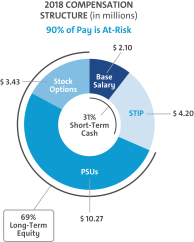
2018 COMPENSATION STRUCTURE (in millions) 90% of Pay is At-Risk $ 3.43 Stock Options $ 2.10 Base Salary 31% Short-Term Cash STIP $ 4.20 PSUs $ 10.27 69% Long-Term Equity

HISTORIC AWARDED VALUE (in millions) $21.8 $21.0 $21.1 2016 2017 2018 Awarded Value
Awarded value reflects the amount included in the Summary Compensation Table, excluding change in pension value and all other compensation.
 | 49 |
EXECUTIVE COMPENSATION
| u | Compensation Decisions for Dhivya Suryadevara |
Dhivya Suryadevara, Executive Vice President and Chief Financial Officer
2018 performance highlights for Ms. Suryadevara include:
| u | Furthered progress towards creating a safety culture through various initiatives |
| u | Navigated significant headwinds to deliver $147.0B in Revenue, $11.8B in EBIT-adjusted, 8% EBIT-adjusted margin, 24.9% ROIC-adjusted, andEPS-diluted-adjusted of $6.54 while positioning GM to lead in the future |
| u | Completed $6.5B cost savings program by 2018 per target, resulting in improved margins |
| u | Instilled an increased focus on free cash flow Company-wide |
| u | Played an integral role in the SoftBank and Honda investments in GM Cruise |
| u | Accelerated GM’s transformation, expected to increase annual adjusted AFCF by $6B byyear-end 2020 on arun-rate basis |
| u | Improved investor relations outreach and perception |
Ms. Suryadevara was promoted to Executive Vice President and Chief Financial Officer effective September 1, 2017, the2018. The Compensation Committee increased Ms. Barra’sdetermined a base salary from $2,000,000 to $2,100,000of $900,000 based on her performance, leadership, and the competitive market analysis provided by the Compensation Committee’s independent compensation consultant. For 2017,In February 2018, Ms. Suryadevara was awarded an annual LTIP grant of $0.74 million. In October 2018, following her promotion, the Compensation Committee awarded Ms. Barra an annual equityadditional LTIP grant of $13 million consisting$2.45 million. Both grants consisted of 75% PSUs and 25% Stock Options. These changes placed Ms. Barra in line with the compensation peer group, as her targeted total direct compensation remained competitive at the market median.
The Compensation Committee awarded Ms. Barra 40Suryadevara 35 points based on her results, highlighted above, for the 20172018 STIP performance year. The total compensation for Ms. BarraSuryadevara in 2017,2018, including salary, STIP, and LTIP awards, is displayed below.
Pay Element
|
Majority of Pay IsAt-Risk
|
Awarded Value
| ||||
Base Salary
|
Only Fixed Pay Element
|
|
$
|
| ||
STIP
|
Performance to Metrics
|
|
$
|
| ||
PSUs(1)
|
Performance to Metrics and Stock Price
|
|
$
|
| ||
Stock Options(2)
|
Performance to Stock Price
|
|
$
|
| ||
TOTAL
|
|
$
|
| |||
| (1) | PSUs are subject to performance vesting; value reflects grant date fair value at target performance for Relative ROIC-adjusted awards and probable performance results from the Monte Carlo analysis to value Relative TSR awards. |
| (2) | Stock Options are subject to time-based vesting. |

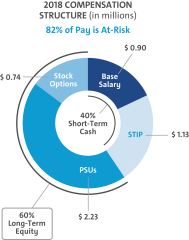
2018 COMPENSATION STRUCTURE (in millions) 82% of Pay is At-Risk $ 0.74 Stock Options $ 0.90 Base Salary 40% Short-Term Cash PSUs $ 2.23 STIP $ 1.13 60% Long-Term Equity

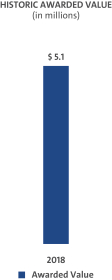
HISTORIC AWARDED VALUE (in millions) $ 5.1 2018 Awarded Value
Awarded value reflects the amount included in the Summary Compensation Table, excluding change in pension value and all other compensation. Realized compensation includes base salary, earned STIP, and all options exercised and stock vested during the year. 2017 realized compensation increased relative to the prior year reflecting 1) the vesting of the PSU award granted to Ms. Barra in 2014, the year she was promoted to her current role; and 2) an increase in stock price at the time of vesting versus the prior year.
|
EXECUTIVE COMPENSATION
|
Charles K. Stevens, III, Executive Vice President and Chief Financial Officer
2017 performance highlights for Mr. Stevens include:
|
|
|
|
|
|
The Compensation Committee kept Mr. Stevens’ base salary at $1,100,000 based on the competitive market analysis provided by the Compensation Committee’s independent compensation consultant. For 2017, the Compensation Committee awarded Mr. Stevens an annual equity grant of $3.725 million, consisting of 75% PSUs and 25% Stock Options.
The Compensation Committee awarded Mr. Stevens 40 points based on his results, highlighted above, for the 2017 performance year. The total compensation for Mr. Stevens in 2017, including salary, STIP and LTIP awards, is displayed below.
|
|
| ||||
|
|
| ||||
|
|
| ||||
|
|
| ||||
|
|
| ||||
|
| |||||
|
|
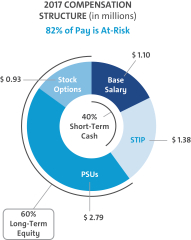

Awarded value reflects the amount included in the Summary Compensation Table, excluding change in pension value and all other compensation. Realized compensation includes base salary, earned STIP, and all options exercised and stock vested during the year. 2017 realized compensation increased relative to the prior year reflecting 1) the vesting of the PSU award granted to Mr. Stevens in 2014, the year he was promoted to his current role; and 2) an increase in stock price at the time of vesting versus the prior year.
|
EXECUTIVE COMPENSATION
| u | Compensation Decisions for Daniel Ammann |
Daniel Ammann, President
20172018 performance highlights for Mr. Ammann include:
| u |
|
| u | Navigated significant headwinds to deliver $147.0B in Revenue, $11.8B in EBIT-adjusted, andEPS-diluted-adjusted of $6.54 while positioning GM to lead in the |
| u | Achieved ROIC-adjusted result of |
| u | Continued to |
| u | Successfully |
| u |
|
|
| u |
|
| u |
|
|
The Compensation Committee keptheld Mr. Ammann’s base salary at $1,450,000 based on the competitive market analysis provided by the Compensation Committee’s independent compensation consultant. For 2017,In February 2018, the Compensation Committee awarded Mr. Ammann an annual equityLTIP grant of $4.94 million, consisting of 75% PSUs and 25% Stock Options. Mr. Ammann’s 2018 compensation structure remained the same as his 2017 compensation structure.
The Compensation Committee awarded Mr. Ammann 4035 points based on his results, highlighted above, for the 20172018 STIP performance year. The total compensation for Mr. Ammann in 2017,2018, including salary, STIP, and LTIP awards, is displayed below.
Pay Element
|
Majority of Pay IsAt-Risk
|
Awarded Value
| ||||
Base Salary
|
Only Fixed Pay Element
|
|
$1,450,000
|
| ||
STIP
|
Performance to Metrics
|
|
$
|
| ||
PSUs(1)
|
Performance to Metrics and Stock Price
|
|
$
|
| ||
Stock Options(2)
|
Performance to Stock Price
|
|
$
|
| ||
TOTAL
|
|
$
|
| |||
| (1) | PSUs are subject to performance vesting; value reflects grant date fair value at target performance for Relative ROIC-adjusted awards and probable performance results from the Monte Carlo analysis to value Relative TSR awards. |
| (2) | Stock Options are subject to time-based vesting. |
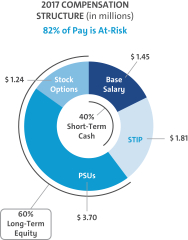
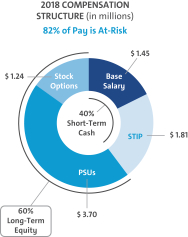
2018 COMPENSATION STRUCTURE (in millions) 82% of Pay is At-Risk $ 1.24 Stock Options $ 1.45 Base Salary 40% Short-Term Cash STIP $ 1.81 PSUs $ 3.70 60% Long-Term Equity

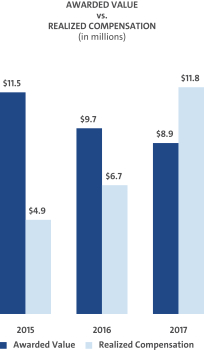
HISTORIC AWARDED VALUE (in millions) $9.7 $8.9 $8.6 2016 2017 2018 Awarded Value
Awarded value reflects the amount included in the Summary Compensation Table, excluding change in pension value and all other compensation. Realized compensation includes base salary, earned STIP, and all options exercised and stock vested during the year. 2017 realized compensation increased relative to the prior year reflecting 1) the vesting of the PSU award granted to Mr. Ammann in 2014, the year he was promoted to his current role; and 2) an increase in stock price at the time of vesting versus the prior year.
 |
| 51 |
EXECUTIVE COMPENSATION
| u | Compensation Decisions for Mark L. Reuss |
Mark L. Reuss, Executive Vice President and President, Global Product Development,Group and
Purchasing and Supply ChainCadillac
20172018 performance highlights for Mr. Reuss include:
| u |
|
| u |
|
| u | Launched 14 vehicles globally, including the Bolt AV, the Chevrolet Silverado, and the GMC Sierra |
| u | Successfully completed insourcing initiatives, reducing overall costs |
| u | Partnered with Autodesk to introduce the next generation of |
| u | Received the IHS Automotive Loyalty Award for the |
| u |
|
| u |
|
|
|
| u | Launched |
| u |
|
| u |
|
| u | Continued the plans for global electrification with |
The Compensation Committee keptheld Mr. Reuss’ base salary at $1,200,000 based on the competitive market analysis provided by the Compensation Committee’s independent compensation consultant. For 2017,In February 2018, the Compensation Committee awarded Mr. Reuss an annual equityLTIP grant of $4.05 million, consisting of 75% PSUs and 25% Stock Options. Mr. Reuss’ 2018 compensation structure remained the same as his 2017 compensation structure.
The Compensation Committee awarded Mr. Reuss 4035 points based on his results, highlighted above, for the 20172018 STIP performance year. The total compensation for Mr. Reuss in 2017,2018, including salary, STIP, and LTIP awards, is displayed below.
Pay Element
|
Majority of Pay IsAt-Risk
|
Awarded Value
| ||||
Base Salary
|
Only Fixed Pay Element
|
|
$1,200,000
|
| ||
STIP
|
Performance to Metrics
|
|
$
|
| ||
PSUs(1)
|
Performance to Metrics and Stock Price
|
|
$
|
| ||
Stock Options(2)
|
Performance to Stock Price
|
|
$1,012,504
|
| ||
|
| |||||
|
|
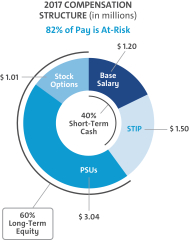
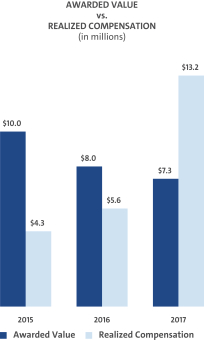
Awarded value reflects the amount included in the Summary Compensation Table, excluding change in pension value and all other compensation. Realized compensation includes base salary, earned STIP, and all options exercised and stock vested during the year. 2017 realized compensation increased relative to the prior year reflecting 1) the vesting of the PSU award granted to Mr. Reuss in 2014, the year he was promoted to his current role; and 2) an increase in stock price at the time of vesting versus the prior year.
| ||||||||
EXECUTIVE COMPENSATION
|
Alan S. Batey, Executive Vice President & President, North America
2017 performance highlights for Mr. Batey include:
|
|
|
|
|
|
|
Effective January 1, 2017, Mr. Batey’s base salary was increased from $950,000 to $1,025,000. The increase was supported by the competitive market analysis provided by the Compensation Committee’s independent compensation consultant. For 2017, the Compensation Committee awarded Mr. Batey an annual equity grant of $2.69 million, consisting of 75% PSUs and 25% Stock Options.
The Compensation Committee awarded Mr. Batey 35 points based on his results, highlighted above, for the 2017 performance year. The total compensation for Mr. Batey in 2017, including salary, STIP and LTIP awards, is displayed below.
|
|
| ||||
|
|
| ||||
|
|
| ||||
|
|
| ||||
|
|
| ||||
TOTAL
|
|
$
|
| |||
| (1) | PSUs are subject to performance vesting; value reflects grant date fair value at target performance for Relative ROIC-adjusted awards and probable performance results from the Monte Carlo analysis to value Relative TSR awards. |
| (2) | Stock Options are subject to time-based vesting. |

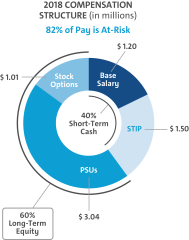
2018 COMPENSATION STRUCTURE (in millions) 82% of Pay is At-Risk $ 1.01 Stock Options $ 1.20 Base Salary 40% Short-Term Cash STIP $ 1.50 PSUs $ 3.04 60% Long-Term Equity
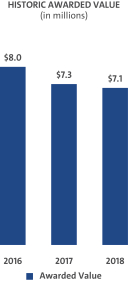
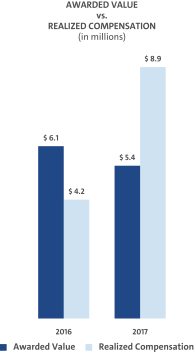
Awarded value reflects the amount included in the Summary Compensation Table, excluding change in pension value and all other compensation. Realized compensation includes base salary, earned STIP, and all options exercised and stock vested during the year. 2017 realized compensation increased relative to the prior year reflecting 1) the vesting of the PSU award granted to Mr. Batey in 2014, the year he was promoted to his current role; and 2) an increase in stock price at the time of vesting versus the prior year.
| 52 |
|
EXECUTIVE COMPENSATION
| u | Compensation Decisions for |
Karl-Thomas Neumann, Alan S. Batey, Former Executive Vice President &and President, EuropeNorth America
2018 performance highlights for Mr. Batey include:
u | Furthered progress towards creating a safety culture through various initiatives |
u | Achieved fifth consecutive year of pickup truck sales leadership in the U.S. |
u | Led all automakers by delivering 1.3 million crossovers and SUVs in the U.S. |
u | Sold more than 134,800 units of the Chevrolet Colorado in the U.S., its best year yet |
u | Achieved EBIT-adjusted of $10.8B and EBIT-adjusted margins of 9.5% in North America |
u | Delivered record Average Transaction Prices in the U.S. of nearly $36,000 for 2018 |
u | Maintained our leadership position as the #1 OEM in Canada |
u | Doubled the accessories business in North America since 2013 |
u | Continue to drive participation in GM Loyalty rewards |
u | Received the IHS Automotive Loyalty Award for the fourth straight year |
Effective January 1, 2017, Dr. Neumann’sThe Compensation Committee held Mr. Batey’s base salary was€811,864 supported byat $1,025,000 based on the competitive market analysis provided by the Compensation Committee’s independent compensation consultant. For 2017,In February 2018, the Compensation Committee awarded Dr. NeumannMr. Batey an annual equityLTIP grant of $2.37$2.69 million, consisting of 75% PSUs and 25% Stock Options. Mr. Batey’s 2018 compensation structure remained the same as his 2017 compensation structure.
Based on performance to goals for 2017, theThe Compensation Committee awarded Dr. NeumannMr. Batey 25 points based on his results, highlighted above, for histhe 2018 STIP performance assessment under the STIP. In addition, the Committee awarded Dr. Neumann aone-time transaction success incentive (“TSI”) award for his efforts in leading the Opel/Vauxhall organization through the close of the sale to PSA.year. The total compensation for Dr. NeumannMr. Batey in 2017,2018, including salary, bonus, STIP, and LTIP awards, is displayed below.
Pay Element |
Majority of Pay IsAt-Risk |
Awarded Value | ||||
Base Salary |
Only Fixed Pay Element |
|
$ 1,025,000 |
| ||
STIP |
Performance to Metrics |
|
$ 1,230,000 |
| ||
PSUs |
Performance to Metrics and Stock Price |
|
$ 2,178,894 |
| ||
Stock Options |
Performance to Stock Price |
|
$ 673,429 | |||
|
|
|
| |||
TOTAL
|
|
$
|
| |||
| (1) |
|
|
PSUs are subject to performance vesting; value reflects grant date fair value at target performance for Relative ROIC-adjusted awards and probable performance results from the Monte Carlo analysis to value Relative TSR awards. |
Stock Options are subject to time-based vesting. |
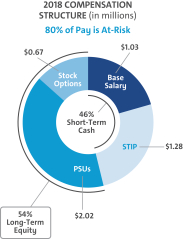
2018 COMPENSATION STRUCTURE (in millions) 80% of Pay is At-Risk $0.67 Stock Options $1.03 Base Salary 46% Short-Term Cash STIP $1.28 PSUs $2.02 54% Long-Term Equity
HISTORIC AWARDED VALUE (in millions) $ 6.1 $ 5.4 $ 5.1 2016 2017 2018 Awarded Value |
Awarded value reflects the amount included in the Summary Compensation Table, excluding change in pension value and all other compensation.
 | 53 |
EXECUTIVE COMPENSATION
| u | Compensation Decisions for Charles K. Stevens, III |
Charles K. Stevens, III, Advisor and Former Executive Vice President and
Chief Financial Officer
Mr. Stevens retired on March 1, 2019, following more than 40 years of service with the Company. He played a key role as a trusted advisor while assisting in the transition of the responsibilities of Chief Financial Officer to Ms. Suryadevara.
The Compensation Committee held Mr. Stevens’ base salary at $1,100,000 based on the competitive market analysis provided by the Compensation Committee’s independent compensation consultant. In February 2018, the Compensation Committee awarded Mr. Stevens an annual LTIP grant of $4.02 million, consisting of 75% PSUs and 25% Stock Options.
Mr. Stevens stepped down from his position as Executive Vice President and Chief Financial Officer effective September 1, 2018, and served as an Advisor through his retirement on March 1, 2019. The Compensation Committee awarded Mr. Stevens 25 points for the 2018 STIP performance year. The total compensation for Mr. Stevens in 2018, including salary, STIP, and LTIP awards, is displayed below.
Pay Element | Majority of Pay IsAt-Risk | Awarded Value | ||||
Base Salary | Only Fixed Pay Element | $1,100,000 | ||||
STIP | Performance to Metrics | $1,320,000 | ||||
PSUs(1) | Performance to Metrics and Stock Price | $3,255,775 | ||||
Stock Options(2) | Performance to Stock Price | $1,006,252 | ||||
TOTAL | $6,682,027 | |||||
| (1) | PSUs are subject to performance vesting; value reflects grant date fair value at target performance for Relative ROIC-adjusted awards and probable performance results from the Monte Carlo analysis to value Relative TSR awards. |
| (2) | Stock Options are subject to time-based vesting. |
|
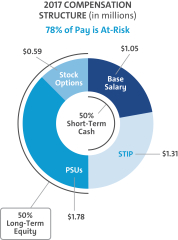
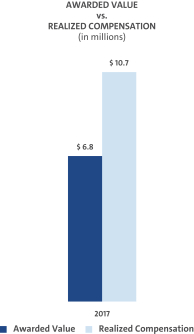
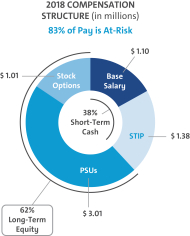
2018 COMPENSATION STRUCTURE (in millions) 83% of Pay is At-Risk $ 1.01 Stock Options $ 1.10 Base Salary 38% Short-Term Cash STIP $ 1.38 PSUs $ 3.01 62% Long-Term Equity
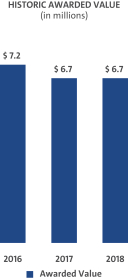
HISTORIC AWARDED VALUE (in millions) $ 7.2 $ 6.7 $ 6.7 2016 2017 2018 Awarded Value
Awarded value reflects the amount included in the Summary Compensation Table, excluding change in pension value and all other compensation Realized compensation includes base salary, earned STIP, TSI award, and all options exercised and stock vested during the year.compensation.
|
|
EXECUTIVE COMPENSATION
Compensation Policies and Governance Practices
| u | Stock Ownership Requirements |
The Company requires our senior leaders to own GM stock in the Company to more closely align the interests of senior leaders with those of our shareholders. The stock ownership requirements:
coverCover all senior leaders;
setSet five years as the time frame to meet ownership requirements;
establishRequire senior leaders to hold vested shares to maintain ownership requirements;
Establish a multiple of each executive’s base salary on the date they are first covered;
makeMake it possible to meet ownership requirements by owning either a multiple of base salary or a required number of shares; and
call for senior leaders to hold shares in order to meet the ongoing ownership requirements.Count only actual share holdings and unvested RSUs.
The table below shows the stock ownership requirement by level in the Company as well as ownership requirements for each of our NEOs.
|
| |||
| ||||
| ||||
| ||||
| ||||
| ||||
Company. As of December 31, 2017,2018, all NEOs have met or are on track to meet stock ownership requirements by their respective dates.

Stock Ownership Covers All Senior Executives and Above CEO President and Executive Vice President Senior Vice President Senior Executive 6X annual salary 4X annual salary 3X annual salary 1X annual salary TBD times annual salary The value of GM Common Stock held by GMs Chairman and CEO, Mary Barra, as of April 1, 2019
| u | Compensation Risk Assessment |
The Compensation Committee annually reviews the potential impact of our compensation programs on organizational risk. The Compensation Committee discusses the compensation programs and risk mitigation features when evaluating whether the programs encourage or reward employees for engaging in excessive, imprudent, inappropriate, or unnecessary risk.
The annual risk review, completed on October 8, 2018, with assistance from our human resources, audit, legal, and strategic risk management organizations, involved analyzing our current compensation programs in relation to risk. Our analysis concluded that our compensation programs include the following risk mitigation features:
Mix of Pay Elements– Base salary, STIP, PSUs, and Stock Options are included in the executive compensation program.
Short-Term and Long-Term Programs– The mix of our short-term and long-term compensation programs appropriately reward employees while balancing risk through the delayed payment of long-term awards.
Adjustments to Compensation– Maximum payout caps are in place for incentive compensation and the Compensation Committee has the ability to apply negative discretion.
Compensation Committee Oversight– Our Compensation Committee reviews plan performance and approves all executive compensation programs and payouts.
Multiple Performance Metrics– Multiple performance measures work together to balance risk in our incentive compensation programs.
Stock Ownership Requirements– All senior leaders are subject to stock ownership requirements of at least 1x their salary as described above.
Clawback Provisions – All awards are subject to the Recoupment of Incentive Compensation policy as described below.
In 2018, the Compensation Committee determined that our compensation programs have sufficient risk mitigation features and do not encourage or reward employees for engaging in excessive, imprudent, inappropriate, or unnecessary risk. Based on the Compensation Committee’s review, the Committee determined our compensation programs to be low risk.
 | 55 |
EXECUTIVE COMPENSATION
| u | Policy on Recoupment of Incentive Compensation |
We have a corporate policy to recover incentive compensation paid to executive officers in cases where financial statements are restated because of employee fraud, negligence, or intentional misconduct. Under this clawback policy, posted on our website atgm.com/investors/corporate-governanceresources, if the Board or an appropriate Board Committee determines any bonus, retention award, or short or long-term incentive compensation has been paid to any executive officer based on materially inaccurate misstatement of earnings, revenues, gains, or other criteria, including reputational harm, the Board or Compensation Committee will take the action it deems necessary to recover the compensation paid, remedy the misconduct, and prevent its recurrence. For this purpose, a financial statement or performance metric will be treated as materially inaccurate when an employee knowingly engaged in providing inaccurate information or knowingly failed to timely correct information relating to those financial statements or performance metrics. We will continue to review our policy to ensure it is consistent with all legal requirements and in the best interests of the Company and its shareholders.
| u |
|
Our securitiesinsider trading policy prohibits our employees from buying or selling GM securities when in possession of material nonpublic information. Any sale or purchase of common stock by directors, executive officers, and all other senior leaders must be made duringpre-established periods after receiving preclearance by a member of the GM Legal Staff or according to the preapproved Rule10b5-1 plan.
Trading in GM derivatives (i.e.(i.e., puts or calls), engaging in short sales, and pledging of GM securities is also prohibited. All GM executive officers are in compliance with the policy of not pledging any shares of common stock. This policy is posted on our website atgm.com/investors/corporate-governance.resources.
| u | Tax Considerations |
IRCIn tax years commencing prior to January 1, 2018, Internal Revenue Code (“IRC”) Section 162(m) generally disallowsdisallowed federal tax deductions for compensation in excess of $1 million paid to the CEO and the next three of our highest-paid officers (other than the CFO) whose compensation is required to be reported in(collectively the Summary Compensation Table in this Proxy Statement (‘‘Covered Executives’’“Covered Executives”). Certain performance-based compensation is not subject to this deduction limitation as applicable for fiscal year 2017. Generally, we strive to maximize the tax deductibility of compensation arrangements. The Compensation Committee, however, may award compensation that is not fully tax deductible if it deems it appropriate as compensation designed to attract and retain talented executives in the highly competitive market for talent.
STIP awards for performance during 2017 are paid based on the achievement of performance measures approved by shareholders in 2014 as part of the 2014 STIP. Because the STIP awards for performance during 2017 are intended to be deductible as performance-based compensation under 162(m), the Compensation Committee set the maximum award for each Covered Executive at $7.5 million. Incentive amounts equal to the maximum will be funded for each Covered Executive once a threshold level of positive EBIT-adjusted has been achieved. The Compensation Committee then exercises negative discretion, as needed, to determine actual incentive awards based on other business and individual performance, as described in “Executive Compensation—Performance Results and Compensation Decisions—2017 Short-Term Incentive Plan” on page 47.
|
EXECUTIVE COMPENSATION
The Tax Cuts and Jobs Act, enacted on December 22, 2017, substantially modifiesmodified IRC Section 162(m) and, among other things, eliminateseliminated the performance-based compensation exception to the $1 million deduction limit effective as of January 1, 2018. As a result, beginning in 2018, compensation paid to Covered Executives in excess of $1 million will generally be nondeductible, whether or not it is performance-based. In addition, beginning in 2018, the Covered Executives will include any individual who served as the CEO or CFO at any time during the taxable year and the next three of our highest paid officers (other than the CEO and CFO) for the taxable year, and once an individual becomes a Covered Executive for any taxable year beginning after December 31, 2016, that individual will remain a Covered Executive for all future years, including following any termination of employment.
The Tax Cuts and Jobs Act includes a transition relief rule pursuant to which the changes to IRC Section 162(m) described above will not apply to compensation payable pursuant to a written binding contract that was in effect on November 2, 2017, and is not materially modified after that date. To the extent it is applicable to our existing arrangements, the Compensation Committee may avail itself of this transition relief rule. However, because of uncertainties as to the application and interpretation of the transition relief rule, no assurances can be given at this time that our existing arrangements, even if in place on November 2, 2017, will meet the requirements of the transition relief rule. Moreover, to maintain flexibility in attracting and retaining talented executives, the Compensation Committee does not limit its actions with respect to executive compensation to preserve deductibility under IRC Section 162(m) if the Compensation Committee determines that doing so is in the best interests of our shareholders.
| 56 |
|
EXECUTIVE COMPENSATION
| u | Compensation Committee and Consultant Independence |
Our Compensation Committee is composed entirely of independent directors as determined by the Board under NYSE standards and as defined for various regulatory purposes. Farient Advisors assisted the Compensation Committee in 2017.2018. Farient Advisors is an independent compensation consulting firm that takes direction from and is solely responsible to the Compensation Committee. The Compensation Committee is also aided in its deliberations byin-house legal counsel.
Under its charter, the Compensation Committee has the authority to hire outside consultants and advisors at the Company’s expense. The Compensation Committee retains the services of Farient Advisors for advice on issues related to the compensation of NEOs and other executivecompensation-related matters. A representative of Farient Advisors attended all Compensation Committee meetings, either in person or via telephone, consulted with and advised the Compensation Committee members on executive compensation, including the structure and amounts of various pay elements, and developed executive benchmarking data for the Compensation Committee. Farient Advisors provided no services to the Company’s management.
The Compensation Committee annually reviews the performance of the compensation consultant and considers the following factors when assessing consultant independence in accordance with NYSE standards:
Services provided to GM management outside of the services provided to the Compensation Committee;
Fees paid as a percentage of Farient Advisors’ total revenue;
Policies and procedures of Farient Advisors designed to prevent conflicts of interest;
Any business or personal relationships between members of the Compensation Committee and Farient Advisors;
Stock ownership by employees of Farient Advisors; and
Any business or personal relationships between GM and Farient Advisors.
The Compensation Committee reviewed the performance and independence of Farient Advisors and determined that Farient Advisors was independent based on the standards above.
|
During 2017, the Compensation Committee reviewed and discussed the impact of executive compensation programs on organizational risk. The Compensation Committee discussed plans and reviewed risk mitigation features in each of the plans to evaluate, with the assistance of our audit, legal and risk management organizations, the overall impact that compensation programs have on organizational risk. The Compensation Committee determined compensation programs have sufficient risk mitigation features and do not encourage or reward employees for taking excessive or unnecessary risk. The mix of our short-term and long-term compensation programs appropriately rewards employees while balancing risk through the delayed payment of long-term awards. As a result of the compensation risk review completed on December 12, 2017, the Compensation Committee determined the overall risk of compensation programs exposing the organization to unnecessary or excessive risks is low.
| u | Employment and Termination Agreements |
The Company has no employment or termination agreements with any of our 20172018 NEOs. All NEOs participate in the sameGeneral Motors LLC U.S. Executive Severance Program availablefiled as an exhibit to other executive employees.
|
the 2018 FormEXECUTIVE COMPENSATION10-K.
The Compensation Committee has reviewed and discussed with management the CD&A and, based on that review and discussion, has recommended to the Board of Directors that the CD&A be included in this Proxy Statement and incorporated by reference ininto the GM 20172018 Annual Report on Form10-K.
Compensation Committee
Carol M. Stephenson (Chair)
Joseph Jimenez
James J. Mulva
Patricia F. Russo
Compensation Committee*
Carol M. Stephenson (Chair) Joseph Jimenez James J. Mulva Patricia F. Russo |
| * | Wesley G. Bush was not a member of the Compensation Committee at the time the Committee approved its Report. |
 | 57 |
EXECUTIVE COMPENSATION
| u |
Name and Principal Position(1)
| Year
| Salary(2) ($)
| Bonus(3) ($)
| Stock Awards(4) ($)
| Option Awards(5) ($)
| Nonequity Incentive Plan Compensation(6) ($)
|
Change in Pension Value and NQ Deferred Compensation Earnings(7) ($)
| All Other Compensation(8) ($)
| Total ($)
| |||||||||||||||||||||||||||
Mary T. Barra Chairman and Chief Executive Officer |
|
2017
|
|
| 2,100,000
|
|
| —
|
|
| 10,737,570
|
|
| 3,250,003
|
|
| 4,956,000
|
|
| 52,792
|
|
| 861,683
|
|
| 21,958,048
|
| |||||||||
|
2016
|
|
| 2,000,000
|
|
| —
|
|
| 13,000,036
|
|
| —
|
|
| 6,760,000
|
|
| 181,777
|
|
| 640,246
|
|
| 22,582,059
|
| ||||||||||
|
2015
|
|
| 1,750,000
|
|
| —
|
|
| 12,000,004
|
|
| 11,167,029
|
|
| 3,062,500 �� |
|
| 12,012
|
|
| 597,118
|
|
| 28,588,663
|
| ||||||||||
Charles K. Stevens, III Executive Vice President and Chief Financial Officer |
|
2017
|
|
| 1,100,000
|
|
| —
|
|
| 3,076,744
|
|
| 931,251
|
|
| 1,622,500
|
|
| 54,114
|
|
| 316,430
|
|
| 7,101,039
|
| |||||||||
|
2016
|
|
| 1,100,000
|
|
| —
|
|
| 3,450,007
|
|
| —
|
|
| 2,673,800
|
|
| 135,146
|
|
| 244,132
|
|
| 7,603,085
|
| ||||||||||
|
2015
|
|
| 1,000,000
|
|
| —
|
|
| 2,875,049
|
|
| 2,675,437
|
|
| 1,375,000
|
|
| —
|
|
| 176,738
|
|
| 8,102,224
|
| ||||||||||
Daniel Ammann President |
|
2017
|
|
| 1,450,000
|
|
| —
|
|
| 4,078,222
|
|
| 1,234,378
|
|
| 2,138,800
|
|
| —
|
|
| 356,918
|
|
| 9,258,318
|
| |||||||||
|
2016
|
|
| 1,450,000
|
|
| —
|
|
| 4,700,032
|
|
| —
|
|
| 3,513,100
|
|
| —
|
|
| 560,852
|
|
| 10,223,984
|
| ||||||||||
|
2015
|
|
| 1,200,000
|
|
| —
|
|
| 4,500,021
|
|
| 4,187,636
|
|
|
1,650,000
|
|
| —
|
|
| 262,420
|
|
| 11,800,077
|
| ||||||||||
Mark L. Reuss Executive Vice President, Global Product Development, Purchasing and Supply Chain |
|
2017
|
|
| 1,200,000
|
|
| —
|
|
| 3,345,168
|
|
| 1,012,504
|
|
| 1,770,000
|
|
| 54,390
|
|
| 344,446
|
|
| 7,726,508
|
| |||||||||
|
2016
|
|
| 1,200,000
|
|
| —
|
|
| 3,900,018
|
|
| —
|
|
| 2,905,000
|
|
| 134,777
|
|
| 272,866
|
|
| 8,412,661
|
| ||||||||||
|
2015
|
|
| 1,100,000
|
|
| —
|
|
| 3,825,012
|
|
| 3,559,495
|
|
| 1,515,000
|
|
| —
|
|
| 199,629
|
|
| 10,199,136
|
| ||||||||||
Alan S. Batey Executive Vice President, & President, North America |
|
2017
|
|
| 1,025,000
|
|
| —
|
|
| 2,224,928
|
|
| 673,426
|
|
| 1,447,800
|
|
| 316,601
|
|
| 287,373
|
|
| 5,975,128
|
| |||||||||
|
2016
|
|
| 950,000
|
|
| —
|
|
| 2,700,035
|
|
| —
|
|
| 2,406,900
|
|
| 133,151
|
|
| 225,078
|
|
| 6,415,164
|
| ||||||||||
Karl-Thomas Neumann Former Executive Vice President & President, Europe
|
|
2017
|
|
| 916,936
|
|
| 2,000,000
|
|
| 1,961,676
|
|
| 593,751
|
|
| 1,276,317
|
|
| 126,796
|
|
| 12,563
|
|
| 6,888,039
|
| |||||||||
Name and Principal Position(1)
| Year
| Salary ($)
| Bonus ($)
| Stock Awards(2) ($)
| Option Awards(3) ($)
| Nonequity Incentive Plan Compensation(4) ($)
|
Change in Pension Value and NQ Deferred Compensation Earnings(5) ($)
| All Other Compensation(6) ($)
| Total ($)
| |||||||||||||||||||||||||||
Mary T. Barra Chairman and Chief Executive Officer |
|
2018
|
|
| 2,100,000
|
|
| —
|
|
| 11,081,760
|
|
| 3,425,006
|
|
| 4,452,000
|
|
| —
|
|
| 811,684
|
|
| 21,870,450
|
| |||||||||
|
2017
|
|
| 2,100,000
|
|
| —
|
|
| 10,737,570
|
|
| 3,250,003
|
|
| 4,956,000
|
|
| 52,792
|
|
| 861,683
|
|
| 21,958,048
|
| ||||||||||
|
2016
|
|
| 2,000,000
|
|
| —
|
|
| 13,000,036
|
|
| —
|
|
| 6,760,000
|
|
| 181,777
|
|
| 640,246
|
|
| 22,582,059
|
| ||||||||||
Dhivya Suryadevara Executive Vice President and Chief Financial Officer
| 2018 | 668,100 | — | 2,446,635 | 796,263 | 1,192,500 | — | 402,592 | 5,506,090 | |||||||||||||||||||||||||||
Daniel Ammann President |
|
2018
|
|
| 1,450,000
|
|
| —
|
|
| 3,993,891
|
|
| 1,234,383
|
|
| 1,921,300
|
|
| —
|
|
| 372,307
|
|
| 8,971,881
|
| |||||||||
|
2017
|
|
| 1,450,000
|
|
| —
|
|
| 4,078,222
|
|
| 1,234,378
|
|
| 2,138,800
|
|
| —
|
|
| 356,918
|
|
| 9,258,318
|
| ||||||||||
|
2016
|
|
| 1,450,000
|
|
| —
|
|
| 4,700,032
|
|
| —
|
|
|
3,513,100
|
|
| —
|
|
| 560,852
|
|
| 10,223,984
|
| ||||||||||
Mark L. Reuss Executive Vice President and President, Global Product Group and Cadillac |
|
2018
|
|
| 1,200,000
|
|
| —
|
|
| 3,276,007
|
|
| 1,012,504
|
|
| 1,590,000
|
|
| —
|
|
| 277,579
|
|
| 7,356,090
|
| |||||||||
|
2017
|
|
| 1,200,000
|
|
| —
|
|
| 3,345,168
|
|
| 1,012,504
|
|
| 1,770,000
|
|
| 54,390
|
|
| 344,446
|
|
| 7,726,508
|
| ||||||||||
|
2016
|
|
| 1,200,000
|
|
| —
|
|
| 3,900,018
|
|
| —
|
|
| 2,905,000
|
|
| 134,777
|
|
| 272,866
|
|
| 8,412,661
|
| ||||||||||
Alan S. Batey Executive Vice President and President, North America |
|
2018
|
|
| 1,025,000
|
|
| —
|
|
| 2,178,894
|
|
| 673,429
|
|
| 1,230,000
|
|
| —
|
|
| 233,197
|
|
| 5,340,520
|
| |||||||||
|
2017
|
|
| 1,025,000
|
|
| —
|
|
| 2,224,928
|
|
| 673,426
|
|
| 1,447,800
|
|
| 316,601
|
|
| 287,373
|
|
| 5,975,128
|
| ||||||||||
|
2016
|
|
| 950,000
|
|
| —
|
|
| 2,700,035
|
|
| —
|
|
| 2,406,900
|
|
| 133,151
|
|
| 225,078
|
|
| 6,415,164
|
| ||||||||||
Charles K. Stevens, III Advisor and Former Executive Vice President and Chief Financial Officer |
|
2018
|
|
| 1,100,000
|
|
| —
|
|
| 3,255,775
|
|
| 1,006,252
|
|
| 1,320,000
|
|
| —
|
|
| 257,153
|
|
| 6,939,180
|
| |||||||||
|
2017
|
|
| 1,100,000
|
|
| —
|
|
| 3,076,744
|
|
| 931,251
|
|
| 1,622,500
|
|
| 54,114
|
|
| 316,430
|
|
| 7,101,039
|
| ||||||||||
|
2016
|
|
| 1,100,000
|
|
| —
|
|
| 3,450,007
|
|
| —
|
|
| 2,673,800
|
|
| 135,146
|
|
| 244,132
|
|
| 7,603,085
|
| ||||||||||
| (1) | Titles |
| (2) |
|
|
Stock Awards displays the grant date fair value of PSUs issued under the LTIP, computed in accordance with Financial Accounting Standards Board (“FASB”) Accounting Standards Codification (“ASC”) Topic 718. PSUs will vest based on GM’s performance |
| Value of PSU Awards at Target and Maximum Performance
| ||||||||||
2017 Target ($) | 2017 Maximum | |||||||||
Mary T. Barra
|
| 9,750,028
|
|
| 19,500,056
|
|
| |||
Charles K. Stevens, III
|
| 2,793,782
|
|
| 5,587,564
|
|
| |||
Daniel Ammann
|
| 3,703,146
|
|
| 7,406,291
|
|
| |||
Mark L. Reuss
|
| 3,037,518
|
|
| 6,075,036
|
|
| |||
Alan S. Batey
|
| 2,020,307
|
|
| 4,040,614
|
|
| |||
Karl-Thomas Neumann
|
| 1,781,264
|
|
| 3,562,527
|
|
| |||
| Grant Date | Stock Price | Implied Volatility | Risk-Free Interest
| Valuation Price | Valuation Price as a Percent of Target | |||||
2/13/2018 | $41.40 | 28% | 2.30% | $51.25 | 123.8% | |||||
10/1/2018 | $34.20 | 28% | 2.88% | $35.02 | 102.4% | |||||
There is no dividend yield as dividends are assumed to be reinvested for the TSR calculation. The table below shows the PSUs valued based on the closing stock price on the date of grant and the maximum grant value based on maximum performance.
| Value of PSU Awards at Target and Maximum Performance
| ||||||||
| 2018 Target ($) | 2018 Maximum ($) | |||||||
Mary T. Barra
|
| 10,275,025
|
|
| 20,550,050
|
| ||
Dhivya Suryadevara
|
| 2,388,814
|
|
| 4,777,628
|
| ||
Daniel Ammann
|
| 3,703,147
|
|
| 7,406,294
|
| ||
Mark L. Reuss
|
| 3,037,518
|
|
| 6,075,036
|
| ||
Alan S. Batey
|
| 2,020,279
|
|
| 4,040,558
|
| ||
Charles K. Stevens, III
|
| 3,018,764
|
|
| 6,037,528
|
| ||
| 58 |
|
EXECUTIVE COMPENSATION
Option Awards displays the grant date fair value of Stock Options issued under the LTIP, computed in accordance with FASB ASC Topic 718 using a Black-Scholes valuation. |
| Grant Date | Dividend Yield | Implied Volatility | Risk-Free Interest Rate | Expected Option Life | Grant Date Fair Value | |||||
2/13/2018 | 3.67% | 28% | 2.72% | 6.00 years | $8.28 | |||||
10/1/2018 | 4.44% | 28% | 3.00% | 5.36 years | $6.15 | |||||
|
These amounts represent the actuarial change in the present value of the |
|
All Other Compensation
M.T. Barra ($) | C.K. Stevens ($) | D. Ammann ($) | M.L. Reuss ($) | A.S.��Batey ($) | K.T. Neumann ($) | M.T. Barra ($) | D. Suryadevara ($) | D. Ammann ($) | M.L. Reuss ($) | A.S. Batey ($) | C.K. Stevens ($) | |||||||||||||||||||||||||||||||||||||||||
Perquisites and Other Personal Benefits(1)
|
| 233,323
|
|
| 39,257
|
|
| 95,948
|
|
| 44,350
|
|
| 35,570
|
|
| 12,563
|
|
| 290,589
|
|
| 321,066
|
|
| 166,065
|
|
| 43,668
|
|
| 37,236
|
|
| 42,734
|
| ||||||||||||||||
Employer Contributions to Savings Plans(2)
|
| 615,600
|
|
| 270,428
|
|
| 256,524
|
|
| 294,300
|
|
| 246,913
|
|
| —
|
|
| 507,360
|
|
| 80,632
|
|
| 201,552
|
|
| 226,200
|
|
| 189,374
|
|
| 207,350
|
| ||||||||||||||||
Life and Other Insurance Benefits(3)
|
| 12,760
|
|
| 6,745
|
|
| 4,446
|
|
| 5,796
|
|
| 4,890
|
|
| —
|
|
| 13,735
|
|
| 894
|
|
| 4,690
|
|
| 7,711
|
|
| 6,587
|
|
| 7,069
|
| ||||||||||||||||
TOTAL
|
| 861,683
|
|
| 316,430
|
|
| 356,918
|
|
| 344,446
|
|
| 287,373
|
|
| 12,563
|
|
| 811,684
|
|
| 402,592
|
|
| 372,307
|
|
| 277,579
|
|
| 233,197
|
|
| 257,153
|
| ||||||||||||||||
| (1) |
|
| (2) | Includes employer contributions totax-qualified andnon-tax-qualified savings and retirement plans during |
| (3) | Includes premiums paid by the Company for Group Variable Universal Life insurance for executives. Executives are responsible for any ordinary income taxes resulting from the cost of theGM-paid premiums. For Ms. Barra, amounts also include the Company’s cost of premiums for providing personal accident insurance for members of the Board. |
Perquisites and Other Personal Benefits
M.T. Barra ($)
| C.K. Stevens ($)
| D. Ammann ($)
| M.L. Reuss ($)
| A.S. Batey ($)
| K.T. Neumann ($)
| M.T. Barra ($)
| D. Suryadevara ($)
| D. Ammann ($)
| M.L. Reuss ($)
| A.S. Batey ($)
| C.K. Stevens ($)
| |||||||||||||||||||||||||||||||||||||||||
Personal Travel(1)
|
| 168,085
|
|
| —
|
|
| 14,690
|
|
| —
|
|
| —
|
|
| —
|
|
| 140,599
|
|
| —
|
|
| 67,277
|
|
| —
|
|
| —
|
|
| —
|
| ||||||||||||||||
Security(2)
|
| 12,597
|
|
| —
|
|
| 37,511
|
|
| —
|
|
| —
|
|
| —
|
|
| 89,884
|
|
| —
|
|
| 55,434
|
|
| —
|
|
| —
|
|
| —
|
| ||||||||||||||||
Company Vehicle Programs(3)
|
| 37,031
|
|
| 23,647
|
|
| 33,387
|
|
| 28,990
|
|
| 25,210
|
|
| 12,563
|
|
| 44,696
|
|
| 23,387
|
|
| 32,994
|
|
| 33,308
|
|
| 26,876
|
|
| 27,324
|
| ||||||||||||||||
Executive Physical(4)
|
| 5,250
|
|
| 5,250
|
|
| —
|
|
| 5,000
|
|
| —
|
|
| —
|
|
| 5,050
|
|
| —
|
|
| —
|
|
| —
|
|
| —
|
|
| 5,050
|
| ||||||||||||||||
Financial Counseling(5)
|
| 10,360
|
|
| 10,360
|
|
| 10,360
|
|
| 10,360
|
|
| 10,360
|
|
| —
|
|
| 10,360
|
|
| 8,906
|
|
| 10,360
|
|
| 10,360
|
|
| 10,360
|
|
| 10,360
|
| ||||||||||||||||
Other(6)
|
| —
|
|
| —
|
|
| —
|
|
| —
|
|
| —
|
|
| —
|
| ||||||||||||||||||||||||||||||||||
Other(6)(7)
|
| —
|
|
| 288,773
|
|
| —
|
|
| —
|
|
| —
|
|
| —
|
| ||||||||||||||||||||||||||||||||||
TOTAL
|
| 233,323
|
|
| 39,257
|
|
| 95,948
|
|
| 44,350
|
|
| 35,570
|
|
| 12,563
|
|
| 290,589
|
|
| 321,066
|
|
| 166,065
|
|
| 43,668
|
|
| 37,236
|
|
| 42,734
|
| ||||||||||||||||
| (1) | Personal travel pursuant to Company policy as discussed on page |
| (2) | Amounts include the |
| (3) |
|
| (4) | Costs associated with executive physicals |
| (5) | Costs associated with financial counseling and estate planning services with our approved |
 | 59 |
EXECUTIVE COMPENSATION
| (6) | The total amount disclosed for Ms. Suryadevara relates to her position location change to Detroit, Michigan, including $128,629 of relocation tax benefits. Relocation assistance and associated relocation tax benefits are consistent with our standard relocation program and available to all employees. |
Occasionally unused tickets from sponsorship agreements are made available for personal use. Tickets are included in sponsorship agreements and typically result in no incremental costs to the Company. |
|
EXECUTIVE COMPENSATION
| u |
STIP awards for the 20172018 performance year were made under the terms of the 2014 STIP,2017 STIP. PSU equityand Stock Option grants were made to each NEO under the terms of the 2014 LTIP, and Stock Options were granted under the terms of the 2017 LTIP. PSUs which vest and deliver at the end of the performance period and will be earned
at a level between 0% and 200% of target. PSUs are based on the achievement of performance conditions relating to Relative ROIC-adjusted and Relative TSR over a three-year performance period from January 1, 20172018, to December 31, 2019.2020. The Stock Options will vest ratably over thea three-year period.
Estimated Future Payouts UnderNon-Equity Incentive Plan Awards | Estimated Future Payouts Under Equity Incentive Plan Awards | All Other Stock Awards: Number of Shares of Stock or Units (#) | All Other Option Awards: Number of Securities Underlying Options (#) | Exercise or Base Price of Option Awards ($/share) | Grant Date Fair Value of Stock and Option Awards($)(1) |
Estimated Future Payouts UnderNon-Equity Incentive Plan Awards | Estimated Future Payouts Under Equity Incentive Plan Awards | All Other Stock Awards: Number of Shares of | All Other Option Awards: Number of Securities | Exercise or Base Price of Option | Grant Date Fair Value of Stock | |||||||||||||||||||||||||||||||||||||||||||||||||||||||||||||||||||||||||||||||||||||||||||||
| Name | Award Type | Grant Date | Approval Date | Threshold ($) | Target ($) | Maximum ($) | Threshold (#) | Target (#) | Maximum (#) | Award Type | Grant Date | Approval Date | Threshold ($) | Target ($) | Maximum ($) | Threshold (#) | Target (#) | Maximum (#) | ||||||||||||||||||||||||||||||||||||||||||||||||||||||||||||||||||||||||||||||||||||||
Mary T. Barra | STIP | 1/1/2017 | 2/1/2017 | 525,000 | 4,200,000 | 8,400,000 | ||||||||||||||||||||||||||||||||||||||||||||||||||||||||||||||||||||||||||||||||||||||||||||||||||
Mary T. Barra | Options | 6/7/2017 | 2/1/2017 | 652,611 | 34.34 | 3,250,003 |
| STIP |
|
| 1/1/2018 |
|
| 12/12/2017 |
|
| 409,500 |
|
| 4,200,000 |
|
| 8,400,000 |
| ||||||||||||||||||||||||||||||||||||||||||||||||||||||||||||||||||||||||||||||||
| PSU | 2/14/2017 | 2/1/2017 | 43,200 | 261,816 | 523,632 | 10,737,570 | ||||||||||||||||||||||||||||||||||||||||||||||||||||||||||||||||||||||||||||||||||||||||||||||||||
Charles K. Stevens, III | STIP | 1/1/2017 | 2/1/2017 | 171,875 | 1,375,000 | 2,750,000 | ||||||||||||||||||||||||||||||||||||||||||||||||||||||||||||||||||||||||||||||||||||||||||||||||||
| Options |
|
| 2/13/2018 |
|
| 12/12/2017 |
|
| 413,648 |
|
| 41.40 |
|
| 3,425,006 |
| |||||||||||||||||||||||||||||||||||||||||||||||||||||||||||||||||||||||||||||||||||||||
| PSU |
|
| 2/13/2018 |
|
| 12/12/2017 |
|
| 40,951 |
|
| 248,189 |
|
| 496,378 |
|
| 11,081,760 |
| ||||||||||||||||||||||||||||||||||||||||||||||||||||||||||||||||||||||||||||||||||||
Dhivya Suryadevara |
| STIP |
|
| 1/1/2018 |
|
| 12/12/2017 |
|
| 109,688 |
|
| 1,125,000 |
|
| 2,250,000 |
| ||||||||||||||||||||||||||||||||||||||||||||||||||||||||||||||||||||||||||||||||||||||
| Options |
|
| 2/13/2018 |
|
| 12/12/2017 |
|
| 22,193 |
|
| 41.40 |
|
| 183,759 |
| |||||||||||||||||||||||||||||||||||||||||||||||||||||||||||||||||||||||||||||||||||||||
| Options |
|
| 10/1/2018 |
|
| 6/11/2018 |
|
| 99,594 |
|
| 34.20 |
|
| 612,504 |
| |||||||||||||||||||||||||||||||||||||||||||||||||||||||||||||||||||||||||||||||||||||||
| PSU |
|
| 2/13/2018 |
|
| 12/12/2017 |
|
| 2,197 |
|
| 13,316 |
|
| 26,632 |
|
| 594,564 |
| ||||||||||||||||||||||||||||||||||||||||||||||||||||||||||||||||||||||||||||||||||||
| PSU |
|
| 10/1/2018 |
|
| 6/11/2018 |
|
| 8,865 |
|
| 53,729 |
|
| 107,458 |
|
| 1,852,071 |
| ||||||||||||||||||||||||||||||||||||||||||||||||||||||||||||||||||||||||||||||||||||
Daniel Ammann |
| STIP |
|
| 1/1/2018 |
|
| 12/12/2017 |
|
| 176,719 |
|
| 1,812,500 |
|
| 3,625,000 |
| ||||||||||||||||||||||||||||||||||||||||||||||||||||||||||||||||||||||||||||||||||||||
| Options |
|
| 2/13/2018 |
|
| 12/12/2017 |
|
| 149,080 |
|
| 41.40 |
|
| 1,234,383 |
| |||||||||||||||||||||||||||||||||||||||||||||||||||||||||||||||||||||||||||||||||||||||
| PSU |
|
| 2/13/2018 |
|
| 12/12/2017 |
|
| 14,759 |
|
| 89,448 |
|
| 178,896 |
|
| 3,993,891 |
| ||||||||||||||||||||||||||||||||||||||||||||||||||||||||||||||||||||||||||||||||||||
Mark L. Reuss |
| STIP |
|
| 1/1/2018 |
|
| 12/12/2017 |
|
| 146,250 |
|
| 1,500,000 |
|
| 3,000,000 |
| ||||||||||||||||||||||||||||||||||||||||||||||||||||||||||||||||||||||||||||||||||||||
| Options |
|
| 2/13/2018 |
|
| 12/12/2017 |
|
| 122,283 |
|
| 41.40 |
|
| 1,012,504 |
| |||||||||||||||||||||||||||||||||||||||||||||||||||||||||||||||||||||||||||||||||||||||
| PSU |
|
| 2/13/2018 |
|
| 12/12/2017 |
|
| 12,106 |
|
| 73,370 |
|
| 146,740 |
|
| 3,276,007 |
| ||||||||||||||||||||||||||||||||||||||||||||||||||||||||||||||||||||||||||||||||||||
Alan S. Batey |
| STIP |
|
| 1/1/2018 |
|
| 12/12/2017 |
|
| 124,927 |
|
| 1,281,300 |
|
| 2,562,600 |
| ||||||||||||||||||||||||||||||||||||||||||||||||||||||||||||||||||||||||||||||||||||||
| Options |
|
| 2/13/2018 |
|
| 12/12/2017 |
|
| 81,332 |
|
| 41.40 |
|
| 673,429 |
| |||||||||||||||||||||||||||||||||||||||||||||||||||||||||||||||||||||||||||||||||||||||
| PSU |
|
| 2/13/2018 |
|
| 12/12/2017 |
|
| 8,052 |
|
| 48,799 |
|
| 97,598 |
|
| 2,178,894 |
| ||||||||||||||||||||||||||||||||||||||||||||||||||||||||||||||||||||||||||||||||||||
Charles K. Stevens, III | Options | 6/7/2017 | 2/1/2017 | 186,998 | 34.34 | 931,251 |
| STIP |
|
| 1/1/2018 |
|
| 12/12/2017 |
|
| 134,063 |
|
| 1,375,000 |
|
| 2,750,000 |
| ||||||||||||||||||||||||||||||||||||||||||||||||||||||||||||||||||||||||||||||||
| PSU | 2/14/2017 | 2/1/2017 | 12,378 | 75,021 | 150,042 | 3,076,744 | ||||||||||||||||||||||||||||||||||||||||||||||||||||||||||||||||||||||||||||||||||||||||||||||||||
Daniel Ammann | STIP | 1/1/2017 | 2/1/2017 | 226,563 | 1,812,500 | 3,625,000 | ||||||||||||||||||||||||||||||||||||||||||||||||||||||||||||||||||||||||||||||||||||||||||||||||||
| Options | 6/7/2017 | 2/1/2017 | 247,867 | 34.34 | 1,234,378 | |||||||||||||||||||||||||||||||||||||||||||||||||||||||||||||||||||||||||||||||||||||||||||||||||||
| PSU | 2/14/2017 | 2/1/2017 | 16,408 | 99,440 | 198,880 | 4,078,222 |
| Options |
|
| 2/13/2018 |
|
| 12/12/2017 |
|
| 121,528 |
|
| 41.40 |
|
| 1,006,252 |
| ||||||||||||||||||||||||||||||||||||||||||||||||||||||||||||||||||||||||||||||||
Mark L. Reuss | STIP | 1/1/2017 | 2/1/2017 | 187,500 | 1,500,000 | 3,000,000 | ||||||||||||||||||||||||||||||||||||||||||||||||||||||||||||||||||||||||||||||||||||||||||||||||||
| Options | 6/7/2017 | 2/1/2017 | 203,314 | 34.34 | 1,012,504 | |||||||||||||||||||||||||||||||||||||||||||||||||||||||||||||||||||||||||||||||||||||||||||||||||||
| PSU | 2/14/2017 | 2/1/2017 | 13,458 | 81,566 | 163,132 | 3,345,168 |
| PSU |
|
| 2/13/2018 |
|
| 12/12/2017 |
|
| 12,031 |
|
| 72,917 |
|
| 145,834 |
|
| 3,255,775 |
| |||||||||||||||||||||||||||||||||||||||||||||||||||||||||||||||||||||||||||||
Alan S. Batey | STIP | 1/1/2017 | 2/1/2017 | 160,163 | 1,281,300 | 2,562,600 | ||||||||||||||||||||||||||||||||||||||||||||||||||||||||||||||||||||||||||||||||||||||||||||||||||
| Options | 6/7/2017 | 2/1/2017 | 135,226 | 34.34 | 673,426 | |||||||||||||||||||||||||||||||||||||||||||||||||||||||||||||||||||||||||||||||||||||||||||||||||||
| PSU | 2/14/2017 | 2/1/2017 | 8,951 | 54,251 | 108,502 | 2,224,928 | ||||||||||||||||||||||||||||||||||||||||||||||||||||||||||||||||||||||||||||||||||||||||||||||||||
Karl-Thomas Neumann | STIP | 1/1/2017 | 2/1/2017 | 164,063 | 1,312,500 | 2,625,000 | ||||||||||||||||||||||||||||||||||||||||||||||||||||||||||||||||||||||||||||||||||||||||||||||||||
| Options | 6/7/2017 | 2/1/2017 | 119,227 | 34.34 | 593,751 | |||||||||||||||||||||||||||||||||||||||||||||||||||||||||||||||||||||||||||||||||||||||||||||||||||
| PSU | 2/14/2017 | 2/1/2017 | 7,892 | 47,832 | 95,664 | 1,961,676 | ||||||||||||||||||||||||||||||||||||||||||||||||||||||||||||||||||||||||||||||||||||||||||||||||||
| (1) | This column shows the aggregate grant date fair value of PSUs and Stock Options granted to the NEOs in |
|
|
EXECUTIVE COMPENSATION
| u |
|
|
|
|
|
|
|
|
|
| |||||||||||||||||||||||||||||||
|
| |||||||||||||||||||||||||||||||||||||||
| ||||||||||||||||||||||||||||||||||||||||
| ||||||||||||||||||||||||||||||||||||||||
| ||||||||||||||||||||||||||||||||||||||||
| ||||||||||||||||||||||||||||||||||||||||
|
| |||||||||||||||||||||||||||||||||||||||
| ||||||||||||||||||||||||||||||||||||||||
| ||||||||||||||||||||||||||||||||||||||||
| ||||||||||||||||||||||||||||||||||||||||
| ||||||||||||||||||||||||||||||||||||||||
|
| |||||||||||||||||||||||||||||||||||||||
| ||||||||||||||||||||||||||||||||||||||||
| ||||||||||||||||||||||||||||||||||||||||
| ||||||||||||||||||||||||||||||||||||||||
| ||||||||||||||||||||||||||||||||||||||||
|
| |||||||||||||||||||||||||||||||||||||||
| ||||||||||||||||||||||||||||||||||||||||
| ||||||||||||||||||||||||||||||||||||||||
| ||||||||||||||||||||||||||||||||||||||||
| ||||||||||||||||||||||||||||||||||||||||
|
| |||||||||||||||||||||||||||||||||||||||
| ||||||||||||||||||||||||||||||||||||||||
| ||||||||||||||||||||||||||||||||||||||||
| ||||||||||||||||||||||||||||||||||||||||
| ||||||||||||||||||||||||||||||||||||||||
|
| |||||||||||||||||||||||||||||||||||||||
| ||||||||||||||||||||||||||||||||||||||||
| ||||||||||||||||||||||||||||||||||||||||
| ||||||||||||||||||||||||||||||||||||||||
| ||||||||||||||||||||||||||||||||||||||||
| Option Awards | Stock Awards(1) | |||||||||||||||||||||||||||||||||||||||
| Name | Grant Date | Number of Securities Underlying Unexercised Options Exercisable (#) | Number of Securities Underlying Unexercised Options Unexercisable (#) | Equity Incentive Plan Awards: Number of Securities Underlying Unexercised Unearned Options (#) | Option Exercise Price ($) | Option Expiration Date | Number of Shares or Units of Stock That Have Not Vested (#) | Market Value of Shares or Units of Stock That Have Not Vested ($) | Equity Incentive Plan Awards: Number of Unearned Shares, Units, or Other Rights That Have Not Vested (#) | Equity Incentive Plan Awards: Market or Payout Value of Unearned Shares, Units, or Other Rights That Have Not Vested ($) | ||||||||||||||||||||||||||||||
Mary T. Barra |
| 2/13/2018 |
|
| — |
|
| 413,648 | (2) |
| 41.40 |
|
| 2/11/2028 |
|
| 248,189 | (7)(8) |
| 8,301,922 | (8) | |||||||||||||||||||
| 6/7/2017 |
|
| 217,537 |
|
| 435,074 | (3) |
| 34.34 |
|
| 6/7/2027 |
| ||||||||||||||||||||||||||
| 2/14/2017 |
|
| 261,816 | (7)(8) |
| 8,757,745 | (8) | ||||||||||||||||||||||||||||||||
| 2/10/2016 |
|
| 623,181 | (6)(7) |
| 20,845,404 |
| ||||||||||||||||||||||||||||||||
| 7/28/2015 |
|
| 1,561,823 |
|
| 520,607 | (4) |
| 520,607 | (5) |
| 31.32 |
|
| 7/28/2025 |
| |||||||||||||||||||||||
Dhivya Suryadevara |
| 10/1/2018 |
|
| — |
|
| 99,594 | (2) |
| 34.20 |
|
| 2/11/2028 |
|
| 53,729 | (7)(8) |
| 1,797,235 | (8) | |||||||||||||||||||
| 2/13/2018 |
|
| — |
|
| 22,193 | (2) |
| 41.40 |
|
| 2/11/2028 |
|
| 13,316 | (7)(8) |
| 445,420 | (8) | ||||||||||||||||||||
| 6/7/2017 |
|
| 12,299 |
|
| 24,599 | (3) |
| 34.34 |
|
| 6/7/2027 |
| ||||||||||||||||||||||||||
| 2/14/2017 |
|
| 14,803 | (7)(8) |
| 495,160 | (8) | ||||||||||||||||||||||||||||||||
| 2/10/2016 |
|
| 35,235 | (6)(7) |
| 1,178,611 |
| ||||||||||||||||||||||||||||||||
| 7/28/2015 |
|
| 68,331 |
|
| 22,776 | (4) |
| 22,776 | (5) |
| 31.32 |
|
| 7/28/2025 |
| |||||||||||||||||||||||
Daniel Ammann |
| 2/13/2018 |
|
| — |
|
| 149,080 | (2) |
| 41.40 |
|
| 2/11/2028 |
|
| 89,448 | (7)(8) |
| 2,992,036 | (8) | |||||||||||||||||||
| 6/7/2017 |
|
| 82,622 |
|
| 165,245 | (3) |
| 34.34 |
|
| 6/7/2027 |
| ||||||||||||||||||||||||||
| 2/14/2017 |
|
| 99,440 | (7)(8) |
| 3,326,268 | (8) | ||||||||||||||||||||||||||||||||
| 2/10/2016 |
|
| 225,305 | (6)(7) |
| 7,536,452 |
| ||||||||||||||||||||||||||||||||
| 7/28/2015 |
|
| 585,684 |
|
| 195,228 | (4) |
| 195,227 | (5) |
| 31.32 |
|
| 7/28/2025 |
| |||||||||||||||||||||||
Mark L. Reuss |
| 2/13/2018 |
|
| — |
|
| 122,283 | (2) |
| 41.40 |
|
| 2/11/2028 |
|
| 73,370 | (7)(8) |
| 2,454,227 | (8) | |||||||||||||||||||
| 6/7/2017 |
|
| 67,771 |
|
| 135,543 | (3) |
| 34.34 |
|
| 6/7/2027 |
| ||||||||||||||||||||||||||
| 2/14/2017 |
|
| 81,566 | (7)(8) |
| 2,728,383 | (8) | ||||||||||||||||||||||||||||||||
| 2/10/2016 |
|
| 186,955 | (6)(7) |
| 6,253,645 |
| ||||||||||||||||||||||||||||||||
| 7/28/2015 |
|
| — |
|
| 165,944 | (4) |
| 165,943 | (5) |
| 31.32 |
|
| 7/28/2025 |
| |||||||||||||||||||||||
Alan S. Batey |
| 2/13/2018 |
|
| — |
|
| 81,332 | (2) |
| 41.40 |
|
| 2/11/2028 |
|
| 48,799 | (7)(8) |
| 1,632,327 | (8) | |||||||||||||||||||
| 6/7/2017 |
|
| — |
|
| 90,151 | (3) |
| 34.34 |
|
| 6/7/2027 |
| ||||||||||||||||||||||||||
| 2/14/2017 |
|
| 54,251 | (7)(8) |
| 1,814,696 | (8) | ||||||||||||||||||||||||||||||||
| 2/10/2016 |
|
| 129,432 | (6)(7) |
| 4,329,500 |
| ||||||||||||||||||||||||||||||||
| 7/28/2015 |
|
| — |
|
| 117,137 | (4) |
| 117,136 | (5) |
| 31.32 |
|
| 7/28/2025 |
| |||||||||||||||||||||||
Charles K. Stevens, III |
| 2/13/2018 |
|
| — |
|
| 121,528 | (2) |
| 41.40 |
|
| 2/11/2028 |
|
| 72,917 | (7)(8) |
| 2,439,074 | (8) | |||||||||||||||||||
| 6/7/2017 |
|
| 62,333 |
|
| 124,665 | (3) |
| 34.34 |
|
| 6/7/2027 |
| ||||||||||||||||||||||||||
| 2/14/2017 |
|
| 75,021 | (7)(8) |
| 2,509,452 | (8) | ||||||||||||||||||||||||||||||||
| 2/10/2016 |
|
| 165,383 | (6)(7) |
| 5,532,061 |
| ||||||||||||||||||||||||||||||||
| 7/28/2015 |
|
| 124,729 |
|
| 124,729 | (4) |
| 124,729 | (5) |
| 31.32 |
|
| 7/28/2025 |
| |||||||||||||||||||||||
| (1) | The awards are valued based on the closing price of common stock on the NYSE on December |
| (2) |
|
| (3) | Option awards granted on June 7, 2017, |
|
| (4) | Option awards granted under the DSV |
| (5) | Option awards granted under the DSV |
|
EXECUTIVE COMPENSATION
| (6) | RSU awards granted on February 10, 2016, |
| (7) | 2018 PSU awards granted on February 13, 2018, cliff-vest on February 13, 2021, upon completion of results for the performance period January 1, 2018–December 31, 2020. 2017 PSU awards granted on February 14, 2017, cliff-vest on February 14, 2020, upon completion of results for the performance period January 1, 2017–December 31, 2019. 2016 PSU awards granted on February 10, 2016, |
| (8) | Assumes target-level payout of PSU awards. If maximum-level payout of PSU awards, the number of shares (and market value of such shares) with respect to unvested |
 | 61 |
EXECUTIVE COMPENSATION
($ |
| u |
| Option Awards(1) | Stock Awards(2) | |||||||||||||||||||||||||||||||
| Option Awards(1) | Stock Awards(2) | |||||||||||||||||||||||||||||||
Name
| Number of Shares Acquired on Exercise (#)
| Value Realized on Exercise ($)
| Number of Shares Acquired on Vesting (#)
| Value Realized on Vesting ($)
| Number of Shares Acquired on Exercise (#)
| Value Realized on Exercise ($)
| Number of Shares Acquired on Vesting (#)
| Value Realized on Vesting ($)
| �� | |||||||||||||||||||||||
Mary T. Barra
|
| —
|
|
| —
|
|
| 506,118
|
|
| 17,952,336
|
|
| —
|
|
| —
|
|
| 543,476
|
|
| 22,532,515
|
| ||||||||
Charles K. Stevens, III
|
| 249,458
|
|
| 3,278,227
|
|
| 126,236
|
|
| 4,477,131
|
| ||||||||||||||||||||
Dhivya Suryadevara
|
| —
|
|
| —
|
|
| 14,820
|
|
| 614,437
|
| ||||||||||||||||||||
Daniel Ammann
|
| —
|
|
| —
|
|
| 231,322
|
|
| 8,206,125
|
|
| —
|
|
| —
|
|
| 203,278
|
|
| 8,427,906
|
| ||||||||
Mark L. Reuss
|
| 331,888
|
|
| 1,222,211
|
|
| 254,800
|
|
| 9,032,512
|
|
| 165,944
|
|
| 1,746,760
|
|
| 172,500
|
|
| 7,151,850
|
| ||||||||
Alan S. Batey
|
| 234,274
|
|
| 1,573,702
|
|
| 135,982
|
|
| 4,824,134
|
|
| 162,212
|
|
| 1,760,604
|
|
| 121,607
|
|
| 5,041,826
|
| ||||||||
Karl-Thomas Neumann | 234,274 | 808,339 | 158,341 | 5,665,176 | ||||||||||||||||||||||||||||
Charles K. Stevens, III | — | — | 131,217 | 5,440,257 | ||||||||||||||||||||||||||||
| (1) |
|
| (2) |
|
| u |
GM Salaried Retirement Plan
Eligibility and Vesting: The GM Salaried Retirement Plan (“SRP”) is a funded,tax-qualified retirement program that covers eligible employees hired prior to January 1, 2007. Employees who commenced service on or after January 1, 2007 are eligible to participate only in defined contribution plans. Employees are vested in the SRP after five years of qualifying service. The plan permitted employee contributions, which vested immediately, until December 31, 2006. All Defined Benefit accruals were frozen on September 30, 2012 with service continuing towardtowards eligibility to retire.
Benefit Formula:
Service priorPrior to January 1, 2001: The plan provided benefits on both a contributory and noncontributory formula. The contributory formula factors the contributions of the executiveemployee and earnings for each fiscal year. The formulas were frozen effective December 31, 2006, and effective January 1, 2007, employees continued to participate in the SRP under a new formula that provided a pension accrual equal to 1.25% of the employee’s eligible earnings up to theIRS-prescribed limits fortax-qualified plans. The 1.25% accruals were frozen September 30, 2012.
Service from January 1, 2001, to December 31, 2006: The plan provided benefits under a cash balance formula with pay credits based on age through December 31, 2006, when the formula was frozen, with balances continuing to earn interest credits thereafter.
Time and Form of Payment: TheFor employees hired prior to January 1, 2001, the accumulated benefit an employee earns over his or her career with the Company is payable starting after retirement. Normal retirement age is defined as age 65. Employees who commenced service prior to 1988 may elect early retirement after 30 years of credited service or 85 points, based on combined age and service, or age 60 and 10 or more years of service, with certainage-reduction factors applied. The plan also provides Social Security supplements for those hired prior to 1988. ForAdditionally, for employees hired on andor after January 1, 1988, and prior to December 31, 2000, Social Security supplements are not payable, andage-reduction factors are greater for retirements prior to age 60.62. The plan provides botha single-life annuity, a spousal joint and survivor annuity, and contingent annuitant optional form of payment. The employee may elect eitherpayment, or 100% lump sum option. For employees hired from January 1, 2001, to December 31, 2006, the plan provides a monthlysingle-life annuity, for lifecontingent annuitant optional form of payment, or a 100% lump sum of all benefits payable.option.
Tax Code Limitations on Benefits: Section 415 of the IRC limits the benefits payable under the GM SRP. For 2017,2018, the maximum single life annuity a NEO could have received under these limits was $215,000$220,000 per year. This ceiling is actuarially adjusted in accordance with IRS rules to reflect employee contributions, actual forms of distribution, and actual retirement dates.
|
|
EXECUTIVE COMPENSATION
GM Executive Retirement Plan
Eligibility and Vesting: The GM Executive Retirement Plan (“DB ERP”) is an unfunded, andnon-tax-qualified retirement program that covers eligible executives, including named executives to provide retirement benefits above amounts available under our other pension programs.
Benefit Formula:
Service Prior to January 1, 2007: The supplemental pension will equal the greater of (a) 2% of the average monthly base salary multiplied by all years of contributory service less the sum of all benefits payable under the GM Salaried RetirementSRP plus the maximum Social Security Benefitbenefit as of January 2007 multiplied by all years of noncontributorycontributory service or (b) 1.5% of the average monthly base salary plus annual incentive plan compensation multiplied by all years of contributory service, up to a maximum of 35 years, less the sum of all benefits payable under the GM SRP plus 100% of the maximum Social Security benefit as of January 2007. In both cases, the base salary and annual incentive plan payments are determined using the highest 60 months out of the last 120 months prior to retirement.
Service from January 1, 2007, to DecemberSeptember 31, 2007: The supplemental pension will equal 1.25% multiplied by their annual base salary and is applicable to amounts in excess of theIRS-prescribed limit applicable totax-qualified plans.
Service from January 1, 2008 to September 30, 2012: TheFor employees hired prior to January 1, 2001, the supplemental pension will equal 1.25% multiplied by their annual base salary plus short-term incentive payments and is applicable to amounts in excess of theIRS-prescribed limit applicable totax-qualified plans.
Time and formForm of payment:Payment: Normal retirement age under the plan is age 65; however, employees who commenced service prior to January 1, 2007, including NEOs, may retire at age 60 with 10 or more years of service without any reduction in benefits. Employees may also retire at age 55 with 10 or more years of service with benefits reduced using the same factors as are utilized for early retirement under the GM SRP. The GM DB ERP is payable as a five-year certain annuity, with payments starting upon the retirement of the executive and continuing for 60 months.
VML Pension Plan
Eligibility and Vesting: The Vauxhall Motors (“VML”) Pension Plan is a funded defined benefit plan open to all GM United Kingdom employees prior to October 2012, when it closed to new entrants.
Benefit Formula:
Service Prior to May 31, 2009: The VML Pension Plan gave an annual pension equal to 1/55th times pensionable service times Final Pensionable Pay. Pensionable Pay is defined as basic pay less the lower earnings limit.
Service from June 1, 2009: AnThe VML Pension plan gave an annual pension equal to 1/60th times pensionable service times Final Pensionable Pay. Increases in pensionable pay isare limited to the annual rate of RPIRetail Price Index inflation annually other than for one offone-off increases due to promotions.
Time and formForm of payment:Payment: Normal retirement age under the plan is age 65. Deferred members can take their pension from age 55 subject to a reduction, using the plans early retirement factors.
Adam Opel AG Pension Plan
Eligibility and Vesting: The Adam Opel AG (“Opel”) Pension Plan is a cash balance plan. Participants hired after 2006 accrue “pension elements” each year. The pension element equals a “pay credit” multiplied by an “age factor.” Full vesting is provided after five years of service and 25 years of age.
Benefit Formula:
Service from 2006: The pay credit is 1.75% times the annual income for the year, plus 10.5% times the portion of the annual income in excess of the social security threshold for the year. The age factor is designed to accumulate the pay credit with interest to age 60 and ranges from 4% for the youngest employees to 1% for the oldest. Between 60 and retirement, in addition to the pension elements continuing to accrue, the accumulated pension elements are increased at the minimum guaranteed rate of interest for German life insurance contracts.
Time and form of payment: Normal retirement age under the plan is age 63. Participants must wait until normal retirement benefit age before commencing benefits. The normal form of payment is 12 annual installments. Payments in six annual installments, a lump sum, or a lifelong annuity are available, but subject to Company consent.
|
EXECUTIVE COMPENSATION
| Name | Plan Name | Number of Years of Eligible Credited Service as of December 31, 2017(1) | Present Value of Accumulated Benefits(2) ($) | Payments During Last Fiscal Year ($) | Plan Name | Number of Years of Eligible Credited Service as of December 31, 2018(1) | Present Value of Accumulated Benefits(2) ($) | Payments During Last Fiscal Year ($) | ||||||||||||||||||||
Mary T. Barra |
SRP |
|
35.3 |
|
|
1,095,092 |
|
|
— |
| SRP | 36.3 | 1,061,151 | — | ||||||||||||||
DB ERP
|
| 35.3
|
|
| 964,422
|
|
| —
|
| |||||||||||||||||||
Charles K. Stevens, III |
SRP |
|
38.5 |
|
|
1,179,679 |
|
|
— |
| ||||||||||||||||||
DB ERP
|
| 36.3
|
|
| 943,710
|
|
| —
|
| |||||||||||||||||||
Dhivya Suryadevara
| SRP
|
| 14.3
|
|
| 9,572
|
|
| —
|
| ||||||||||||||||||
DB ERP
|
| 38.5
|
|
| 436,059
|
|
| —
|
| |||||||||||||||||||
Daniel Ammann(3) |
|
—
|
|
|
—
|
|
|
—
|
| —
|
| —
|
|
| —
|
|
| —
|
| |||||||||
Mark L. Reuss |
SRP |
|
30.8 |
|
|
884,761 |
|
|
— |
| SRP | 31.8 | 846,630 | — | ||||||||||||||
DB ERP
|
| 30.8
|
|
| 602,652
|
|
| —
|
| |||||||||||||||||||
DB ERP
|
| 31.8
|
|
| 581,956
|
|
| —
|
| |||||||||||||||||||
Alan S. Batey(4) |
SRP |
|
38.3 |
|
|
52,949 |
|
|
— |
| SRP | 39.3 | 50,912 | — | ||||||||||||||
VML Pension Plan
|
| 31.8
|
|
| 2,767,045
|
|
| —
|
| |||||||||||||||||||
Karl-Thomas Neumann
|
Opel
|
|
4.8
|
|
|
490,007
|
|
|
—
|
| ||||||||||||||||||
VML Pension Plan
|
| 31.8
|
|
| 2,601,491
|
|
| —
|
| |||||||||||||||||||
Charles K. Stevens, III | SRP | 39.5 | 1,160,088 | — | ||||||||||||||||||||||||
DB ERP
|
| 39.5
|
|
| 434,445
|
|
| —
|
| |||||||||||||||||||
| (1) | Eligible service recognizes credited service under the frozen qualified SRP in addition to future service to determine retirement eligibility. |
| (2) | The present value of the SRP benefit amount shown takes into consideration the ability to elect a joint and survivor annuity form of payment as well as the ability to elect to receive the annuity as a lump sum. For SRP and DB ERP benefits, the present value represents the value of the benefit payable at age 60 (or immediately if over age 60). Present values shown here are based on the mortality and discount rate assumptions used in the December 31, |
 | 63 |
EXECUTIVE COMPENSATION
| (3) | Mr. Ammann is eligible to participate only in defined contribution plans offered by the Company. |
| (4) | Mr. Batey is a participant in the VML Pension Plan from his service in the United Kingdom. |
| u |
We maintain certain deferred compensation programs and arrangements for executives, including the NEOs.executives.
The DC ERP – Allows allows for the equalization of benefits for highly compensated salaried employees under the RSPRetirement Savings Plan when such employees’ contribution and benefit levels exceed the maximum limitations on contributions and benefits imposed by Section 2004 of Employment Retirement Income Security Act of 1974, commonly known as ERISA, as amended, and SectionSections 401(a)(17) and 415 of the IRC, as amended. The DC ERP is maintained as an unfunded plan and we bear all expenses for administration of the plan and payment of amounts to participants.
Aggregate account balances disclosed below include both vested and unvested contributions by GM. Contributions made prior to 2007 were vested immediately. Contributions made between January 1, 2007, and September 30, 2012, vest when the participant attains age 55 with 10 years of service.service and the benefit is payable as a five-year certain annuity, with payments starting upon the retirement of the executive and continuing for 60 months. Contributions made on October 1, 2012, and later vest when the participant attains three years of service, regardless of age.age, and the benefit is payable as a 100% lump sum upon the retirement of the executive.
The table below reflects December 31, 2017,2018, balances for the nonqualified deferred compensation plan and any contributions, earnings, or withdrawals during the year.
| Name | Plan | Executive Contributions in the Last Fiscal Year | Registrant Contributions in the Last Fiscal Year(1) ($) | Aggregate Earnings in the Last Fiscal Year(2) ($) | Aggregate Withdrawals and Distributions ($) | Aggregate Balance at 2017 Fiscal Year End(3) ($) | Plan | Executive Contributions in the Last Fiscal Year ($) | Registrant Contributions in the Last Fiscal Year(1) ($) | Aggregate Earnings in the Last Fiscal Year(2) ($) | Aggregate Withdrawals and Distributions ($) | Aggregate Balance at 2018 Fiscal Year End(3) ($) | ||||||||||||||||||||||||||||||||
Mary T. Barra | DC ERP | — | 602,664 | 222,246 | — | 1,743,016 | DC ERP | — | 491,186 | (132,955 | ) | — | 2,101,247 | |||||||||||||||||||||||||||||||
Dhivya Suryadevara | DC ERP | — | 66,032 | (18,375 | ) | — | 218,547 | |||||||||||||||||||||||||||||||||||||
Daniel Ammann | DC ERP | — | 183,052 | (10,884 | ) | — | 813,167 | |||||||||||||||||||||||||||||||||||||
Mark L. Reuss | DC ERP | — | 216,200 | (66,590 | ) | — | 945,078 | |||||||||||||||||||||||||||||||||||||
Alan S. Batey | DC ERP | — | 166,436 | (46,733 | ) | — | 784,061 | |||||||||||||||||||||||||||||||||||||
Charles K. Stevens, III | DC ERP | — | 261,261 | 95,126 | — | 782,634 | DC ERP | — | 198,183 | (56,397 | ) | — | 924,420 | |||||||||||||||||||||||||||||||
Daniel Ammann | DC ERP | — | 238,774 | 42,341 | — | 640,999 | ||||||||||||||||||||||||||||||||||||||
Mark L. Reuss | DC ERP | — | 271,200 | 104,822 | — | 795,468 | ||||||||||||||||||||||||||||||||||||||
Alan S. Batey | DC ERP | — | 224,626 | 83,770 | — | 664,358 | ||||||||||||||||||||||||||||||||||||||
Karl-Thomas Neumann | DC ERP | — | — | — | — | — | ||||||||||||||||||||||||||||||||||||||
| (1) | The |
| (2) |
|
| (3) | The following amounts have been included in the Summary Compensation Table in prior years: |
|
EXECUTIVE COMPENSATION
| u |
The Company does not maintain individual employment agreements with any NEO that provide guaranteed payments in the event of a termination of employment or change in control. In the event that ana NEO’s position with the Company is eliminated, including the elimination of the NEO’s position as a result of a change in control, the NEO would be eligible for a severance paypayment under the GMGeneral Motors LLC U.S. Executive Severance Program.Program (“Executive Severance Program”).
The table below shows the potential payments to each NEO assuming a termination of employment on December 31, 2017,2018, due to each of the following: voluntary separation or termination for cause; qualifying termination under the Executive Severance Program; full career status retirement; disability; death; and change in control with termination of employment. Each of the separation events is described in more detail below. These provisions are generally applicable to participants in each of the applicable plans, and they are not reserved only for NEOs. The payments below are in addition to the present value of the accumulated benefits from each NEOsNEO’s qualified and nonqualified pension plans shown in the Pension Benefits table on page 63,62, and the aggregate balance due to each NEO that is shown in the Nonqualified Deferred Compensation Plan table above.
For purposes of the following table, the Company describes these terminations and potential payments:
Voluntary Separation or Termination for Cause – A voluntary separation occurs when an executive voluntarily terminates employment with the Company. A full career status retirement receives different treatment, as discussed below. A termination for cause occurs when an executive is dismissed from employment by the Company for cause, which is considered to include, but is not limited to, the executive’s gross negligence, willful misconduct, or violation of state or federal securities laws. Under each of these scenarios, executives generally forfeit all outstanding equity awards and are not eligible for any award or payment under the STIP. Full career status retirements receive different treatment, as discussed below.
| 64 |
|
EXECUTIVE COMPENSATION
Executive Severance Program – A separation occurs when an executive’s position is eliminated or the Company and an executive agree to mutually end the employment relationship. An executive will be eligible to receive a severance paypayment from the Company calculated based on theirhis or her position and reflected as a multiple of base salary, COBRA, as well asand a STIP award at target. An executive will receive cash payments of the value of the equity awards that are scheduled to vest within the next year after separation at the time of vesting if the executive enters into a mutual separation agreement.vesting. All unvested Stock Options are usually forfeited. An executive is also eligible for outplacement assistance based on position. All the potential payments are contingent upon the executive entering into a mutual separation agreement.
Full Career Status Retirement – A full career status retirement occurs when an executive reaches the age of 55 with 10 or more years of continuous service or age 62 or older and the executive voluntarily separates from the Company. If an executive enters into a separation or severance agreement, they cannot also elect full career status retirement.
In the event of full career status retirement, the executive is generally eligible for a prorated STIP award based on months of active service in the performance year as of their termination date and once final performance has been determined. RSUs granted within one year prior to the date of retirement are prorated based on months of active service prior to the date of retirement. RSUs granted more than one year prior to the date of retirement continue to vest in accordance with their vesting schedule. PSUs granted within one year prior to the date of retirement are prorated based on months of active service prior to the date of retirement and will be adjusted for final corporate performance against the performance measures contained in the awards; such awards will be payable following approval of such performance. PSUs granted more than one year prior to the date of retirement will remain outstanding until the end of the performance period, at which time they will be adjusted for final corporate performance and be settled following approval of such performance. Stock options granted within one year prior to the date of retirement are prorated based on months of active service prior to the date of retirement. Stock options granted more than one year prior to the date of retirement will continue to vest in accordance with their vesting schedule. As of December 31, 2017, only Ms. Barra and Mr. Stevens were eligible for full career status retirement.
In the event of a full career status retirement, the executive is generally eligible for a prorated STIP award based on months of active service in the performance year as of their retirement date and once final performance has been determined. RSUs granted within one year prior to the date of retirement are prorated based on months of active service from the grant date to the date of retirement. RSUs granted more than one year prior to the date of retirement continue to vest in accordance with their vesting schedule. PSUs granted within one year prior to the date of retirement are prorated based on months of active service prior to the date of retirement and will be adjusted for final company performance against the performance measures contained in the awards; such awards will be payable following approval of such performance. PSUs granted more than one year prior to the date of retirement will remain outstanding until the end of the performance period, at which time they will be adjusted for final company performance and be settled following approval of such performance. Stock options granted within one year prior to the date of retirement are prorated based on months of active service from the grant date to the date of retirement. Stock options granted more than one year prior to the date of retirement will continue to vest in accordance with their vesting schedule. |
Disability – Disability occurs when an executive terminates employment by reason of their inability to engage in any gainful activity due to a medically determinable physical or mental impairment that can be expected to result in death or can be expected to last for a continuous period of not less than 12 months. Executives are eligible for a full-year STIP award related to the year in which termination occurs once final company performance has been determined. Unvested RSUs continue to vest according to their vesting schedule. Unvested PSUs vest immediately upon such termination and will remain outstanding until the end of the performance period, at which time they will be adjusted for final corporatecompany performance and be settled following approval of such performance. Stock options will continue to vest in accordance with their vesting schedule.
Death – Following the death of an executive, the beneficiary of the executive will be eligible to receive the targetfull-year STIP award subject to adjustment for final corporate and individual performance following determination of the final award.company performance. RSUs immediately vest in full and are settled within 90 days of death. PSUs vest immediately upon death and will remain outstanding until the end of the performance period, at which time they will be adjusted for final corporatecompany performance and be settled following approval of such performance. Stock options vest immediately upon death.
Change in Control (Double Trigger) – In the event of a termination of employment resulting from a change in control, an executive will be eligible for severance under the GM Executive Severance Program that provides a severance payment based on position and a multiple of base salary and COBRA. Executives also receive a STIP award at target and the STIP award for the prior year, if such award has been determined, but not paid. If the STIP award for the prior year has not been determined, the award shall be determined at target and paid. All RSU awards will generally vest and become payable immediately prior to the change in control. For PSUs, the performance period will end immediately prior to the change in control and awards will be determined based on actual performance and converted to a time-based award. Stock options immediately vest and are exercisable upon termination as a result of a change in control.
 |
| 65 |
EXECUTIVE COMPENSATION
|
|
Amounts shown in the following table are calculated by assuming that the relevant employment termination event occurred on December 31, 2017.2018.
| Name | Compensation Element(1)(2)(3) | Voluntary Separation or Termination for Cause | Executive Severance Program | Retirement(4) | Disability | Death | Change in Control with Termination | Compensation Element(1)(2)(3) | Voluntary Separation or Termination for Cause | Executive Severance Program | Retirement(4) | Disability | Death | Change in Control with Termination | ||||||||||||||||||||||||||||||||||||||
| Mary T. Barra | Cash
|
| —
|
|
| 4,261,875
|
|
| —
|
|
| —
|
|
| —
|
|
| 4,246,875
|
| Cash |
| — |
|
| 4,237,656 |
|
| — |
|
| — |
|
| — |
|
| 4,222,656 |
| ||||||||||||||
STIP
|
| —
|
|
| 4,200,000
|
|
| 4,326,000
|
|
| 4,326,000
|
|
| 4,326,000
|
|
| 4,200,000
|
| STIP |
| — |
|
| 4,200,000 |
|
| 4,032,000 |
|
| 4,032,000 |
|
| 4,032,000 |
|
| 4,200,000 |
| |||||||||||||||
LTIP
|
| —
|
|
| 22,277,081
|
|
| 57,633,624
|
|
| 68,476,813
|
|
| 68,476,813
|
|
| 68,476,813
|
| LTIP |
| — |
|
| 20,845,404 |
|
| 34,357,634 |
|
| 40,122,858 |
|
| 40,122,858 |
|
| 40,122,858 |
| |||||||||||||||
TOTAL
|
| —
|
|
| 30,738,956
|
|
| 61,959,624
|
|
| 72,802,813
|
|
| 72,802,813
|
|
| 76,923,688
|
| TOTAL |
| — |
|
| 29,283,060 |
|
| 38,389,634 |
|
| 44,154,858 |
|
| 44,154,858 |
|
| 48,545,514 |
| |||||||||||||||
| Charles K. Stevens, III | Cash
|
| —
|
|
| 1,700,156
|
|
| —
|
|
| —
|
|
| —
|
|
| 1,685,156
|
| |||||||||||||||||||||||||||||||||
Dhivya Suryadevara | Cash |
| — |
|
| 1,381,992 |
|
| — |
|
| — |
|
| — |
|
| 1,366,992 |
| |||||||||||||||||||||||||||||||||
STIP
|
| —
|
|
| 1,375,000
|
|
| 1,416,250
|
|
| 1,416,250
|
|
| 1,416,250
|
|
| 1,375,000
|
| STIP |
| — |
|
| 1,125,000 |
|
| — |
|
| 1,080,000 |
|
| 1,080,000 |
|
| 1,125,000 |
| |||||||||||||||
LTIP
|
| —
|
|
| 5,378,585
|
|
| 14,461,449
|
|
| 17,568,456
|
|
| 17,568,456
|
|
| 17,568,456
|
| LTIP |
| — |
|
| 1,178,611 |
|
| — |
|
| 4,013,452 |
|
| 4,013,452 |
|
| 4,013,452 |
| |||||||||||||||
TOTAL
|
| —
|
|
| 8,453,741
|
|
| 15,877,699
|
|
| 18,984,706
|
|
| 18,984,706
|
|
| 20,628,612
|
| TOTAL |
| — |
|
| 3,685,603 |
|
| — |
|
| 5,093,452 |
|
| 5,093,452 |
|
| 6,505,444 |
| |||||||||||||||
| Daniel Ammann | Cash
|
| —
|
|
| 2,206,187
|
|
| —
|
|
| —
|
|
| —
|
|
| 2,191,187
|
| Cash |
| — |
|
| 2,206,992 |
|
| — |
|
| — |
|
| — |
|
| 2,191,992 |
| ||||||||||||||
STIP
|
| —
|
|
| 1,812,500
|
|
| —
|
|
| 1,866,875
|
|
| 1,866,875
|
|
| 1,812,500
|
| STIP |
| — |
|
| 1,812,500 |
|
| — |
|
| 1,740,000 |
|
| 1,740,000 |
|
| 1,812,500 |
| |||||||||||||||
LTIP
|
| —
|
|
| 8,332,365
|
|
| —
|
|
| 25,514,022
|
|
| 25,514,022
|
|
| 25,514,022
|
| LTIP |
| — |
|
| 7,536,452 |
|
| — |
|
| 14,686,425 |
|
| 14,686,425 |
|
| 14,686,425 |
| |||||||||||||||
TOTAL
|
| —
|
|
| 12,351,052
|
|
| —
|
|
| 27,380,897
|
|
| 27,380,897
|
|
| 29,517,709
|
| TOTAL |
| — |
|
| 11,555,944 |
|
| — |
|
| 16,426,425 |
|
| 16,426,425 |
|
| 18,690,917 |
| |||||||||||||||
| Mark L. Reuss | Cash
|
| —
|
|
| 1,850,156
|
|
| —
|
|
| —
|
|
| —
|
|
| 1,835,156
|
| Cash |
| — |
|
| 1,852,836 |
|
| — |
|
| — |
|
| — |
|
| 1,837,836 |
| ||||||||||||||
STIP
|
| —
|
|
| 1,500,000
|
|
| —
|
|
| 1,545,000
|
|
| 1,545,000
|
|
| 1,500,000
|
| STIP |
| — |
|
| 1,500,000 |
|
| 1,440,000 |
|
| 1,440,000 |
|
| 1,440,000 |
|
| 1,500,000 |
| |||||||||||||||
LTIP
|
| —
|
|
| 7,070,775
|
|
| —
|
|
| 21,387,781
|
|
| 21,387,781
|
|
| 21,387,781
|
| LTIP |
| — |
|
| 6,253,645 |
|
| 10,438,850 |
|
| 12,143,174 |
|
| 12,143,174 |
|
| 12,143,174 |
| |||||||||||||||
TOTAL
|
| —
|
|
| 10,420,931
|
|
| —
|
|
| 22,932,781
|
|
| 22,932,781
|
|
| 24,722,937
|
| TOTAL |
| — |
|
| 9,606,481 |
|
| 11,878,850 |
|
| 13,583,174 |
|
| 13,583,174 |
|
| 15,481,010 |
| |||||||||||||||
| Alan S. Batey | Cash
|
| —
|
|
| 1,587,656
|
|
| —
|
|
| —
|
|
| —
|
|
| 1,572,656
|
| Cash |
| — |
|
| 1,569,492 |
|
| — |
|
| — |
|
| — |
|
| 1,554,492 |
| ||||||||||||||
STIP
|
| —
|
|
| 1,281,250
|
|
| —
|
|
| 1,319,688
|
|
| 1,319,688
|
|
| 1,281,250
|
| STIP |
| — |
|
| 1,281,250 |
|
| 1,230,000 |
|
| 1,230,000 |
|
| 1,230,000 |
|
| 1,281,250 |
| |||||||||||||||
LTIP
|
| —
|
|
| 4,984,671
|
|
| —
|
|
| 14,834,154
|
|
| 14,834,154
|
|
| 14,834,154
|
| LTIP |
| — |
|
| 4,329,500 |
|
| 7,141,964 |
|
| 8,275,524 |
|
| 8,275,524 |
|
| 8,275,524 |
| |||||||||||||||
TOTAL
|
| —
|
|
| 7,853,577
|
|
| —
|
|
| 16,153,842
|
|
| 16,153,842
|
|
| 17,688,060
|
| TOTAL |
| — |
|
| 7,180,242 |
|
| 8,371,964 |
|
| 9,505,524 |
|
| 9,505,524 |
|
| 11,111,266 |
| |||||||||||||||
| Karl-Thomas Neumann(5) | Cash
|
| —
|
|
| —
|
|
| —
|
|
| —
|
|
| —
|
|
| —
|
| |||||||||||||||||||||||||||||||||
Charles K. Stevens, III(5) | Cash |
| — |
|
| — |
|
| — |
|
| — |
|
| — |
|
| — |
| |||||||||||||||||||||||||||||||||
STIP
|
| —
|
|
| —
|
|
| —
|
|
| —
|
|
| —
|
|
| —
|
| STIP |
| — |
|
| — |
|
| 1,320,000 |
|
| — |
|
| — |
|
| — |
| |||||||||||||||
LTIP
|
| —
|
|
| —
|
|
| —
|
|
| —
|
|
| —
|
|
| —
|
| LTIP |
| — |
|
| — |
|
| 7,195,522 |
|
| — |
|
| — |
|
| — |
| |||||||||||||||
TOTAL
|
| —
|
|
| —
|
|
| —
|
|
| —
|
|
| —
|
|
| —
|
| TOTAL |
| — |
|
| — |
|
| 8,515,522 |
|
| — |
|
| — |
|
| — |
| |||||||||||||||
| (1) | Cash amounts shown for Executive Severance Program and Change in Control with Termination are based on the Executive Severance Program. Payments are 2X |
| (2) | STIP |
| (3) | LTIP amounts shown reflect the value of unvested RSU awards, PSU awards, and Stock Options that may vest upon termination. The value of the awards is based on |
| (4) |
|
| (5) |
|
|
|
EXECUTIVE COMPENSATION
| u | CEO Pay Ratio |
Our CEO, who leads our global workforce of 180,000173,000 (103,000 are located in the United States and 77,00070,000 arenon-U.S. employees) had $21,958,048earned $21,870,450 in Annual Total Compensationtotal compensation in 20172018 as reported in the Summary Compensation Table.
To identify our median employee, we:
| 1. | Excluded all employees |
| 2. | Calculatedyear-to-date payroll as of November 1, |
| 3. | Identified the middle 51 employees usingyear-to-date payroll converted to U.S. dollars as a consistently applied compensation measure |
| 4. | Calculated annual total compensation for the 51 middle employees based on the same SEC requirements that apply |
| 5. | Re-ranked all middle 51 employees and selected the median employee |
At GM, we believe that fair and equitable pay is an essential element of any successful organization and we invest in our employees with market competitive pay and benefits. We compensate our employees to create alignment with the short-term and long-term goals tied to the success of the organization and align to our vision of zero crashes, zero emissions, and zero congestion.
Based on our calculation we can reasonably estimate that our median employee’s annual total compensation was $74,487 per year.employee earned $77,849 in 2018. The ratio of our CEO’s compensation to that of our median employee is estimated to be 295:281:1.
The SEC’s rules for identifying the median employee and calculating the pay ratio based on that employee’s annual total compensation allow companies to adopt a variety of methodologies to calculate the median employee, excludeexcluding up to 5% of the workforce, and make reasonable estimates and assumptions that may impact their employee populations. As a result, the pay ratio reported by other companies may not be comparable withto the pay ratio reported above. Other companies have different employee populations and compensation practices and the ability to utilize different methodologies, exclusions, estimates, and assumptions in calculating their own pay ratios.
 |
| 67 |
EXECUTIVE COMPENSATION
Equity Compensation Plan Information
The following table provides information as of December 31, 2017,2018, about the Company’s common stock that may be issued upon the exercise of options, warrants, and rights under all the Company’s existing equity compensation plans.
| Plan Category | Number of Securities to be Issued Upon Exercise of Outstanding Options, Warrants, and Rights (A) | Weighted-Average Exercise Price of Outstanding Options, Warrants, and Rights (B) | Number of Securities Remaining Available for Future Issuance Under Equity Compensation Plan (excluding securities reflected in column (A)) (C) | Number of Securities to be Issued Upon Exercise of Outstanding Options, Warrants, and Rights (A) | Weighted-Average Exercise Price of Outstanding Options, Warrants, and Rights (B) | Number of Securities Remaining Available for Future Issuance Under Equity Compensation Plan (excluding securities reflected in column (A)) (C) | ||||||||||||||||||
Equity compensation plans approved by security holders
|
| 43,700,545
| (1)
|
| $32.04
|
|
| 43,807,105
|
|
| 42,292,048
| (1)
|
| $33.36
|
|
| 35,165,607
|
| ||||||
Equity compensation plans not approved by security holders(2)
|
| 5,852,700
| (3)
|
| —
|
|
| 15,187
|
|
| 1,826,890
| (3)
|
| —
|
|
| 15,187
|
| ||||||
Total
|
| 49,553,245
| (4)
|
| $32.04
|
|
| 43,822,292
|
|
| 44,118,938
| (4)
|
| $33.36
|
|
| 35,180,794
|
| ||||||
| (1) | The number includes the following: |
| a. |
|
| b. |
|
| c. |
|
| (2) | 2016 Equity Incentive Plan – refer to Note 21 in our Annual Report on Form10-K for the fiscal year ended December 31, 2016. |
| (3) | Represents RSUs, |
| (4) | Excludes |
The following table provides information on share usage for awards granted and performance awards vested/earned during fiscal year 20172018 under the Company’s equity compensation plans.
| Granted(1) | Performance Awards Vested/Earned | Granted (1) | Performance Awards Vested/Earned | |||||||||||||
RSUs
|
| 1,000,000
|
|
| —
|
|
| 900,000
|
|
| —
|
| ||||
RSAs
|
|
—
|
|
| —
|
|
| —
|
|
| —
|
| ||||
PSUs
|
| 5,200,000
|
|
| 6,500,000
|
|
| 4,400,000
|
|
| 6,500,000
|
| ||||
Time-Based Stock Options
|
|
6,500,000
|
|
|
—
|
|
| 3,800,000
|
|
| —
|
| ||||
Performance-Based Stock Options
|
| —
|
|
| —
|
|
| —
|
|
| 4,800,000
|
| ||||
| (1) | Excludes |
|
|
ITEM NO. 2 – APPROVAL OF,BOARD PROPOSAL TO APPROVE, ON
AN ADVISORY BASIS, NAMED EXECUTIVE
OFFICER COMPENSATION
Executive compensation is an important matter for our shareholders. The Dodd-Frank Wall Street Reform and Consumer Protection Act requires that we provide you with the opportunity to vote to approve, on a nonbinding advisory basis, the compensation of our named executive officers, as disclosed in this Proxy Statement in accordance with the compensation disclosure rules of the SEC (sometimes referred to as“Say-on-Pay”).
The Compensation Committee has approved the compensation arrangements for our named executive officers described in our Compensation Discussion and Analysis beginning on page 3538 and the accompanying compensation tables beginning on page 57 in58 of this Proxy Statement. We urge you to read the Compensation Discussion and Analysis for a more complete understanding of our executive compensation plans, including our compensation philosophy, and objectives, and the 20172018 compensation of named executive officers.
We are asking shareholders to vote in favor of the following resolution:
RESOLVED, that the compensation paid to the Company’s named executive officers, as disclosed pursuant to Item 402 of RegulationS-K, including the Compensation Discussion and Analysis, compensation tables, and the related narrative discussion, is hereby APPROVED.
As an advisory vote, this proposal is nonbinding. Although the vote is nonbinding, the Board of Directors and the Compensation Committee value the opinions of our shareholders and will consider the outcome of the vote when making future compensation decisions for named executive officers.
The nextSay-on-Pay vote will occur at our 20192020 Annual Meeting and the nextSay-on-Frequency vote will also occur at our 2020 Annual Meeting.
Vote Required
The affirmative vote of a majority of the shares of our common stock present or represented by proxy and entitled to vote at the Annual Meeting is required for approval of this proposal. If you own shares through a broker, bank, or other nominee, you must instruct your broker, bank, or other nominee on how to vote your shares to ensure that your shares will be represented and voted on this proposal.
The Board of Directors recommends a voteFOR the advisory proposal to approve named executive officer compensation.
 |
| 69 |
ITEM NO. 3 – RATIFICATION OFBOARD PROPOSAL TO RATIFY THE SELECTION OF ERNST & YOUNG LLP AS THE COMPANY’S INDEPENDENT REGISTERED PUBLIC ACCOUNTING FIRM FOR 20182019


WHAT IS THE AUDIT COMMITTEES FUNCTION RELATIVE TO THE COMPANYS INDEPENDENT REGISTERED PUBLIC ACCOUNTING FIRM?The Process and Scope of the RFP
TheAudit Committee conducted a competitive process to select the Company’s independent registered public accounting firmis directly responsible for the Company’s fiscal year ending December 31, 2018. The Committee invited several independent registered public accounting firms to participate in this process. The Committee evaluated the proposalsappointment, compensation, retention, and oversight of the independent registered public accounting firm retained to audit the Companys financial statements. The Audit Committee annually evaluates the independent auditor based on a variety of key performance factors to ensure audit quality and independence and works closely with management to select the accounting firms and considered several factors, including audit quality; the benefitslead engagement partner as required by mandated engagement partner rotation. In 2017, as part of tenure versus fresh perspective; cultural fit and business acumen; innovation and technology; potential transition risks; auditor independence; and the appropriateness of fees relative to both efficiency and audit quality.
The Outcome of the RFP
Following review of the RFP proposals,its annual evaluation process, the Audit Committee conducted a comprehensive request for proposal process, which resulted in the selection of Ernst & Young LLP (EY) to serve as the Companys new independent registered public accounting firm in 2018. For additional information about our change in independent registered public accounting firms, see Appendix B.
The Audit Committee has selected EY as the Company’s independent registered public accounting firm for the Company’s fiscal year ending December 31, 2018. The Audit Committee2019, because it believes that the engagement of EY as the Company’s independent registered public accounting firm for 2018it is in the best interest of the Company and its shareholders. TheAccordingly, the Board of Directors recommends that shareholders ratify the Audit Committee’s selection of EY as the Company’s independent registered public accounting firm for 2018.2019. If the shareholders do not ratify the selection of EY as the independent registered public accounting firm for the Company for 2018,2019, the Committee will reconsider whether to engage EY, but may ultimately determine to engage EY or another audit firm without resubmitting the matter to shareholders. Deloitte & Touche LLP (“Deloitte”) and its predecessor companies had been GM’s or General Motors Corporation’s auditors since 1918.
Even if the shareholders ratify the selection of EY, the Committee may, in its sole discretion, terminate the engagement of EY and direct the appointment of another independent registered public accounting firm at any time during the year, although it has no current intention to do so.
We expect that representatives of EY will be present at the Annual Meeting. They will have an opportunity to make a statement if they so desire and are expected to be available to respond to appropriate questions by shareholders.
The Board of Directors recommends a voteFOR the proposal to ratify the selection of Ernst & Young LLP as the independent registered public accounting firm for GM and its subsidiaries for 2018.2019.
WHAT IS THE AUDIT COMMITTEE’S FUNCTION RELATIVE TO THE COMPANY’S INDEPENDENT REGISTERED PUBLIC ACCOUNTING FIRM? The Audit Committee is directly responsible for the appointment, compensation, retention, and oversight of the independent registered public accounting firm retained to audit the Company’s financial statements. In 2017, the Audit Committee conducted a comprehensive request for proposal (“RFP”) process, which resulted in the Audit Committee selecting a new independent registered public accounting firm for 2018 – Ernst & Young LLP (“EY”). For additional information about our change in independent registered public accounting firms, see Appendix B.
|
|
ITEM NO. 3 – RATIFICATION OFBOARD PROPOSAL TO RATIFY THE SELECTION OF ERNST & YOUNG LLP AS
THE COMPANY’S INDEPENDENT REGISTERED PUBLIC ACCOUNTING FIRM FOR 20182019
The Audit Committee (the “Committee”) of the General Motors Board of Directors is a standing committee composed of fourfive directors: Thomas M. Schoewe (Chair), Linda R. Gooden, Jane L. Mendillo, Judith A. Miscik, and Michael G. Mullen.


REASONS FOR SELECTION TO COMMITTEE When selecting directors to serve on the Committee, the Governance Committee and Board of Directors consider among other factors: independence, financial literacy and expertise, and individual skills.


REASONS FOR SELECTION TO COMMITTEEWhen selecting directors to serve on the Committee, the Governance Committee and Board of Directors consider, among other factors: independence, financial literacy and expertise, and individual skills.FINANCIAL LITERACY AND EXPERTISEThe Board has determined that all members of the Committee are financially literate and that Mr. Schoewe, Ms. Gooden, and Ms. Mendillo qualify as audit committee financial experts as defined by the SECs regulations.
Purpose
The Committee’s core purposes arepurpose is to assist the Board by providing oversight of:
| u | The quality and integrity of GM’s financial statements; |
| u | GM’s compliance with legal and regulatory requirements; and |
| u | The qualifications, performance, and independence of GM’s external auditors and |
The Committee operates under a written charter adopted by the Committee and approved by the Board of Directors. The Committee’s charter is posted on our website atinvestor.gm.com/resourcesgm.com/investors/corporate-governance.The Committee’s charter is reviewed at least annually and updated as necessary
to address changes
in regulatory requirements, authoritative guidance, evolving oversight practices, and shareholder feedback.
Management is responsible for the Company’s internal controls and the financial reporting process and has delivered its opinion on the effectiveness of the Company’s controls. The auditor is responsible for performing an independent audit of the Company’s consolidated financial statements and opining on the effectiveness of those controls in accordance with the standards of the Public Company Accounting Oversight Board (United States) (the “PCAOB”) and issuing its reports thereon. As provided in its charter, the Committee’s responsibilities include monitoring and overseeing these processes.
Required Disclosures
In 2017,2018, the Committee met seven times and fulfilled all of its core charter obligations, spending a significant amount of time on completing a request for proposal process for independent audit services. The Committee conducted an extensive and competitive review involving a number of accounting firms and subsequently appointed EY as the Company’s independent registered public accounting firm for fiscal year 2018. EY will also providenon-audit services, including among others, cybersecurity and information technology assessment services and tax planning and advice and tax compliance, which are also areas of importance to the Committee. Deloitte was the Company’s independent registered public accounting firm for fiscal year 2017. The Committee has also reviewed and amended its charter and the Company’s Code of Conduct, “Winning with Integrity.”
obligations. Consistent with its charter responsibilities, the Committee met and held discussions with management and DeloitteEY regarding
the Company’s audited financial statements and internal controls for the year ended December 31, 2017.2018. In this context, management represented to the Committee that the Company’s consolidated financial statements were prepared in accordance with accounting principles generally accepted in the United States. The Committee reviewed and discussed the consolidated financial statements with management and the auditor and further
discussed with the auditor the matters required to be discussed by the standards of the PCAOB.
DeloitteEY also provided to the Committee the written disclosures and the letter required by the applicable requirements of the PCAOB concerning independence, and the Committee discussed with the auditor the auditor’s independence. The Committee also considered and determined that the provision ofnon-audit services to GM is compatible with maintaining the auditor’s independence. The Committee concluded that DeloitteEY was independent from the Company and management.
Recommendation
Based upon the Committee’s discussions with management and the auditor as described in this report and the Committee’s review of the representation of management and the reports of the auditors to the Committee, the Committee recommended to the Board of Directors, and the Board of Directors approved, the inclusion of the audited consolidated financial statements in the Company’s Annual Report on Form10-K for the year ended December 31, 2017,2018, as filed with the U.S. Securities and Exchange Commission on February 6, 2018.2019.
Audit Committee
Audit Committee* Thomas M. Schoewe (Chair) Linda R. Gooden Jane L. Mendillo Michael G. Mullen |
Thomas M. Schoewe (Chair)
Linda R. Gooden
Jane L. Mendillo
Michael G. Mullen
| * | Judith A. Miscik was not a member of the Audit Committee at the time the Committee approved its Report. |
The preceding Audit Committee Report shall not be deemed incorporated by reference by any general statement incorporating by reference this Proxy Statement or any portion hereof into any filing under the Securities Act of 1933, as amended, or the Securities Exchange Act of 1934, as amended, and shall not otherwise be deemed filed thereunder.thereunder
REASONS FOR SELECTION TO COMMITTEEWhen selecting directors to serve on the Committee, the Governance Committee and Board of Directors considers, among other factors: independence, financial literacy and expertise, and individual skills. FINANCIAL LITERACY AND EXPERTISE The Board has determined that all members of the Committee are financially literate and that Mr. Schoewe, Ms. Gooden, and Ms. Mendillo qualify as “audit committee financial experts” as defined by the SEC’s regulations..
 |
| 71 |
ITEM NO. 3 – RATIFICATION OFBOARD PROPOSAL TO RATIFY THE SELECTION OF ERNST & YOUNG LLP AS
THE COMPANY’S INDEPENDENT REGISTERED PUBLIC ACCOUNTING FIRM FOR 20182019
Fees Paid to Independent Registered Public Accounting Firm
The Audit Committee retained DeloitteEY to audit the Company’s consolidated financial statements and the effectiveness of internal controls as of and for the year ended December 31, 2017.2018. The Company and its subsidiaries also retained DeloitteEY and certain of its affiliates, as well as other accounting and consulting firms, to provide various other services in 2017. Deloitte2018. EY initially presented the proposed annual audit services and their related fees to the Audit Committee for approval on an audit-year basis.
The services performed by DeloitteEY in 20172018 were preapproved in accordance with the preapproval policy and procedures established by the Committee. This policy requires that prior to the provision of services by the auditor, the Committee will be presented for consideration, with a description of the types of Audit-Related, Tax,audit-related, tax, and All Other Servicesall other services expected to be performed by the auditor during the fiscal year with the amounts budgeted for each category (Audit-Related, Tax, and All Other Services). Any requests for such services for $1 million or more that were not initially contemplated and approved by the Audit Committee initially must thereafter be submitted to the Audit Committee (or the Chair of the Audit Committee in an urgent case) for specific preapproval. Requests for services less than $1 million individually can be approved by management based on the amounts approved for each category. Management must report actual spending for each category to the full Audit Committee periodically during the year.
These services are actively monitored (both spending and work content) by the Audit Committee to maintain the appropriate objectivity and independence in Deloitte’sEY’s core work, which is the audit of the Company’s consolidated financial statements and internal controls. The Audit Committee determined that all services provided by DeloitteEY in 20172018 were compatible with maintaining the independence of Deloitte.EY.
The following table summarizes the fees for professional audit services provided by (i) EY for the audit of the Company’s annual financial statements for the year ended December 31, 2018, and (ii) Deloitte & Touch LLP (“Deloitte”) for the audit of the Company’s annual financial statements for the year ended December 31, 2017, as well as the fees billed or expected to be billed in connection with 2017 services. For comparison purposes, actual billings for 2016other services are also displayed.rendered by EY and Deloitte, respectively, during these periods.
| Type of Fees | 2017 ($ in millions) | 2016 ($ in millions) | 2018 ($ in millions) | 2017 ($ in millions) | ||||||||||||
Audit
|
|
26
|
|
|
33
|
|
|
23
|
|
|
26
|
| ||||
Audit-Related
|
|
6
|
|
|
6
|
|
|
5
|
|
|
6
|
| ||||
Tax
|
|
5
|
|
|
5
|
|
|
4
|
|
|
5
|
| ||||
Subtotal
|
|
37
|
|
|
44
|
|
|
32
|
|
|
37
|
| ||||
All Other Services
|
|
6
|
|
|
6
|
|
|
3
|
|
|
6
|
| ||||
TOTAL
|
|
43
|
|
|
50
|
|
|
35
|
|
|
43
|
| ||||
Audit Fees – Includes fees for the integrated audit of the Company’s annual consolidated financial statements and attestation of the effectiveness of the Company’s internal controls over financial reporting, including reviews of the interim financial statements contained in the Company’s Quarterly Reports on Form10-Q and audits of statutory financial statements.
Audit-Related Fees – Includes fees for assurance and related services that are traditionally performed by the independent registered public accounting firm. More specifically, these services include employee benefit plan audits, comfort letters in connection with funding transactions, other attestation services, and consultation concerning financial accounting and reporting standards.
Tax Fees – Includes fees for tax compliance, tax planning, and tax advice. Tax compliance involves preparation of original and amended tax returns and claims for refund. Tax planning and tax advice encompass a diverse range of services, including assistance with tax audits and appeals, tax advice related to mergers and acquisitions and employee benefit plans, and requests for rulings or technical advice from taxing authorities.
All Other Fees – Includes fees for otherservices that are not contained in the above categories and consists of permissible advisory services related to risk management, contract compliance activities, and product-related data enhancement.services.
|
|
ITEM NO. 4 – SHAREHOLDER PROPOSAL REGARDING INDEPENDENT BOARD CHAIRMAN
James Dollinger, 6193 Stonegate Parkway, Flint, MI 48532, ownerWe will provide the name, address, and share ownership of approximately 50 sharesthe shareholder who submitted this Rule14a-8 shareholder proposal upon a shareholder’s request. The shareholder proponent is responsible for the content of GM common stock, has given notice that he intends to presentthe proposal for action at the annual meeting the following shareholder proposal:which we and our Board accept no responsibility.
Proposal 4 – Independent Board Chairman
Shareholders request our Board of Directors to adopt as policy, and amend our governing documents as necessary, to require henceforth that the Chair of the Board of Directors, whenever possible, to be an independent member of the Board. The Board would have the discretion to phase in this policy for the next CEO transition, implemented so it does not violate any existing agreement.
If the Board determines that a Chairman who was independent when selected is no longer independent, the Board shall select a new Chair who satisfies the requirements of the policy within a reasonable amount of time. Compliance with this policy is waived if no independent director is available and willing to serve as Chairman. This proposal requests that all the necessary steps be taken to accomplish the above.
Caterpillar is an example of a company recently changing course and naming an independent board chairman. Caterpillar
had strongly opposed a shareholder proposal for an independent board chairman as recently as its 2016 annual meeting. Wells Fargo also changed course and named an independent board chairman in 2016.
It was reported that 53% of the Standard & Poors 1,500 firms separate these 2 positions (2015 report): Chairman and CEO. This proposal topic won 50%-plus support at 5 major U.S. companies in 2013 including 73%-support at Netflix.
Having a board chairman who is independent of management is a practice that will promote greatermove in the direction of better vetted management accountability to shareholdersdecisions on questionable practices such as promotion of rolling back fuel economy standards and lead to a more objective evaluation of management.$14 billion Stock Buyback Plan. This is of the utmost importance since the automobile industry is undergoing the greatest change since 1900.
A December 2018 article had the headline:
Senators Pressuring GM to Halt $14B Stock Buyback Plan
“We are deeply concerned about the recent actions by General Motors Company (GM) to close factories in the United States, at the same time that GM is expanding production in Mexico and buying back its own stock. We are writing to request information about how GM may be benefiting from new tax incentives for offshoring that were created by the 2017 tax act, and to ask that GM cancel further stock buybacks,” the senators said in the letter to Mary Barra.
These buybacks make no sense, since GM’s stated purpose for closing factories is to free up cash flow for investments in electric and autonomous vehicles. GM has spent $10.6 billion on stock buybacks since 2015, and plans to continue these buybacks until it has spent $14 billion. These buybacks give a windfall to GM’s executives while diverting cash flow that GM could use to invest in electric and autonomous vehicles without laying off American workers, the letter added.
Stock buybacks can be a sign of short-termism for executives – sometimes boosting share price without boosting the underlying value, profitability, or ingenuity of the company. A dollar spent repurchasing a share is a dollar that cannot afford to get it wrong.be spent on new equipment, an acquisition or entry into a new market.
This proposal topic won impressive 41%-support at our 2017 annual meeting. This 41%-support would have been higher (perhaps 45%) if smallall shareholders had the same access to corporate governance information as large shareholders.independent proxy voting advice.
Please vote to enhance the oversight of our CEO:yes:Independent Board Chairman – -Proposal 4.
 | 73 |
ITEM NO. 4 – SHAREHOLDER PROPOSAL REGARDING INDEPENDENT BOARD CHAIRMAN
The Board of Directors recommends a voteAGAINST this proposal for the following reasons:
u The Board should have the flexibility and is in the best position to decide who should serve as its Chairman.
u Ms. Barra’s service as Chairman and CEO provides a clear and unified strategic vision for GM that fosters a nimble and responsive Board.
u GM’s strong Independent Lead Director and commitment to governance best practices already ensure management accountability to shareholders by independent directors.
| ||
Your Board should have the flexibility and is in the best position to determine who should serve as Chairman – whether that person is an independent director or CEO.
GM operates in a very competitive and fast-changing industry. Your Board and management must constantly assess industry change and disruption. Your Board is composed of directors with diverse backgrounds, experience, perspectives, andin-depth knowledge about the Company.GM. With this expertise, it is uniquely positioned to evaluate the Company’sGM’s key challenges and needs, including the optimal Board leadership structure.
It is critical that your Board have the flexibility to choose the best person to serve as Chairman and not be arbitrarily constrained by aone-size-fits-all policy that has been empirically shown to have little relation to long-term shareholder value. The proposal would remove the Board’s current flexibility to determine the
leadership structure that it believesbest serves the best interests of the CompanyGM and its shareholders.
Your Board evaluates its leadership structure annually. This review will also occurannually as well as in connection with any future CEO transition. Although your Board has in the past, and may again in the future, determine that separating the roles of Chairman and CEO would best serve shareholders, your Board presently believes that a combined role, coupled with a strong Independent Lead Director and other governance best practices, is in the best interests of shareholders at this time.
Your Board believes that Mary Barra’s service as Chairman and CEO has provided, and continues to provide, a clear and unified strategic vision for GM during this time of unprecedented industry change.
Your Board supports Ms. Barra’s service as both Chairman and CEO. Her dual service provides the Company with a clear and unified strategic vision, which fosters a more strategically focused Board that is responsive to industry trends and shareholder demands. During Ms. Barra’s tenure, GM has taken bold, strategic actions to grow long-term shareholder value, strengthened its core business, and invested to lead in the future of mobility. More recently, with the Board’s full support, she hasmobility, and articulated GM’s vision for zero crashes, zero emissions, and zero congestion, outlined anall-electric future, andcongestion. In 2018, Ms. Barra announced additional plans to deploy self-driving vehicles in a dense urban environment in 2019.accelerate GM’s transformation for the future, which are expected to increase annual adjusted automotive free cash flow byyear-end 2020.
|
ITEM NO. 4 – SHAREHOLDER PROPOSAL REGARDING INDEPENDENT BOARD CHAIRMAN
Ms. Barra’s Board leadership is complemented by a strong Independent Lead Director.
While Ms. Barra’sin-depth knowledge of our businesses and understanding ofday-to-day operations bringsbring focused leadership to your Board, the independent directors also recognize the importance of strong independent leadership. As the Independent Lead Director, Mr. Solso provides leadership and oversight for shareholders, including focus on strategic risk management, compliance, governance, and CEO succession planning. He regularly provides specific input on Board and Committee agendas and attends each Committee meeting. The specific duties of the Independent Lead Director are discussed on page 22 in this Proxy Statement. In addition, Mr. Solso maintains an office at our headquarters in Detroit, where he regularly provides mentorship and counsel to Ms. Barra and other members of senior management.23.
GM’s strong corporate governance practices reinforce Board independence and management accountability.
The Board has established and maintains numerousbest-in-class governance practices to reinforce and facilitate management accountability and provide meaningful independent oversight, including:
Annual election of directors;
Annual evaluation of CEO performance and compensation bynon-management directors;
Executive sessions held at most Board and Committee meetings without management present;
Six of our seven standing Committees, including the Executive Compensation Committee, are composed entirely of independent directors; and
Directors have unrestricted access to management and independent, outside advisors.
| • | Annual election of directors; |
| • | Annual evaluation of CEO performance and compensation bynon-management directors; |
| • | Executive sessions held at most Board and Committee meetings without management present; |
| • | Six of our seven standing Committees, including the Compensation Committee, being composed entirely of independent directors; and |
| • | Directors having unrestricted access to management and independent, outside advisors. |
Your Board routinely engages directly with shareholders, reinforcing management accountability.
Since implementing the Director-Shareholder Engagement Policy in 2016, directors have annually conducted over a dozen individualin-person meetings with our largest shareholders, representing approximately 30% of our outstanding common stock.shareholders. These
engagements help shape the Board’s perspective on many issues, such as Board leadership, succession planning, and refreshment; executive compensation, including the link between corporate strategy and executive compensation; and corporate responsibility, environmental, social, and other current and emerging issues so that your Board and management can understand and address the issues that are important to our shareholders. Examples of the Board incorporating feedback include proactively adopting proxy access (2016) and, making significant changes to our compensation programs (2017), and integrating three new directors into the Board (2018 to 2019).
GM’s disciplined capital allocation strategy is aligned with the long-term interests of shareholders.
In addition, in connection with last year’s proxy contest with Greenlight Capital,the supporting statement for the shareholder’s proposal, the proponent incorrectly suggests that GM’s decision to buy back
| 74 |
|
ITEM NO. 4 – SHAREHOLDER PROPOSAL REGARDING INDEPENDENT BOARD CHAIRMAN
GM shares was not subject to independent Board oversight. In fact, your Board utilized engagementhas worked closely with management in recent years to develop a disciplined capital allocation framework that consists of (1) deploying capital to higher-return opportunities, (2) maintaining an investment grade balance sheet, and (3) returning available cash to discuss its director nomineesshareholders in the form of dividends and share buybacks. Your Board believes that GM’s shares remain under-valued and that returning cash to shareholders through buybacks is a critical component of GM’s capital allocation strategy for creatingthat is in the long-term shareholder value with investors, which led to an overwhelming victory for GM at the 2017 Annual Meeting. Your Board’s engagement efforts demonstrate its commitment to ensuring that management and your Board are accountable tobest interests of shareholders.
Your Board’s current leadership structure is consistent with the practices of the largest U.S. public companies.
According to a recent Shearman & Sterling’s 2017 Corporate Governance & Executive Compensation Survey of the 100 largest
U.S. public companies, only 12 companies have a policy that requires separate individuals to serve as chairman and CEO, whileCEO; the overwhelming majority of corporate policies provide boards with the flexibility to separate or combine the positions. Contrary to the proponent’s statements, your Board’s flexible approach to its leadership structure does not make it an outlier among its peers.
Therefore, your Board of Directors recommends a voteAGAINST this shareholder proposal.
Learn More Our Independent Lead Director, Mr. Solso, shares his perspective on your Board’s current leadership structure in his letter to shareholders on page 23. |
 |
ITEM NO. 5 – SHAREHOLDER PROPOSAL REGARDING SHAREHOLDER RIGHT TO ACT BY WRITTEN CONSENTREPORT ON LOBBYING COMMUNICATIONS AND ACTIVITIES
John Chevedden, 2215 Nelson Avenue, No. 205, Redondo Beach, CA 90278, ownerWe will provide the name, address, and share ownership of approximately 100 sharesthe shareholders who submitted this Rule14a-8 shareholder proposal upon a shareholder’s request. The shareholder proponents are responsible for the content of the proposal for which we and our Board accept no responsibility.
Resolved,the shareholders of General Motors Company (“GM”) request the preparation of a report, updated annually, disclosing:
| 1. | Company policy and procedures governing lobbying, both direct and indirect, and grassroots lobbying communications. |
| 2. | Payments by GM used for (a) direct or indirect lobbying or (b) grassroots lobbying communications, in each case including the amount of the payment and the recipient. |
| 3. | Description of management’s decision making process and the Board’s oversight for making payments described above. |
For purposes of this proposal, a “grassroots lobbying communication” is a communication directed to the general public that (a) refers to specific legislation or regulation, (b) reflects a view on the legislation or regulation and (c) encourages the recipient of the communication to take action with respect to the legislation or regulation. “Indirect lobbying” is lobbying engaged in by a trade association or other organization of which GM common stock, has given notice that he intends to present for actionis a member.
Both “direct and indirect lobbying” and “grassroots lobbying communications” include efforts at the annual meetinglocal, state and federal levels.
The report shall be presented to the following shareholder proposal:Governance and Corporate Responsibility Committee and posted on GM’s website.
Shareholders requestSupporting Statement
We encourage transparency in the use of GM’s corporate funds to influence legislation and regulation, both directly and
indirectly. Investors participating in the Climate Action 100+, representing $32 trillion in assets under management, seek enhanced disclosure regarding alignment with the Paris agreement by GM and other companies.
GM spent $71,495,000 from 2010—2017 on federal lobbying (opensecrets.org). This figure does not include state lobbying expenditures in the 49 states where GM lobbies but disclosure is uneven or absent (https://publicintegrity.org/state-politics/amid-federal-gridlock-lobbying-rises-in-the-states/). For example, GM spent $2,756,602 on lobbying in California from 2010—2017. GM’s lobbying over fuel efficiency standards has attracted considerable media scrutiny (https://nexusmedianews.com/the-stunning-hypocrisy-of-u-s-automakers-9024d5a52698).
GM belongs to the Business Roundtable, which lobbies against the right of shareholders to file resolutions, and is also a member of the Alliance of Automobile Manufacturers, which spent over $15.5 million on lobbying for 2016 and 2017. GM does not disclose its memberships in, or payments to, trade associations, or the amounts used for lobbying. GM discloses trade association payments used for political contributions, but not payments used for lobbying. This leaves a serious disclosure gap, as trade associations generally spend far more on lobbying than on political contributions.
We are concerned that our boardGM’ s lack of directors undertake such steps as may be necessarylobbying disclosure presents significant reputational risk when it contradicts the company’ s public positions. For example, GM states that it believes climate change is real and is committed to permit written consent by shareholders entitledreducing greenhouse gas emissions, yet the Alliance of Automobile Manufacturers has questioned climate science and lobbied to castweaken fuel standards, which will severely hamper the minimum number of votes that would be necessary to authorize the action at a meeting at which all shareholders entitled to vote thereon were present and voting. This written consent is to be consistent with applicable law and consistent with giving shareholders the fullest power to act by written consent consistent with applicable law. This includes shareholder ability to initiate any topic for written consent consistent with applicable law.
This proposal topic won majority shareholder support at 13 majormeet climate goals (http://theconversation.com/when-corporations-take-credit-for-green-deeds-their-lobbying-may-tell-another-story-98988). As shareholders, we believe that companies in a single year. This included 67%-support at both Allstateshould ensure there is alignment between their own positions and Sprint. Hundreds of major companies enable shareholder action by written consent.
Taking action by written consent in lieu of a meeting is a means shareholders can use to raise important matters outside the normal annual meeting cycle. A shareholder right to act by
written consent and to call a special meeting are 2 complimentary ways to bring an important matter to the attention of both management and shareholders outside the annual meeting cycle. More than 100 Fortune 500 companies provide for shareholders to call special meetings and to act by written consent.
General Motors shareholders have no right to act by written consent. Shareholders of companies incorporated in Delaware, like General Motors, automatically have the right to act by written consent. However, the GM charter specifically takes away this important right. GM shareholders also do not have the full right to call a special meeting that is available under Delaware law.
This proposal could receive a substantial supporting vote at the 2018 GM annual meeting. It might get a still higher vote if small shareholders would have the advantage of the same access to independent corporate governance recommendations as large shareholders.
Please vote to improve director accountability to shareholders:Shareholder Right to Act by Written Consent – Proposal 5.their lobbying, including through trade associations.
|
ITEM NO. 5 – SHAREHOLDER PROPOSAL REGARDING SHAREHOLDER RIGHT TO ACT BY WRITTEN CONSENTREPORT ON LOBBYING COMMUNICATIONS AND ACTIVITIES
The Board of Directors recommends a voteAGAINST this proposal for the following reasons:
u
u The u GM’s political activities are subject to thorough Board review and
| ||
A simple-majority written consent provision is NOTGM already provides comprehensive political and lobbying disclosure.
As part of our overall effort to promote political transparency and accountability, GM publishes an annual voluntary report of political contributions (available for each of the past five years atinvestor.gm.com/resources). Included in this report are (1) contributions to section 527 organizations; (2) contributions to individual candidates for state and local office; (3) portions of dues or similar payments to 501(c)(6) trade associations and section 501(c)(4) organizations to the extent the dues or other payments equal or exceed $50,000 and are attributable to political purposes; and (4) a link to all contributions by GM PAC.
In addition, GM files publicly available federal Lobbying Disclosure Act Reports each quarter, which disclose GM’s lobbying expenditures, describe legislation and general issues that were the topic of communication, and identify the individual who lobbied on behalf of GM. GM also files similar periodic reports with state agencies.
The 2018CPA-Zicklin Index of Corporate Political Disclosure and Accountability ranked GM’s lobbying disclosure in the best interestsFirst Tier.
In 2018, the Center for Political Accountability’s Zicklin Index of shareholders because it wouldCorporate Political Accountability and Disclosure, which benchmarks the political disclosure and accountability policies and practices of leading U.S. public companies, has recognized the quality of our disclosure and ranked GM among the First Tier of S&P 500 companies.
GM protects and promotes shareholder value by participating in the political process.
Public policy decisions can significantly limitaffect GM’s strategies, operations, and, ultimately, shareholder value. To protect shareholder value, GM exercises its fundamental right and responsibility to participate in the rightlegislative, regulatory and political processes to ensure decisionmakers are informed by our expertise and insights when considering policies that impact GM. GM does this by making political contributions to candidates and entities that support our industry and our vision for the future of ALL shareholdersmobility, by engaging in direct and indirect lobbying, and by participating in various business and policy organizations that advocate positions designed to considersupport GM’s business and be heardenhance long-term shareholder value. For example, we recently proposed a National Zero Emission Vehicle program that we believe could place more than 7 million long-range electric vehicles on important matters.the road by 2030.
GM’s political activities are subject to thorough review and independent oversight.
GM participation in the political process is subject tobest-in-class corporate governance practices. All corporate political contributions are centrally controlled, budgeted, and reviewed for compliance with the law and consistency with GM’s policies and strategic goals. At least annually, management reviews with the Governance Committee all political contributions, including those made by GM PAC and various GM state political action committees.
Additional lobbying disclosure is unnecessary.
Your Board believes that all shareholders – not just a simple majority – should have an opportunity to hear aboutGM’s lobbying activities are transparent and express their views on important shareholder proposals. Because there is no requirement that a written consent be distributed to all shareholders, actions permitted to be taken by the written consent of a simple majority of shareholders could deprive many shareholders of the critical opportunity to assess, discuss, deliberate, and vote on pending actions.
Further, a simple-majority written consent provision caters particularly to special and short-term interests. The proposal would permit these special and short-term interests to bypass our existing procedural protections and marginalize smaller shareholders. Multiple shareholder groups could solicit written consents simultaneously, some of which may be duplicative or contradictory. In addition, the Board would not have the opportunity to consider the merits of the proposed action and provide its recommendation for shareholder consideration.
The concerns are not merely theoretical. Just last year, GM shareholders overwhelmingly voted against a flawed, high-risk shareholder proposal to create a dual-class of common stock. However, had that proposal been more universally supported it
is not inconceivable that with a simple-majority written consent provision the proponent could have forced adoption of itsthis proposal without resorting tois unnecessary given the open proxy voting process.
GM’s shareholdersinformation that is already have a preferable, fair, and transparent mechanism to advance their concerns outside of the annual meeting process: special meetings.
Shareholders that are able to demonstrate a relatively modest level of support (25% of shares that would be entitled to vote) for their concerns can call for a special meeting of shareholders. Your Board believes that this mechanism is preferable to a simple-majority written consent provision because it is much more fair and transparent to ALL shareholders.
GM’s commitment to shareholder engagement and governance best practices enhances Board accountability and preserves a meaningful voice for shareholders.
The Board has also adopted a variety of other practices and policies that enhance Board accountability to shareholders, including:
|
|
|
|
In addition, on an annual basis, the Governance Committee reviews GM’s governance program, discusses best practices, and considers shareholder feedback. For a detailed discussion of our governance best practices, see “Proxy Statement Summary—Governance Highlights” on page 3 and “Corporate Governance” on page 20.publicly available.
Therefore, your Board of Directors recommends a voteAGAINST this shareholder proposal.
|
ITEM NO. 6 – SHAREHOLDER PROPOSAL REGARDING REPORT ON GREENHOUSE GAS EMISSIONS AND CAFE STANDARDS
Whereas: Global action on climate change is accelerating. The Paris Agreement’s goal of keeping global temperature rise below 2 degrees Celsius is already shaping global, national, and local policy decisions.
Transportation accounts for more than 23 percent of global carbon dioxide emissions; this sector will need to deliver major emissions cuts for countries to achieve the Paris goal. (WEO 2017). In the U.S., a recent study found that greenhouse gas (GHG) reductions beyond those achievable from current vehicle emission reduction standards will be necessary by 2025 to meet global climate goals.1
Globally, governments are adopting transportation policies requiring significant fuel economy increases, and are beginning to promote low carbon vehicle technology standards. China will require 40 percent of cars sold by 2030 to be electric and intends to ban vehicles with internal combustion engines. Other countries and cities have announced, and California is considering, similar measures.
Many automakers have announced plans in line with this decarbonizing transportation market. Volvo committed that, by 2019, all new models will be electrified. BMW committed to sell 100,000 electrified vehicles in 2017 and that 20 to 25 percent of its sales will beplug-in hybrids or EVs by 2025. General Motors will need to undertake aggressive action to compete successfully in this transition to low carbon transportation.
In 2012, the U.S. issued light duty vehicle rules strengthening GHG emission reduction standards and improving corporate average fuel economy standards (collectively “CAFE standards”). These rules are being challenged by General Motors (GM) and other automakers. 2
The proposed weakening of CAFE standards will lead to additional greenhouse gas emissions, regulatory uncertainty,
and significant reputational risk for automakers. A public, grassroots campaign was recently launched demanding that automakers end their advocacy for rollback of CAFE standards.3
Although over 243,000 GM vehicles with electrification features have been sold as of 2016, this is a very small percentage of the company’s overall fleet sales. GM has announced a decision to accelerate and expand electrification of its global fleet, but has not specified sales targets, percentages of planned electric drive vehicles, or what percentage of its fleet will have electrification features. Coupled with lobbying to weaken CAFE standards, serious questions exist as to whether the company will retreat in reducing fleetwide GHG emissions, especially through 2025, a critical window of opportunity for the industry to meet climate goals. This uncertainty exposes the company to reputational harm, public controversy, and the potential to quickly lose global competitiveness.
General Motors’ actions have created investor concern about the alignment of its fleet emissions with an increasingly low carbon global vehicle market.
Resolved: Shareholders request that General Motors, with Board oversight, publish a report, at reasonable cost, describing whether our company’s fleet GHG emissions through 2025 will increase, given the industry’s proposed weakening of CAFE standards or, conversely, how GM plans to retain emissions consistent with current CAFE standards, to ensure its products are sustainable in a rapidly decarbonizing vehicle market.
|
|
|
|
ITEM NO. 6 – SHAREHOLDER PROPOSAL REGARDING REPORT ON GREENHOUSE GAS EMISSIONS AND CAFE STANDARDS
The Board of Directors recommends a voteAGAINST this proposal for the following reasons:
|
GM believes that climate change is real and advocates for climate action.
GM acknowledged long ago that climate change is real, and we have consistently advocated – in public forums – for climate action and awareness. GM is a founding member of the Climate Leadership Council, the only automaker to have signed the Ceres BICEP Climate Declaration and one of the first companies to sign the American Business Act on Climate Pledge. In addition, GM supported the goal of a decarbonized transportation sector through a World Economic Forum Auto Governors letter.
We agree with the proponent that aggressive action is required to complete the transition to low-carbon transportation. Effectively addressing a complex challenge like climate change requires collaboration among various stakeholders from both inside and outside the auto industry. To that end, we frequently engage stakeholders in a variety of ways, with the goal of creating a meaningful dialogue to develop effective ways to combat climate change. A critical part of our strategy is regular engagement with an external sustainability stakeholder advisory group – which we have invited the proponent to join – that is coordinated through Ceres, a nonprofit organization advocating for corporate sustainability leadership. This group, now in its eighth year, consists of nongovernmental organizations, socially conscious investors, academics, a peer company, a fleet customer, and a supplier, to help inform our sustainability strategy as well as provide feedback about opportunities and challenges.
GM is committed to zero crashes, zero emissions, and zero congestion, and we are changing our business to succeed in a carbon-constrained world.
We believe that the convergence of connectivity, electric and other alternative propulsion systems, autonomous vehicles and the sharing economy will truly enable us to stretch the boundaries of what is possible in addressing climate change and developing vehicles that are safer, smarter, cleaner, and more energy-efficient than ever before. To advance our vision of a zero emissions world, we will introduce 20 newall-electric vehicles by 2023. In addition, we are also pursuing a variety of strategies to
improve the fuel efficiency of our internal combustion engine vehicles, including light-weighting, improved aerodynamics, shifting to downsized turbo engines, and incorporating stop/start technology in more of our vehicles. Although a zero emissions future won’t arrive overnight, GM is already lowering GHG emissions from its products and facilities – GM has committed to using 100% renewable energy in its operations by 2050. These actions and others make us confident that GM’s fleet average GHG emissions will NOT increase through 2025.
Regardless of any changes to U.S. CAFE standards, GM’s commitment to zero emissions will not change.
We support one national set of standards that comprehends new technologies and shared and autonomous electric vehicles, and we remain committed to improving fuel economy, reducing emissions, and an all-electric future. Regardless of any proposals relative to CAFE standards for cars and light trucks for model years 2022–2025, our overall commitment to zero emissions and our strategy to achieve that commitment will not change. Nothing showcases this commitment more than our leadership in electric vehicles and the Chevrolet Bolt EV – the first EV for everyone with 238 miles of range on a single charge and a price of less than $30,000 after tax incentives.
GM already provides transparent GHG emissions disclosure.
GM’s annual Sustainability Report (available atgmsustainability.com) discloses GM’s progress on our products’ fuel efficiency and emissions goals as well as our approach to fuel economy regulations around the world. GM also annually discloses our GHG emissions performance in its CDP Climate Change Report (formerly known as the Carbon Disclosure Project), which is publicly available through our Sustainability Report.
We look forward to working with all parties, including the proponent, on modernized standards that achieve better fuel economy for our customers and a better environment for everyone.
| ||||||||||||
Therefore, your Board of Directors recommends a voteAGAINST this shareholder proposal.
 | 77 |
GENERAL INFORMATION ABOUT THE ANNUAL MEETING
| u | Voting and Meeting Information |
Vote requirementsRequirements and Board recommendationsRecommendations
| Agenda Item | Description | Board Recommendation | Vote Requirement for Approval | Effect of
| Effect of
| |||||
1 | Election of Directors(1) | FOR | Majority of votes cast | No effect | No effect | |||||
2 | Approval of, on an Advisory Basis, NEO compensation (“Say on Pay”) | FOR | Majority of shares present (in person or by proxy) and entitled to vote | Counted as
| No effect | |||||
3 | Ratification of the Selection of Ernst & Young LLP as the Company’s Independent Registered Public Accounting Firm for | FOR | Counted as
| Discretionary | ||||||
4 | Shareholder Proposal Regarding Independent Board Chairman | AGAINST | Counted as
| No effect | ||||||
5 | Shareholder Proposal Regarding | AGAINST | Counted as
| |||||||
|
| No effect | ||||||||
| (1) | Each person elected as director will serve aone-year term and until his or her successor has been duly elected and qualified or until his or her earlier resignation or removal. If any nominee becomes unable to serve, proxies will be voted for the election of such other person as the Board may designate, unless the Board chooses to reduce the number of directors. |
Other mattersMatters to be presentedBe Presented at the Annual Meeting
We do not know of any matters to be voted on by shareholders at the Annual Meeting other than those included in this Proxy Statement. The Company received notice that one individual (who purportedly owns 52 shares of common stock) intended to nominate himself and one other person for election as a director. This individual’s notice did not comply with the Company’s Bylaws, and therefore the Company does not intend to submit his nominations for shareholder election. If any matter, other matterthan the election of the Company’s nominees for director or items 2 to 5 in this Proxy Statement, is properly presented at the meeting, your executed proxy gives the Proxies (as defined below) discretionary authority to vote your shares in accordance with itstheir best judgment with respect to the matter.
Attending the Online Annual Meeting
Only shareholders and authorized guests of the Company may attendThis year the Annual Meeting and all attendees will be required to showconducted online only, via a valid form of ID (such as a government-issued form of photo identification). If you hold your shares in street name (i.e., through a bank or broker), you must also provide proof of share ownership, such as a letter from your bank or broker or a recent brokerage statement.
Large bags, backpacks and packages, suitcases, briefcases, personal communication devices (e.g., cell phones, smartphones, and tablets), cameras, recording equipment, and other electronic devices will not be permittedlive video webcast. To participate in the online meeting, visitgm.onlineshareholdermeeting.comand attendees will be subject to security inspections.enter the16-digit
Quorum
The presence control number included on your notice of internet availability of the holders of a majority of the outstanding shares of our common stock, in person or by proxy will constitute a quorum for transacting business at the Annual Meeting. Abstentions and brokernon-votes are counted as present for purposes of establishing a quorum at the meeting.
Proxies
The Board appointed the following executive officers to act as proxies: Mary T. Barra, Daniel Ammann, and Charles K. Stevens, III (collectively, the “Proxies”materials (“Notice”). If you sign and return, on your proxy card, or voting instruction form with votingon the instructions onethat accompanied your proxy materials. You may begin to log into the meeting platform beginning at 7:45 a.m. Eastern Time on June 4, 2019. The meeting will begin promptly at 8:00 a.m. Eastern Time on June 4, 2019.
If you do not have internet access or more ofyou have lost your16-digit control number, you can call (877)328-2502 (toll free) or (412)317-5419 (international) to listen to the Proxiesmeeting proceedings; however, you will not be able to vote your shares as you direct onor submit questions during the matters described in this Proxy Statement. meeting.
If you signexperience technical difficulties during thecheck-in process or during the meeting, please call (800)586-1548 (U.S.) or (303)562-9288 (international) for assistance. If you need additional shareholder support, please e-mailshareholder.relations@gm.comor call (313)667-1432 for assistance.
Submitting Questions
Shareholders may submit questions either before or during the meeting. If you want to ask a question before the meeting, log in toproxyvote.com and returnenter your proxy card16-digit control number. Once past the login screen, click on “Questions for Management,” type in your question and click “Submit.” If you want to ask a question during the meeting you may do so in two ways: either log into the online meeting platform atgm.onlineshareholdermeeting.com, type your question into the “Ask a Question” field, and click “Submit”; or voting instruction form without voting instructions, onecall (877)328-2502 (toll free) or more of the Proxies will vote your shares as recommended by the Board.
Who can vote
Holders of record of our common stock as of the close of business on April 16, 2018, are entitled to vote at the Annual Meeting. On that date, the Company had 1,409,441,782 shares of common stock outstanding and entitled to vote. Each share of our common stock entitles the holder to one vote.
|
(412)GENERAL INFORMATION ABOUT THE ANNUAL MEETING317-5419
Voting without attending the Annual Meeting
When you timely submit your proxy or voting instructions in the proper form, your shares (international). Only shareholders with a valid control number will be voted accordingallowed to your instructions. You may give instructionsask questions.
Questions pertinent to vote for or against or abstain from voting for the election of all the Board of Directors’ nominees or any individual nominee and to vote for or against or abstain from voting upon, each of the othermeeting matters submitted for voting. If you sign, date, and return the proxy card or voting instruction form without specifying how you wish to cast your vote, your shares will be voted byanswered during the Proxies accordingmeeting, subject to time constraints. If there are questions pertinent to meeting matters that cannot be answered during the recommendationsmeeting due to time constraints, management will post answers to a representative set of such questions atinvestor.gm.com/shareholder. The questions and answers will be available as soon as practicable after the Board of Directors, as indicated above. Internetmeeting and telephone votingwill remain available until GM’s 2020 Proxy Statement is available 24 hours a day, through 11:59 p.m. Eastern time on Monday, June 11, 2018.filed.
Voting at the Annual Meeting
You mayShareholders of record and beneficial owners will be able to vote yourtheir shares atelectronically during the Annual Meeting by completing a ballot at the meeting. If you are a registered holder (i.e., you hold shares in your name), you must present a valid form of ID (such as a government-issued form of photo identification) to vote at the meeting. If you are a beneficial shareholder and want to vote your shares in person at the Annual Meeting, you must bring a signed legal proxy form from your broker, bank, or other nominee giving you the right to vote the shares and submit that legal proxy with your ballot at the meeting. We encourage you to vote your shares in advance of the meeting,Meeting. However, even if you plan to attend. Yourparticipate in the Annual Meeting online, we recommend that you also vote by proxy as described below so that your votes will be counted if you later decide not to participate in the Annual Meeting.
| 78 |
|
GENERAL INFORMATION ABOUT THE ANNUAL MEETING
Quorum
The presence of the holders of a majority of the outstanding shares of our common stock, in person or by proxy, will constitute a quorum for transacting business at the Annual Meeting. Abstentions and brokernon-votes are counted as present for purposes of establishing a quorum at the meeting.
Proxies
The Board appointed the following executive officers to act as proxies: Mary T. Barra and Craig B. Glidden (collectively, the “Proxies”). If you sign and return your proxy card or voting instruction form with voting instructions, one or more of the Proxies will vote your shares as you direct on the matters described in this Proxy Statement. If you sign and return your proxy card or voting instruction form without voting instructions, one or more of the Proxies will vote your shares as recommended by the Board.
Who Can Vote
If you are a holder of the Company’s common stock as of the close of business on April 8, 2019, or you hold a valid proxy, you are entitled to vote at the Annual Meeting. On that date, the Company had 1,420,831,726 shares of common stock outstanding and entitled to vote. Each share of our common stock entitles the holder to one vote.
Voting Without Attending the Annual Meeting
To vote your shares without attending the meeting, please follow the instructions for voting on the Notice, on your proxy card, or on the voting instructions form. When you timely submit your proxy or voting instructions in the proper form, your shares will supersedebe voted according to your instructions. You may give instructions to vote for or against or abstain from voting for the election of all the Board of Directors’ nominees or any priorindividual nominee and to vote for or against or abstain from voting on each of the other matters submitted for voting. If you sign, date, and return the proxy card or voting instruction form without specifying how you wish to cast your vote, your shares will be voted by you.the Proxies according to the recommendations of the Board of Directors, as indicated above. internet and telephone voting is available 24 hours a day, through 11:59 p.m. Eastern Time on Monday, June 3, 2019.
Revoking your proxyYour Proxy
After you have submitted your proxy or voting instructions by Internet, telephone, or mail, you may revoke your proxy at any time until it is voted at the Annual Meeting. If you are a shareholder of record, you may do this by voting subsequently by Internet or telephone, submitting(1) granting a new proxy card withbearing a later date (which automatically revokes the earlier proxy); (2) sending a written notice of revocation to the Corporate Secretary at Mail Code482-C24-A68, 300 Renaissance Center, Detroit, Michigan 48265, or bye-mail toshareholder.relations@gm.com.
If; or (3) by participating in the Annual Meeting and voting your shares electronically during the meeting. Participation in the Annual Meeting will not cause your previously granted proxy to be revoked unless you arespecifically make that request. For shares that you hold beneficially in the name of a beneficial shareholder, you may subsequently vote by Internet or telephone, or you may revoke your vote through your broker, bank, or other nominee (that is, in accordance with their instructions.“street name”), you may change your vote by submitting new voting instructions to your broker, bank, or nominee, or by participating in the meeting and electronically voting your shares during the meeting.
Annual Meeting voting resultsVoting Results
Our independent inspector of elections, Broadridge Financial Services, Inc., will tabulate the vote at the Annual Meeting. We will provide voting results on our website and in a Current Report on Form8-K filed with the SEC.
“Shareholder of record”Record” and “Beneficial shareholder”Shareholder”
If your shares are owned directly in your name in an account with GM’s stock transfer agent, Computershare Trust Company, N.A. (“Computershare”), you are considered the “shareholder of record” of those shares in your account. If your shares are held in an account with a broker, bank, or other nominee as custodian on your behalf, you are considered a “beneficial” shareholder“beneficial shareholder” of those shares, which are held in “streetstreet name.” The broker, bank, or other nominee is considered the shareholder of record for those shares. As the beneficial owner, you have the right to instruct the broker, bank, or other nominee on how to vote the shares in your account. In order for your shares to be voted in the way you would like, youmust provide voting instructions to your broker, bank, or other nominee by the deadline provided in the proxy materials you receive from your broker, bank, or other nominee. If you do not provide voting instructions to your broker, bank, or other nominee, whether your shares can be voted on your behalf depends on the type of item being considered for vote. Under NYSE rules, brokers are permitted to exercise discretionary voting authority only on “routine” matters. Therefore, your broker may vote on Item No. 3 (“Ratification of the Selection of Ernst & Young LLP as the Company’s Independent Registered Public Accounting Firm for 2018”2019”) even if you do not provide voting instructions because it is considered a routine matter.Your broker is not permitted to vote on the other Agendaagenda Items if you do not provide voting instructions because those items involve matters that are considered nonroutine.
 | 79 |
non-routine.GENERAL INFORMATION ABOUT THE ANNUAL MEETING
Householding
SEC rules permit companies to send a single Proxy Statement and Annual Report on Form10-K or Notice to two or more shareholders that share the same address, subject to certain conditions. Each shareholder will continue to receive a separate proxy card, voting instruction form, or Notice, and it will include the unique16-digit control number that is needed to vote those shares and to access and vote during the Annual Meeting. This “householding” rule will benefit both the shareholders and GM by reducing the volume of duplicate information shareholders receive and reducing GM’s printing and mailing costs.
If one set of these documents was sent to your household for the use of all GM shareholders in your household and one or more of you would prefer to receive additional sets or if multiple copies of these documents were sent to your household and you want to receive one set, please contact Broadridge Financial Solutions, Inc., by calling toll-free at866-540-7095 or by writing to Broadridge Financial Solutions, Inc., Householding Department, 51 Mercedes Way, Edgewood, New York 11717.
If a broker, bank, or other nominee holds your shares, please contact your broker, bank, or other nominee directly if you have questions about delivery of materials, require additional copies of the Proxy Statement or Annual Report on Form10-K, or wish to receive multiple copies of proxy materials, by statingwhich would require you to state that you do not consent to householding.
|
GENERAL INFORMATION ABOUT THE ANNUAL MEETING
| u | Shareholder Proposals and Director Nominations |
| Type of Proposal | Rule14a-8 Proposals by Shareholders for Inclusion in Next Year’s Proxy Statement
| Director Nominees for Inclusion in Next Year’s Proxy Statement (Proxy Access)
| Other Proposals or Nominees for Representation at Next Year’s Annual Meeting
| |||
Rules/Provisions |
SEC rules and our Bylaws permit shareholders to submit proposals for inclusion in our Proxy Statement if the shareholder and the proposal meet the requirements specified in SEC Rule14a-8. |
Our Bylaws permit a shareholder or group of shareholders (up to 20) who have owned a significant amount of common stock (at least 3%) for a significant amount of time (at least three years) to submit director nominees (up to 20% of the Board or two directors, whichever is greater) for inclusion in our Proxy Statement if the shareholder(s) and the nominee(s) satisfy the requirements specified in our Bylaws. |
Our Bylaws require that any shareholder proposal, including a director nomination, that is not submitted for inclusion in next year’s Proxy Statement (either under SEC Rule14a-8 or our proxy access bylaw), but is instead sought to be presented directly at the next year’s Annual Meeting must be received at our principal executive offices no earlier than 180 days and no later than 120 days before the first anniversary of this year’s Annual Meeting.
| |||
When to |
|
| ||||
Where to |
Mail proposals to our Corporate Secretary at Mail Code482-C24-A68, 300 Renaissance Center, Detroit, Michigan 48265, or send proposals bye-mail toshareholder.relations@gm.com.
| |||||
What to |
|
investor/gm.com/
| ||||
| u | Annual Report on Form10-K and Other Investor Materials |
You may download a copy of our 20172018 Annual Report on Form10-K by visiting the “Investors Contacts”“SEC Filings” section of our website atgm.com/investors.investor.gm.com/sec-filings. Other publications available for download at this website include our Proxy Statement and our quarterly reports on Form 10-Q, and our code of conduct,“Winning “Winning with Integrity.”Alternatively, you may request a printed copy of these publications by writing to Shareholder Relations at General Motors Company, Mail Code:482-C23-A68, 300 Renaissance Center, Detroit, Michigan 48265 or bye-mail toshareholder.relations@gm.com.
| 80 |
|
GENERAL INFORMATION ABOUT THE ANNUAL MEETING
| u | Cost of Proxy Solicitation |
We will pay our cost for soliciting proxies for the Annual Meeting. The Company will distribute proxy materials andfollow-up reminders, if any, by mail and electronic means. We have engaged Morrow Sodali, LLC (“Morrow”), a professional proxy solicitation firm, located at 470 West Avenue, Stamford, Connecticut 06902 to assist with the solicitation of proxies and to provide related advice and informational support for a service fee, plus customary disbursements. We expect to pay Morrow an aggregate fee, including reasonableout-of-pocket expenses, of up to $25,000, depending on the level of services actually provided. GM directors, officers, and employees may also solicit proxies by mail, telephone, or personal visits. They will not receive any additional compensation for their services.
General Motors will provide copies of these proxy materials to banks, brokerage houses, fiduciaries, and custodians holding in their names shares of our common stock beneficially owned by others so that they may forward these proxy materials to the beneficial owners. As usual, we will reimburse brokers, banks, and other nominees for their reasonable expenses in forwarding proxy materials to beneficial owners.
 |
| 81 |
APPENDIX A: RECONCILIATION OF GAAP AND
NON-GAAP FINANCIAL MEASURES
Non-GAAP Reconciliations
Our Company reports its financial results in accordance with generally accepted accounting principles in the United States (“GAAP”). However, management believes that certainnon-GAAP financial measures provide users with additional meaningful financial information.
Ournon-GAAP measures presented in this Proxy Statement include earnings before interest and taxes (“EBIT”)-adjusted,–adjusted, presented net of noncontrolling interests, earnings per share (“EPS”)-diluted-adjusted–diluted–adjusted, and adjusted automotive free cash flow.ROIC-adjusted. These measures relate to our continuing operations and not our discontinued operations or our assets and liabilities held
for sale.operations. Our calculation of thesenon-GAAP measures may
not be comparable towith similarly titled measures of other companies due to potential differences between companies in the method of calculation. As a result, the use of thesenon-GAAP measures has limitations and should not be considered superior to, in isolation from, or as a substitute for related GAAP measures. See our Annual Report on Form10-K for the fiscal year ended December 31, 2017,2018, and our subsequent filings with the SEC for additional information about thenon-GAAP measures presented herein, including a description of the use of such measures. The numbers in the tables below may not sum due to rounding.
($B) | 2018 | 2017 | ||||||
Net Income (Loss) Attributable to Stockholders |
| 8.0 |
|
| (3.9 | ) | ||
Loss from Discontinued Operations, Net of Tax |
| 0.1 |
|
| 4.2 |
| ||
Subtract: | ||||||||
Income tax expense |
| 0.5 |
|
| 11.5 |
| ||
Automotive interest expense |
| 0.7 |
|
| 0.6 |
| ||
Automotive interest income |
| (0.3 | ) |
| (0.3 | ) | ||
Add Back Special Items: | ||||||||
Transformation activities(1) |
| 1.3 |
|
| – |
| ||
GMI restructuring(2) |
| 1.1 |
|
| 0.5 |
| ||
Ignition switch recall and related legal matters(3) |
| 0.4 |
|
| 0.1 |
| ||
Total Special items |
| 2.9 |
|
| 0.7 |
| ||
EBIT-adjusted | $ | 11.8 |
| $ | 12.8 |
| ||
Net Sales and Revenue |
| 147.0 |
|
| 145.6 |
| ||
EBIT-adjusted Margin |
| 8.0 | % |
| 8.8 | % | ||
| (1) |
| ||
| ||||
| ||||
| ||||
| ||||
| ||||
| ||||
| ||||
| ||||
| ||||
| ||||
| ||||
| ||||
| ||||
| drive significant cost efficiencies. The adjustments primarily consist of employee separation charges and accelerated depreciation. | |||
|
| (3) |
| |||
| ||||
| ||||
| ||||
| ||||
| ||||
| the unique events associated with the ignition switch recall, which included various investigations, inquiries, and complaints from constituents. | |||
$ per Share | 2018 | 2017 | ||||||
Diluted Earnings (Loss) per Common Share | $ | 5.53 |
| $ | (2.60 | ) | ||
Diluted loss per common share – discontinued operations |
| 0.05 |
|
| 2.82 |
| ||
Adjustments(1) |
| 2.03 |
|
| 0.44 |
| ||
Tax effect of adjustments(2) |
| (0.29 | ) |
| (0.14 | ) | ||
Tax adjustments(3) |
| (0.78 | ) |
| 6.10 |
| ||
EPS-diluted-adjusted | $ | 6.54 |
| $ | 6.62 |
| ||
Refer to the reconciliation of EBIT-adjusted on a continuing operations basis above for adjustment details. |
The tax effect of each adjustment is determined based on the tax laws and valuation allowance status of the jurisdiction to which the adjustment relates. |
In the year ended December 31, 2018, the adjustment consists of: (1) a nonrecurring tax benefit related to foreign earnings; and (2) tax effects related to U.S. tax reform legislation. In the year ended December 31, 2017, |
 | A-1 |
($B) |
| |||
EBIT-adjusted | 11.8 | |||
Average equity(1) | 37.4 | |||
Add: Average automotive debt and interest liabilities (excluding capital leases) | 14.4 | |||
Add: Average automotive net pension & OPEB liability | 18.3 | |||
Less: Average automotive net income tax asset | (22.7 | ) | ||
ROIC-adjusted average net assets | 47.4 | |||
ROIC-adjusted | 24.9 | % | ||
| (1) | Includes equity of noncontrolling interests where the corresponding earnings are included in EBIT-adjusted. |
Adjusted Automotive Free Cash Flow
In the section titled “Executive Compensation,” we present one of our incentive compensation measures, adjusted automotive free cash flow, which is not prepared in accordance with GAAP. Below is a reconciliation of adjusted automotive free cash flow (as calculated for incentive compensation purposes) to net automotive cash provided by operating activities – continuing operations, its nearest GAAP measure.
($B) | 2018 | |||||
Net automotive cash provided by operating activities – continuing operations |
| 11.7 |
| |||
Less: capital expenditures – continuing operations |
| (8.7 | )
| |||
Adjustments | ||||||
Transformation activities |
| 0.0 |
| |||
Korea restructuring |
| 0.8 |
| |||
Incentive compensation adjustments(1) | 0.8 | |||||
Total adjustments |
| 1.7 |
| |||
Adjusted automotive free cash flow |
|
| ||||
| ||||||
| ||||||
|
| |||||
|
Note: Amounts may not sum due to rounding.
| A-2 |
|
APPENDIX B:ADDITIONAL INFORMATION
REGARDING CHANGE OF INDEPENDENT
REGISTERED PUBLIC ACCOUNTING FIRMS
As reported on the Company’s Current Report on Form8-K, dated September 25, 2017, and amended on February 12, 2018, the Audit Committee approved the engagement of Ernst & Young LLP (“EY”) as the Company’s independent registered public accounting firm for the Company’s fiscal year ending December 31, 2018. Deloitte & Touche LLP (“Deloitte”) continued as the Company’s independent registered public accounting firm forthrough the year ending December 31, 2017. On February 6, 2018, when the Company filed its Annual Report on Form10-K for the fiscal year ended December 31, 2017, with the U.S. Securities and Exchange Commission, Deloitte completed its audit of the Company’s consolidated financial statements for such fiscal year, and the Company’s retention of Deloitte as our independent registered public accounting firm with respect to the audit of Company’s consolidated U.S. GAAP financial statements ended as of that date.
| u | Deloitte’s reports on our consolidated financial statements as of and for the fiscal years ended December 31, 2016 and 2017, did not contain any adverse opinion or disclaimer of opinion, nor were they qualified or modified as to uncertainty, audit scope, or accounting principles. |
| u | During the fiscal years ended December 31, 2016 and 2017, and the subsequent interim period through February 6, 2018 (the effective date of Deloitte’s dismissal) there were: (i) no disagreements within the meaning of Item 304(a)(1)(iv) of RegulationS-K and the related instructions between the Company and Deloitte on any matters of accounting principles or practices, financial statement disclosure, or auditing scope or procedure |
| u | During the fiscal years ended December 31, 2016 and 2017, and the subsequent interim period through February 6, 2018 (the effective date of Deloitte’s dismissal), neither the Company nor anyone on its behalf has consulted with EY regarding: (i) the application of accounting principles to a specific transaction, either completed or proposed, or the type of audit opinion that might be rendered on the Company’s financial statements, and neither a written report nor oral advice was provided to the Company that EY concluded was an important factor considered by the Company in reaching a decision as to any accounting, auditing, or financial reporting issue; (ii) any matter that was the subject of a disagreement within the meaning of Item 304(a)(1)(iv) of RegulationS-K and the related instructions; or (iii) any reportable event within the meaning of Item 304(a)(1)(v) of RegulationS-K. |
|
 | B-1 |

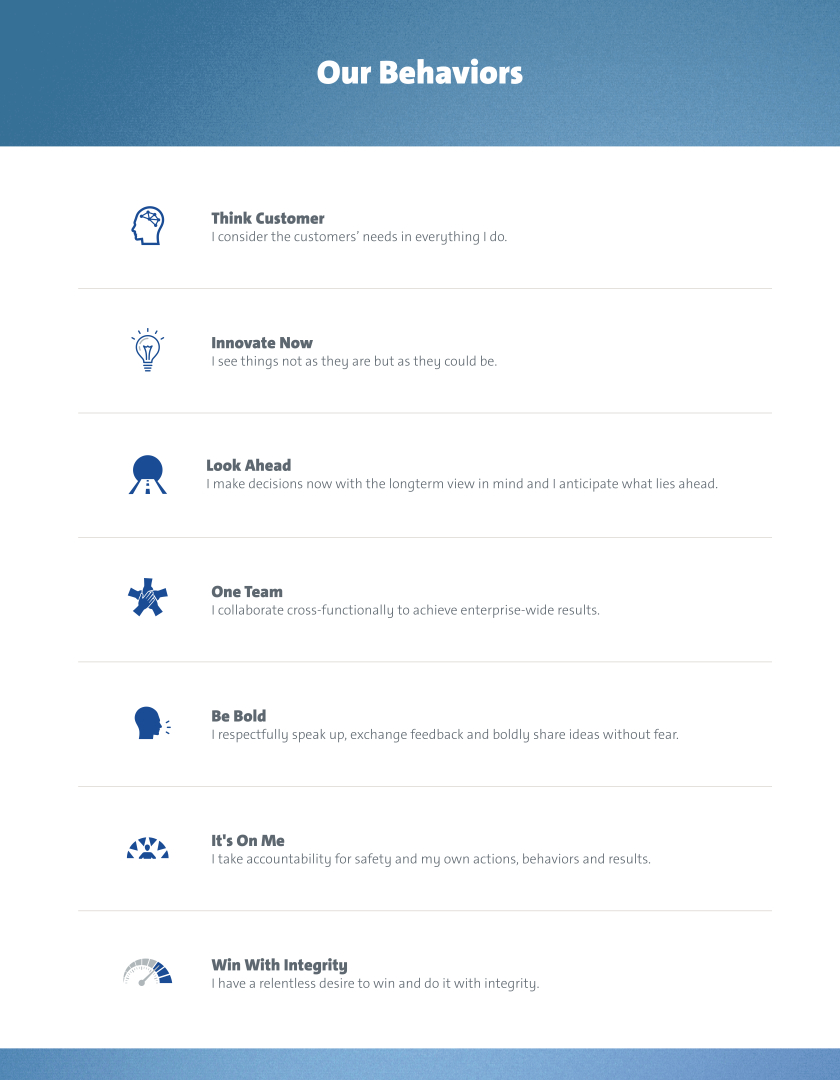
GENERAL MOTORS COMPANY GENERAL MOTORS GLOBAL HEADQUARTERS MAIL CODE 300 RENAISSANCE CENTER DETROIT, MI 48265 |
VOTE BY INTERNET Before The Meeting- Go towww.proxyvote.com or scan the QR Use the
| |
During The Meeting- Go toGM.onlineshareholdermeeting.com You may attend the meeting via the internet and vote during the meeting. Have the information that is printed in the box marked by the arrow available and follow the instructions. VOTE BY TELEPHONE - 1-800-690-6903 Use any touch-tone telephone to transmit your voting instructions up until 11:59 p.m. Eastern Time on Monday, June
| ||
If you vote by
VOTE BY MAIL Mark, sign, and date this proxy card and promptly return it in the enclosed postage-paid envelope or return it to: Vote Processing, c/o Broadridge, 51 Mercedes Way, Edgewood, NY 11717.
| ||
|
TO VOTE, MARK BLOCKS BELOW IN BLUE OR BLACK INK AS FOLLOWS: | ||||
E44393-P05180E74319-P16865 KEEP THIS PORTION FOR YOUR RECORDS
— — — — — — — — — — — — — — — — — — — — — — — — — — — — — — — — — — — — — — — — — — — — — — — — — — — — —
| DETACH AND RETURN THIS PORTION ONLY | ||||
| THIS PROXY CARD IS VALID ONLY WHEN SIGNED AND DATED. | ||||
GENERAL MOTORS COMPANY
| ||||||||||||||||||||||||||||||||||||||||||||||
If you wish to vote in accordance with the Board of Directors’ recommendations, you need only sign, date, and return this proxy card. The Board of Directors recommends a voteFOR ALL Board nominees listed in Item 1. | ||||||||||||||||||||||||||||||||||||||||||||||
| 1. | Election of | |||||||||||||||||||||||||||||||||||||||||||||
| For | Against | Abstain | ||||||||||||||||||||||||||||||||||||||||||||
Nominees:
| ||||||||||||||||||||||||||||||||||||||||||||||
1a. Mary T. Barra
1b. Wesley G. Bush 1c. Linda R. Gooden
| ☐
☐
☐
☐
| ☐
☐
☐
☐
| ☐
☐
☐
☐
| The Board of Directors recommends a voteFOR Board Items 2 and 3.
2. Advisory Approval of
3. Ratification of the Selection of Ernst & Young LLP as GM’s Independent Registered Public Accounting Firm for | For
☐ ☐ |
| Against
☐
☐ |
|
| Abstain
☐
☐ |
| |||||||||||||||||||||||||||||||||||
1e.
1f.
1g. Patricia F. Russo
1h. Thomas M. Schoewe
1i. Theodore M. Solso
1j. Carol M. Stephenson
1k. Devin N. Wenig | ☐
☐
☐
☐
☐
☐
☐ | ☐
☐
☐
☐
☐
☐
☐ | ☐
☐
☐
☐
☐
☐
☐ | The Board of Directors recommends a voteAGAINSTshareholder Items 4
4. Shareholder Proposal Regarding Independent Board Chairman
5. Shareholder Proposal Regarding
| For
☐
☐
|
| Against
☐
☐
|
|
| Abstain
☐
☐
|
| |||||||||||||||||||||||||||||||||||
NOTE:Please sign exactly as your name(s) appear(s) hereon. When shares are held jointly, each holder should sign. When signing as attorney, executor, administrator, guardian, trustee, custodian, or in any other representative capacity, give full title as such. Corporations should provide the full name of corporation and name and title of the authorized officer signing the proxy card. |
| |||||||||||||||||||||||||||||||||||||||||||||
| Signature [PLEASE SIGN WITHIN BOX] | Date | Signature (Joint Owners) |
| Date | ||||||||||||||||||||||||||||||||||||||||||||||
Important Notice Regarding the Availability of Proxy Materials for the Annual Meeting:
The Proxy Statement, Notice of 20182019 Annual Meeting of Shareholders and Annual Report
are available atwww.proxyvote.com.
Meeting Information Meeting Type: Annual Meeting For holders as of: April 8, 2019 Date:June 4, 2019 Time:8:00 a.m. Eastern Time Location: Meeting live via the internet only - please visit GM.onlineshareholdermeeting.com. The company will be hosting the meeting live via the internet only this year. To attend the meeting via the internet please visit GM.onlineshareholdermeeting.com and be sure to have the information that is printed in the box marked by the arrow |
PLEASE VOTE TODAY!
SEE REVERSE SIDE FOR THREE EASY WAYS TO VOTE
— — — — — — — — — — — — — — — — — — — — — — — — — — — — — — — — — — — — — — — — — — — — — — — — — — — — —
E44394-P05180
E74320-P16865
G E N E R A L M O T O R S

THIS PROXY IS SOLICITED ON BEHALF OF THE BOARD OF DIRECTORS
The undersigned shareholder(s) of General Motors Company authorize(s) Mary T. Barra Daniel Ammann, and Charles K. Stevens, III,Craig B. Glidden, and eacheither of them, as proxies with full power of substitution, to vote the common stock of the undersigned in the manner specified on this proxy card and in their discretion upon all other matters (including on the election of any nominees for director that are not identified on this proxy) that may come before the 20182019 Annual Meeting of Shareholders of General Motors Company, to be held at 9:308:00 a.m. Eastern Time on June 12, 20184, 2019, or any adjournment or postponement thereof. The undersigned hereby revokes all proxies previously given.
On matters for which you do not specify a choice, the shares will be voted in accordance with the recommendation of the Board of Directors; therefore, if no direction is made, this proxy will be votedFORALL of General Motors Company’s director nominees in Item 1; FOR Items 2 and 3; and AGAINST Items 4 through 6.and 5.
YOUR VOTE IS VERY IMPORTANT - PLEASE VOTE TODAY
Please see the reverse side for Internet,internet, mail, and telephone and in person voting instructions.
(Continued and to be marked, signed, and dated on the reverse side)